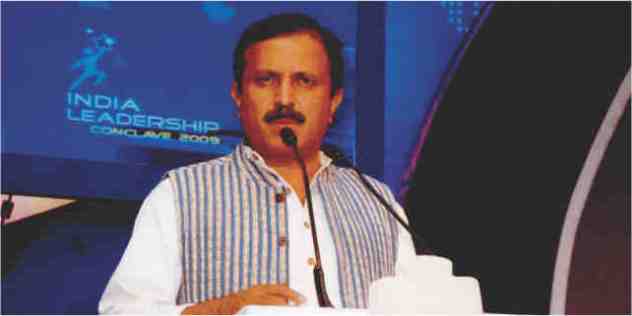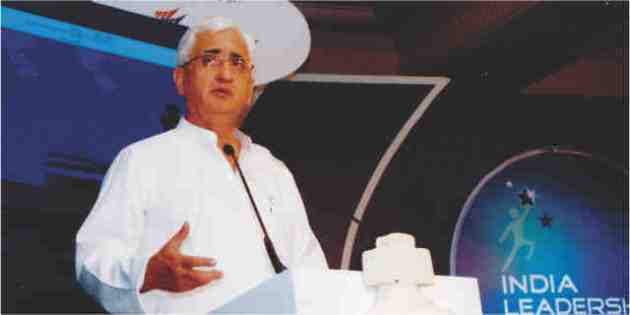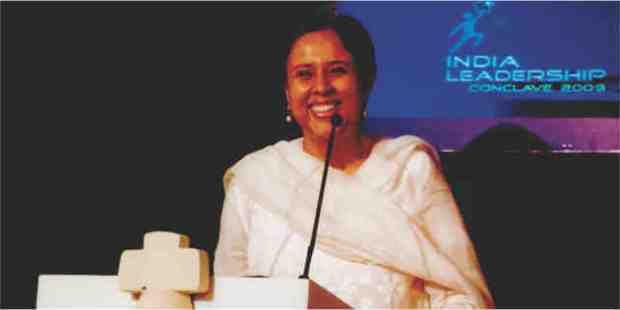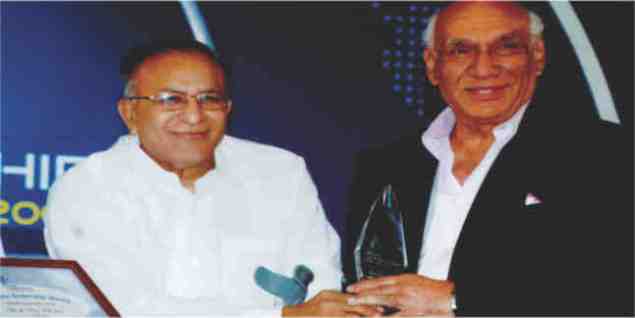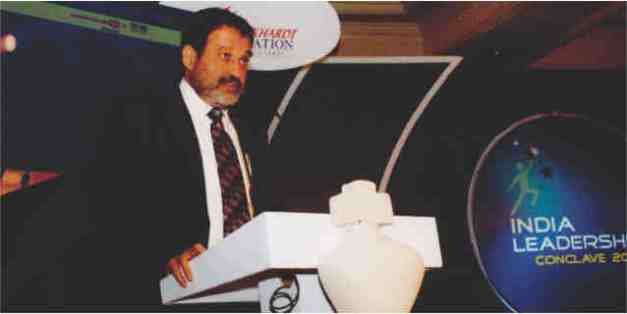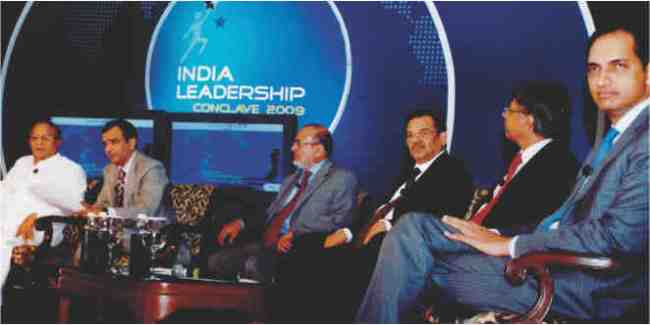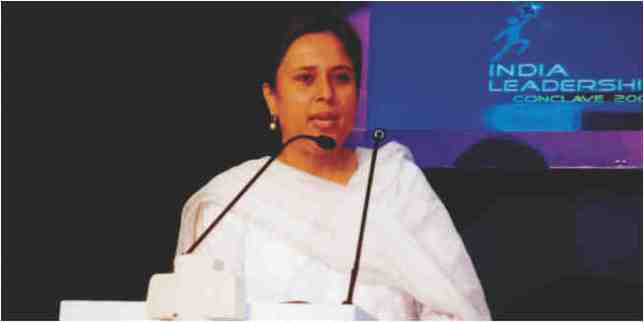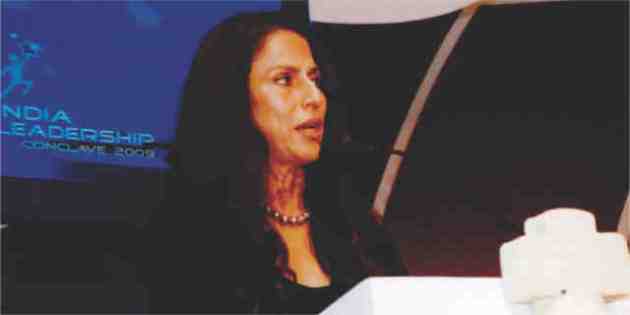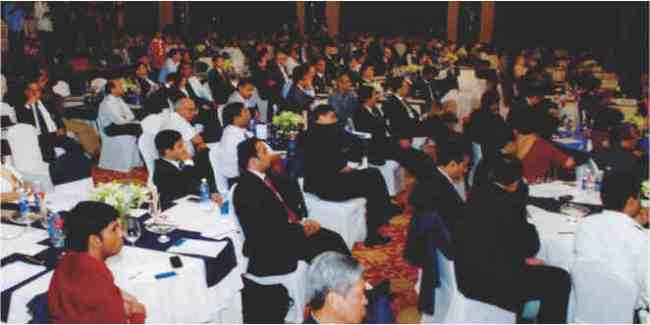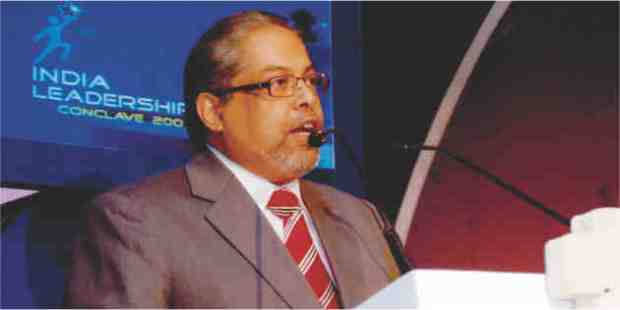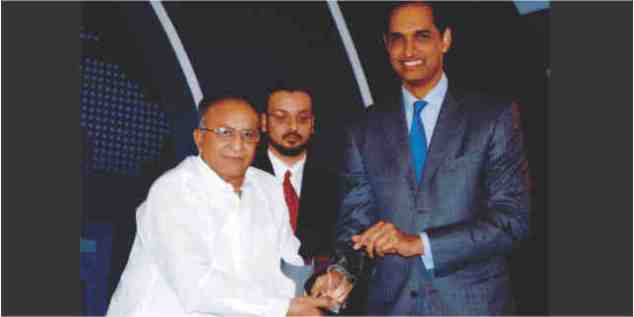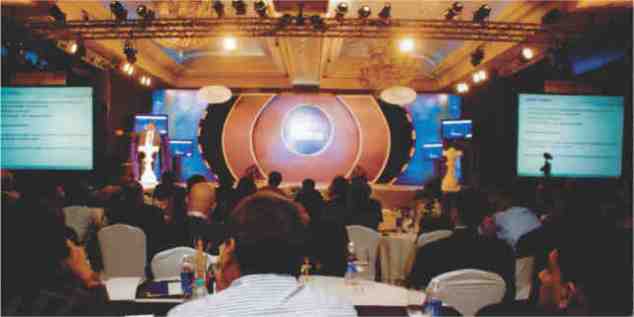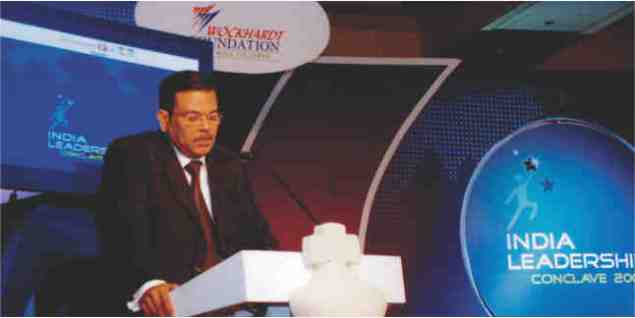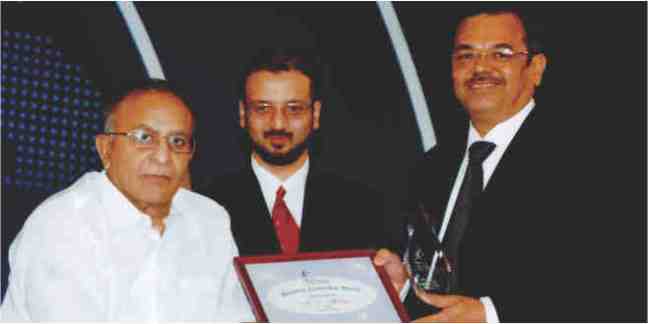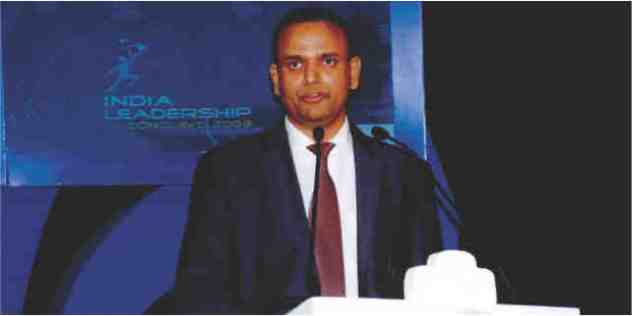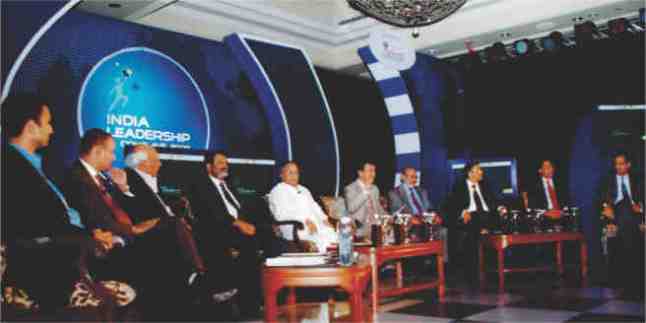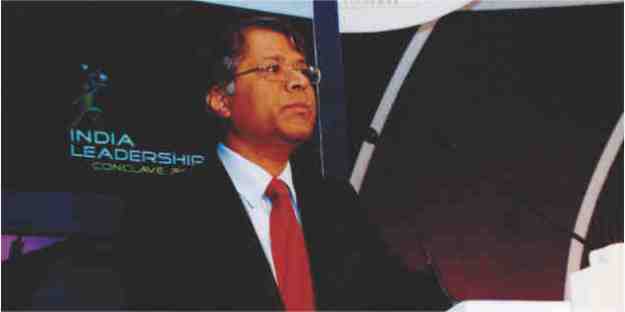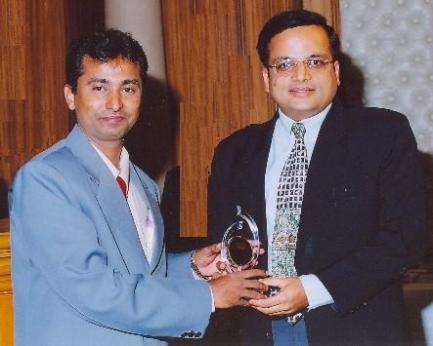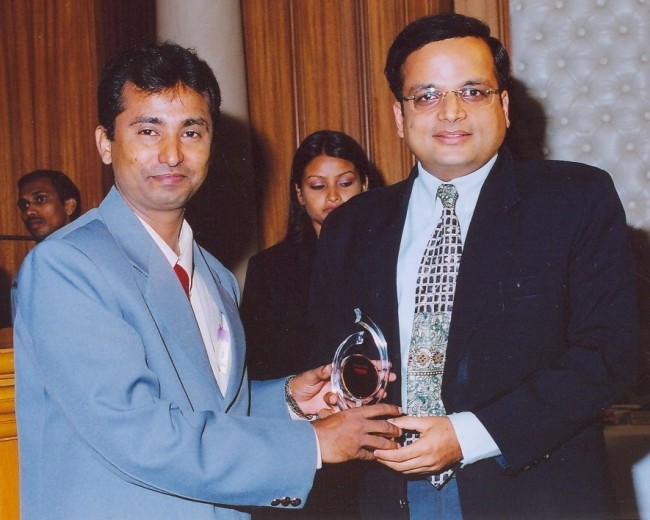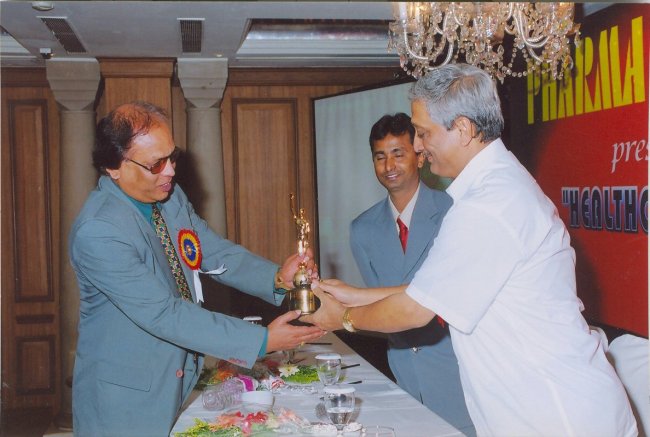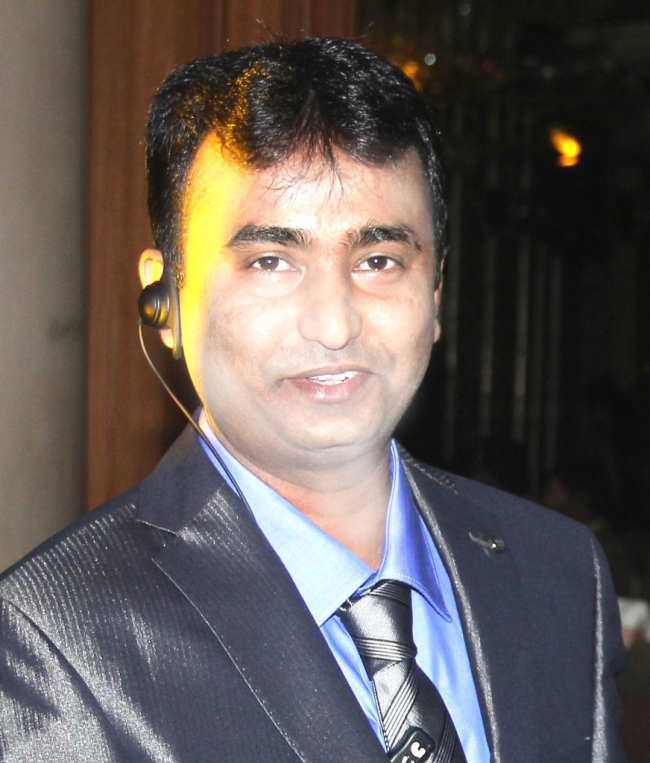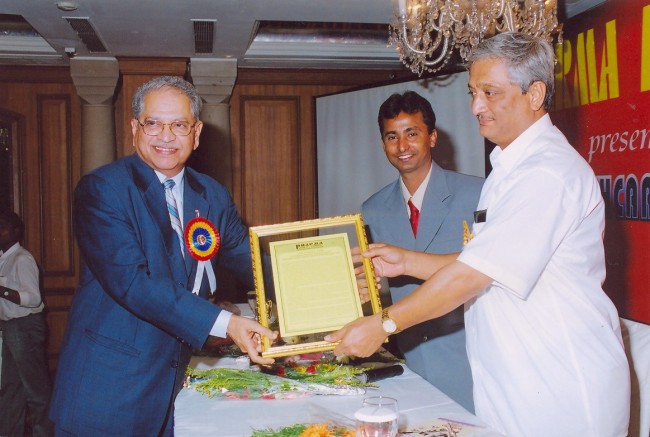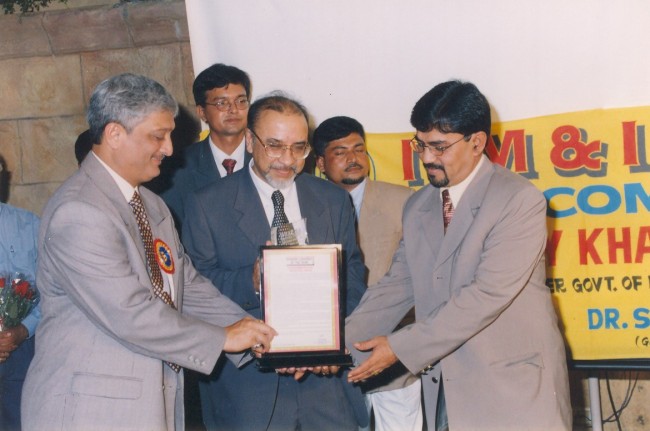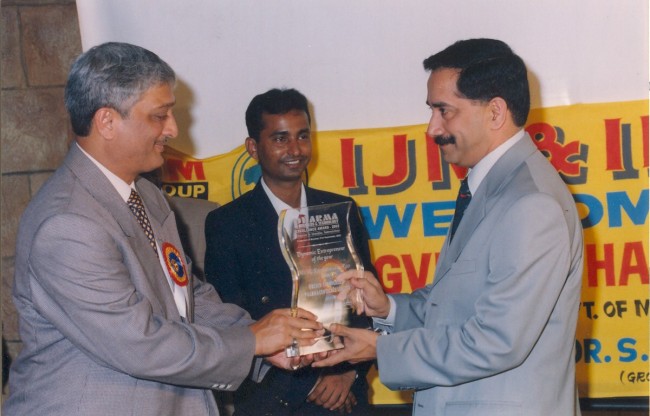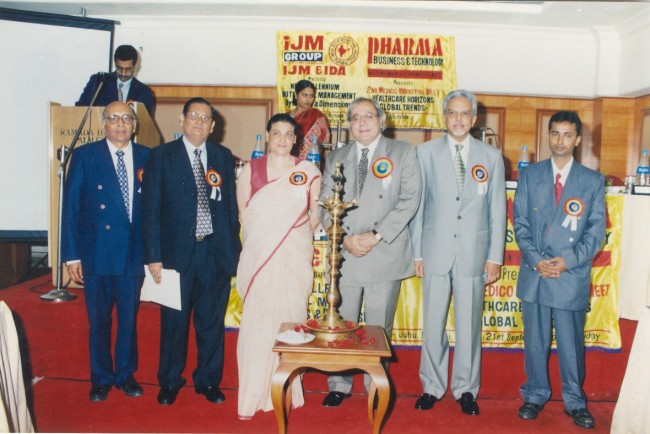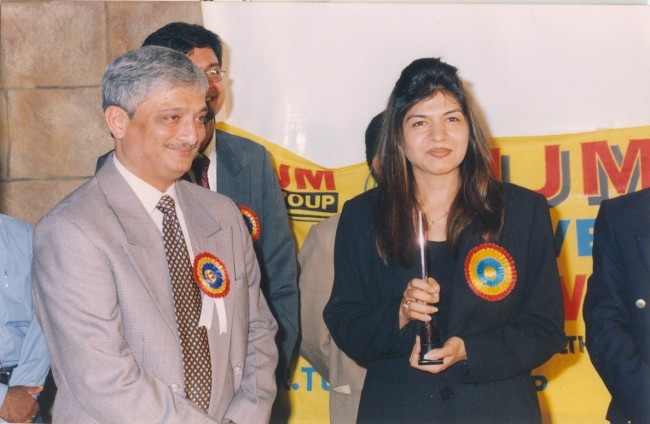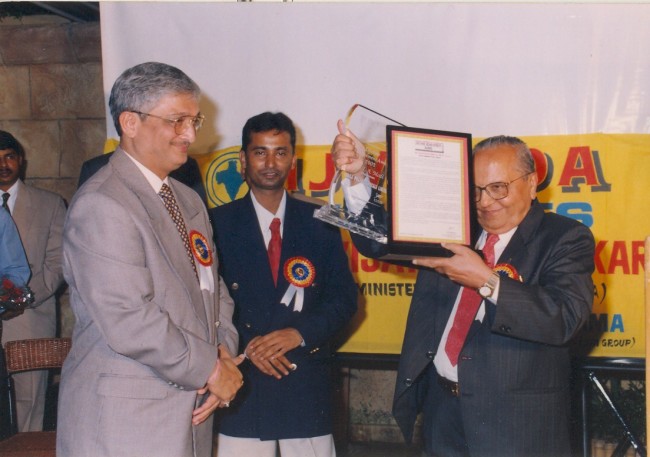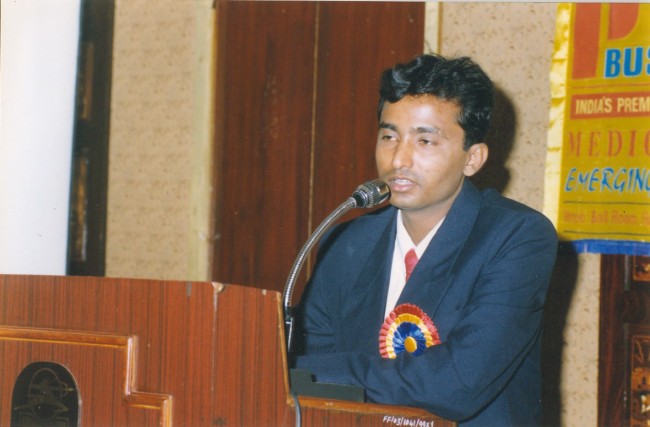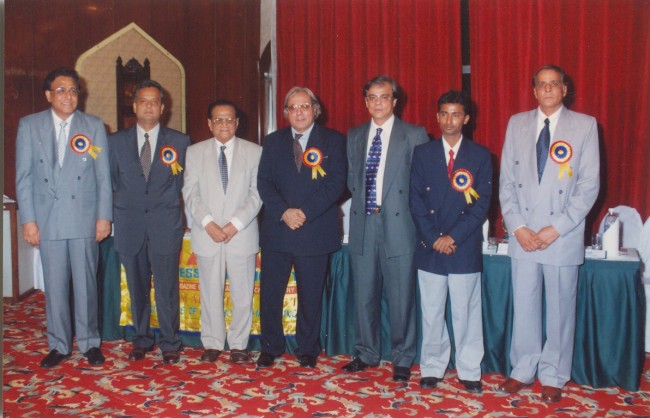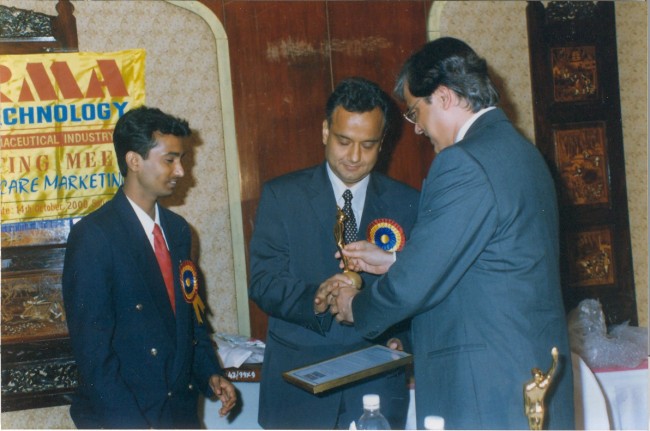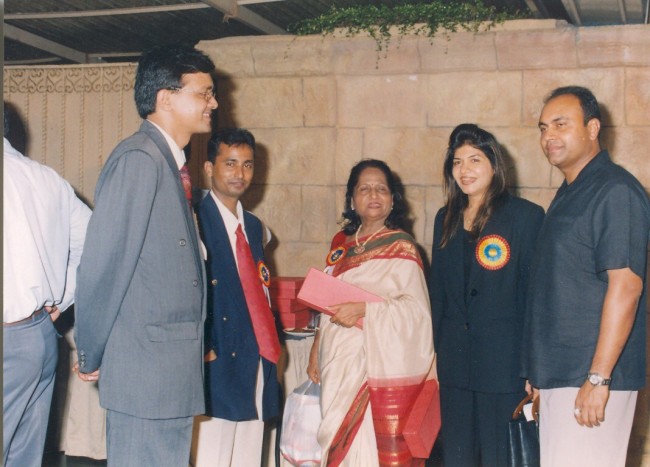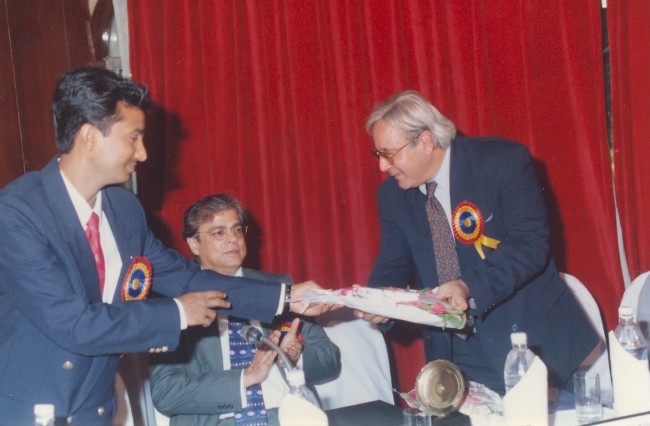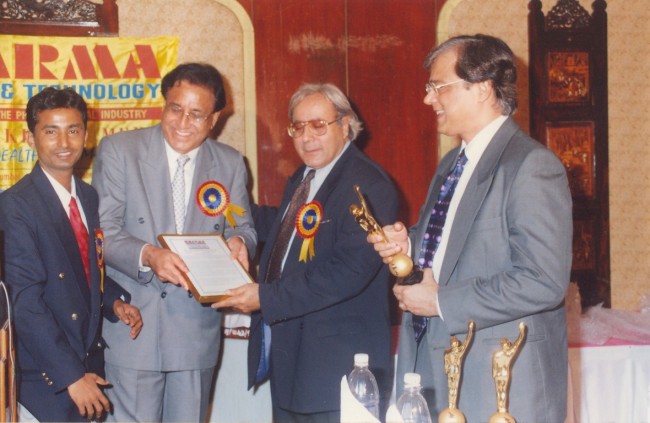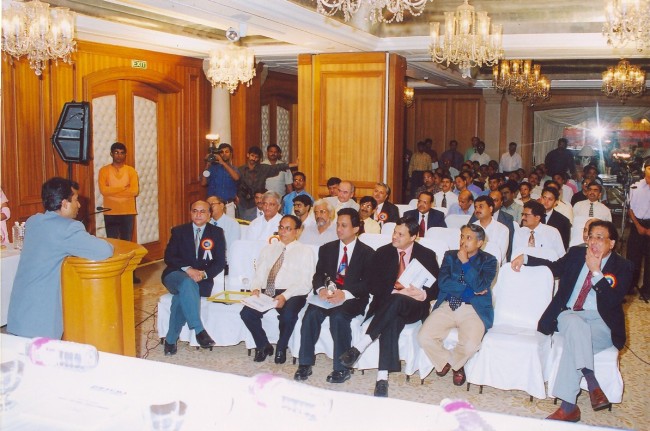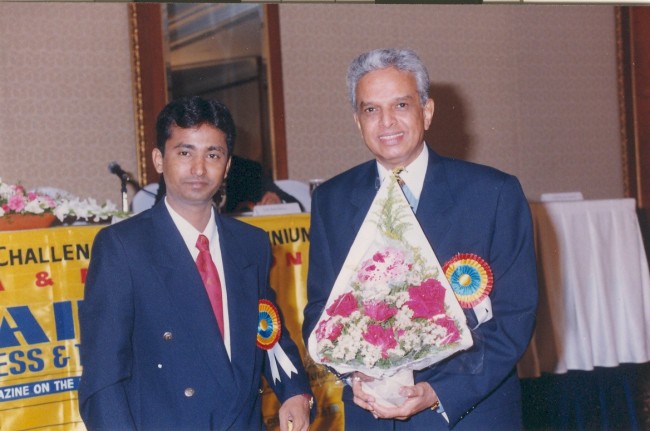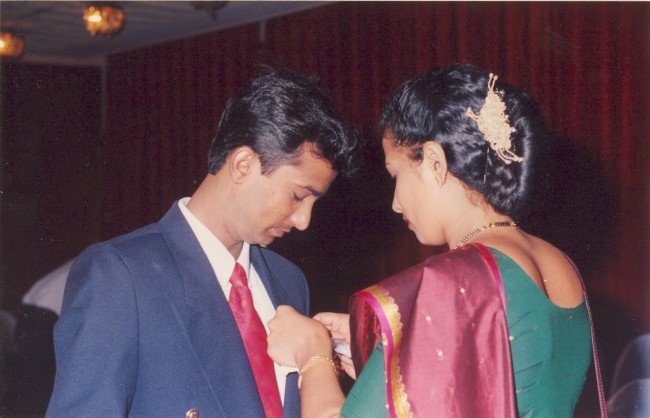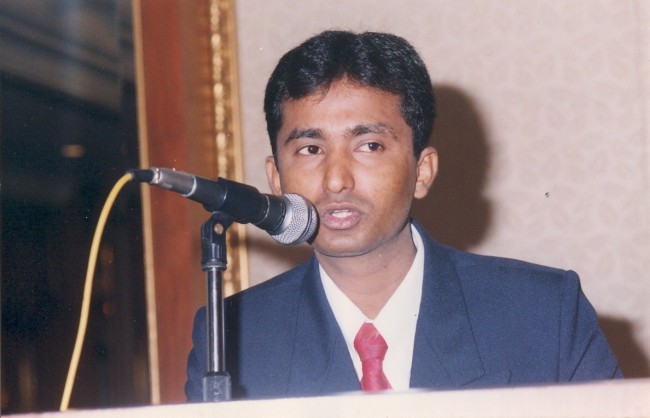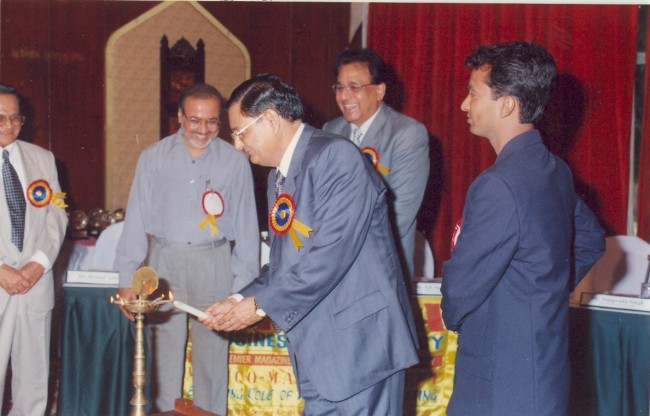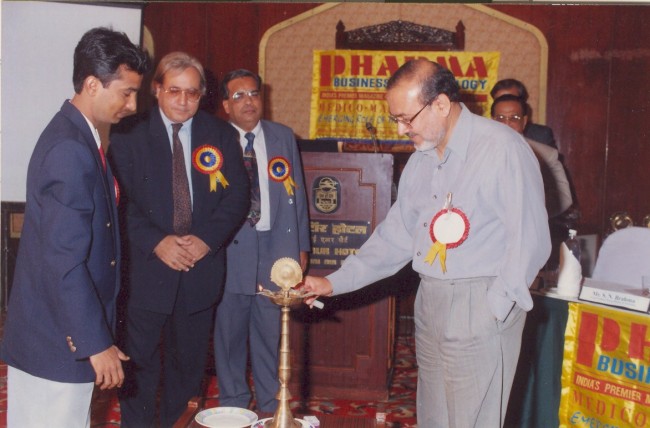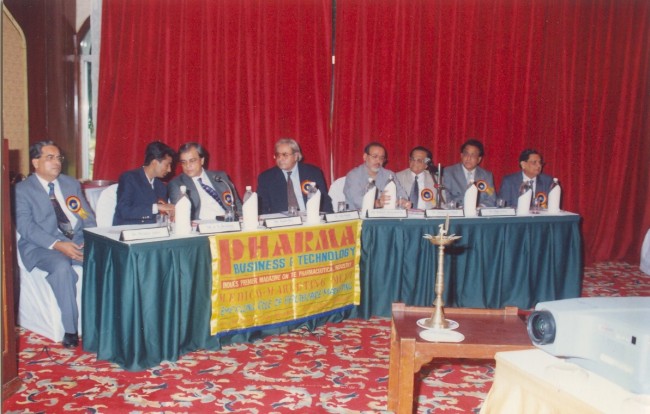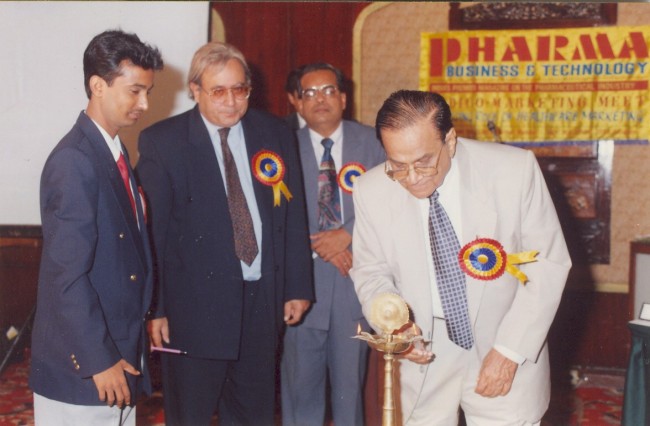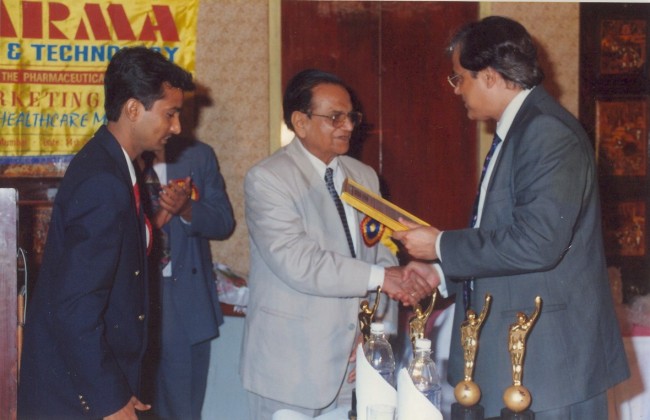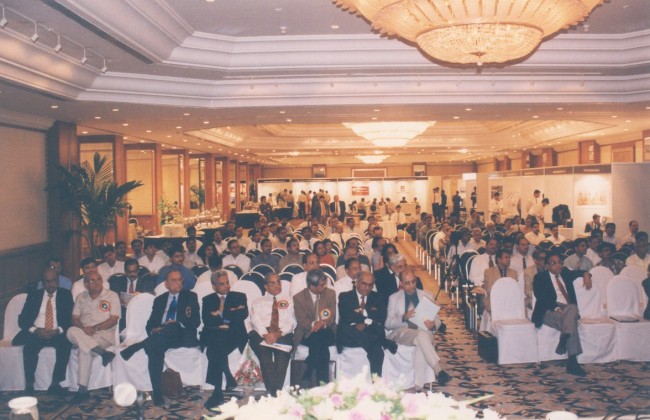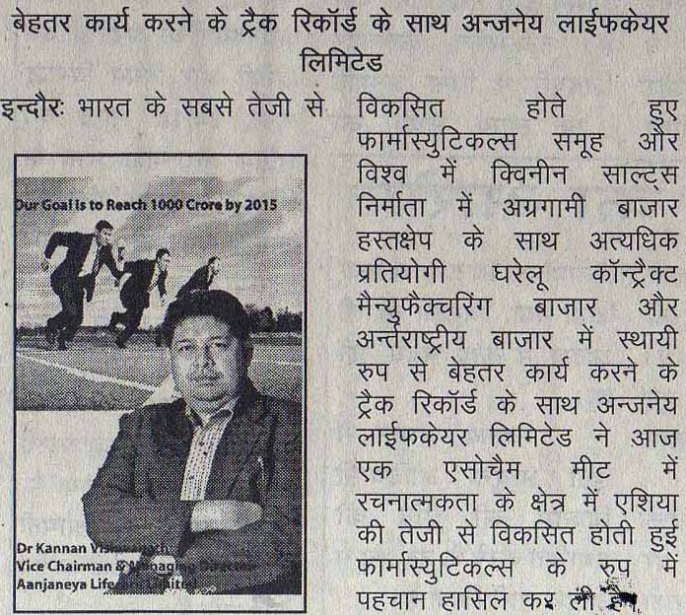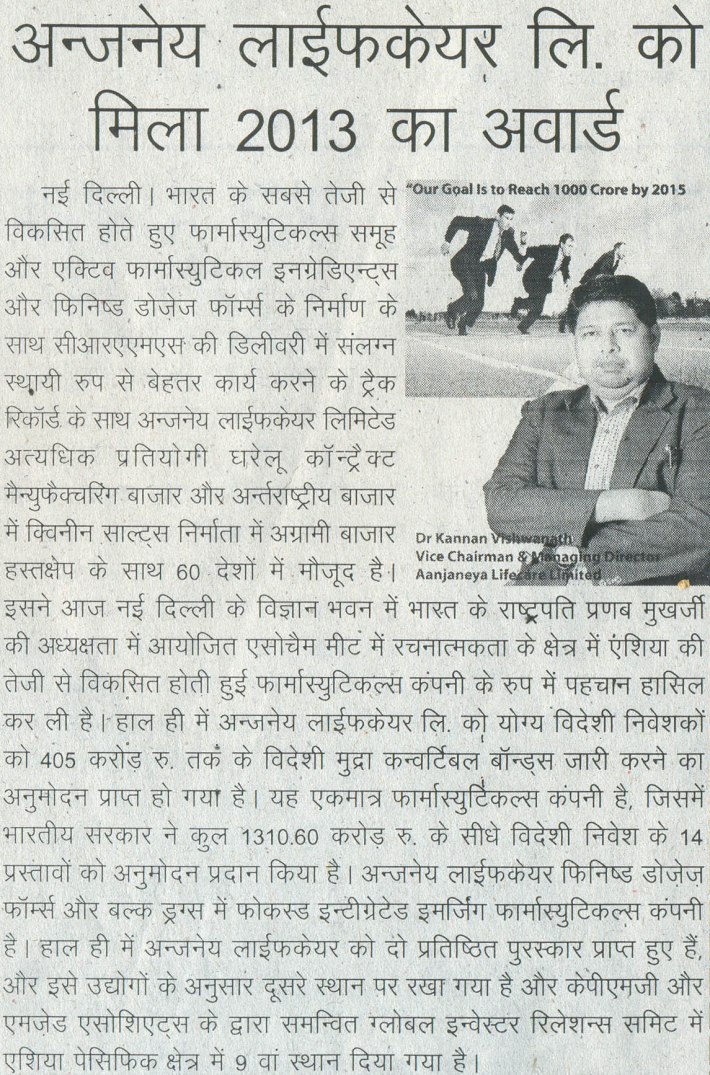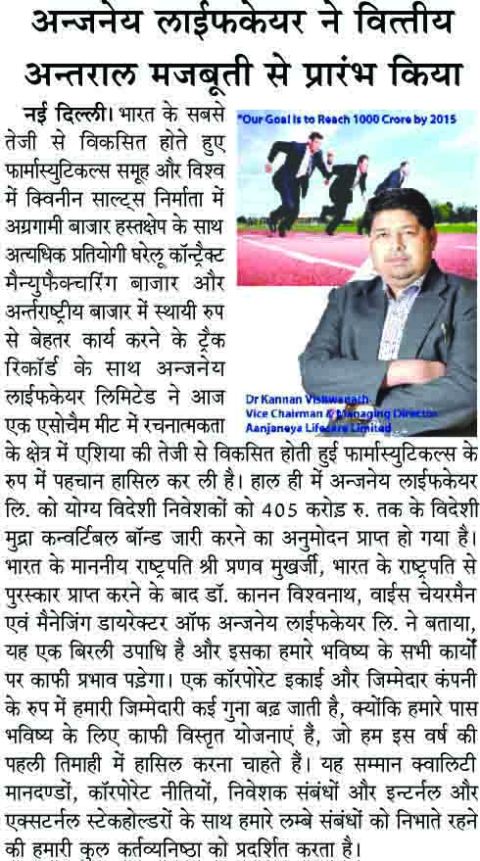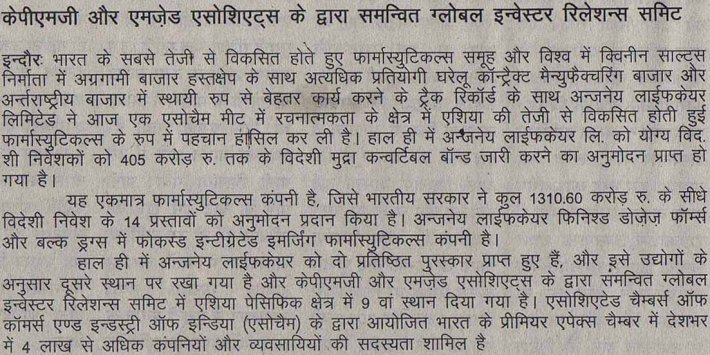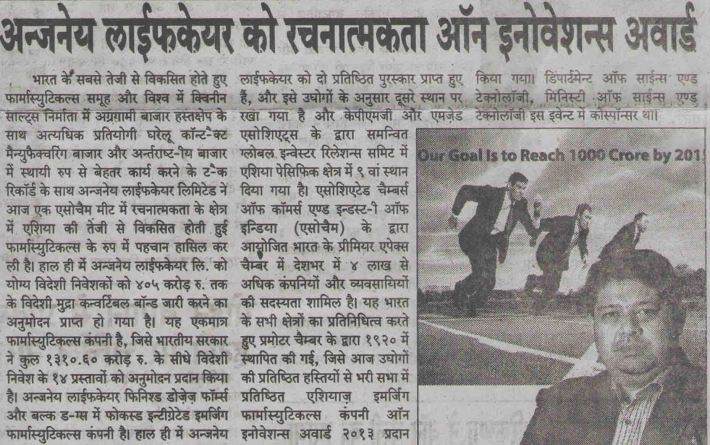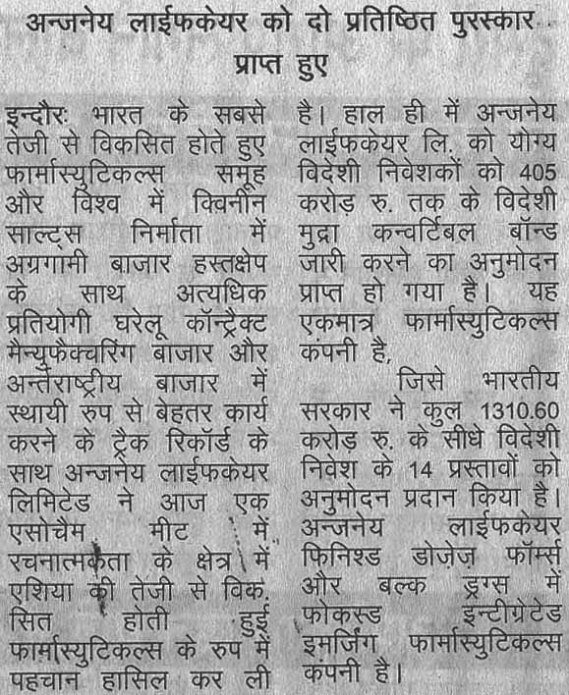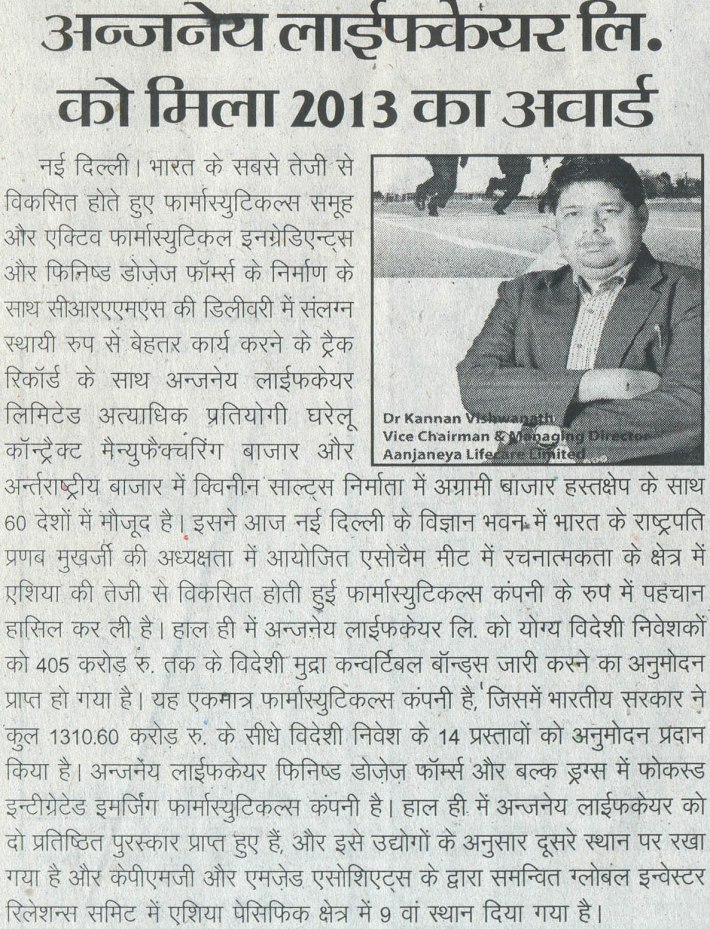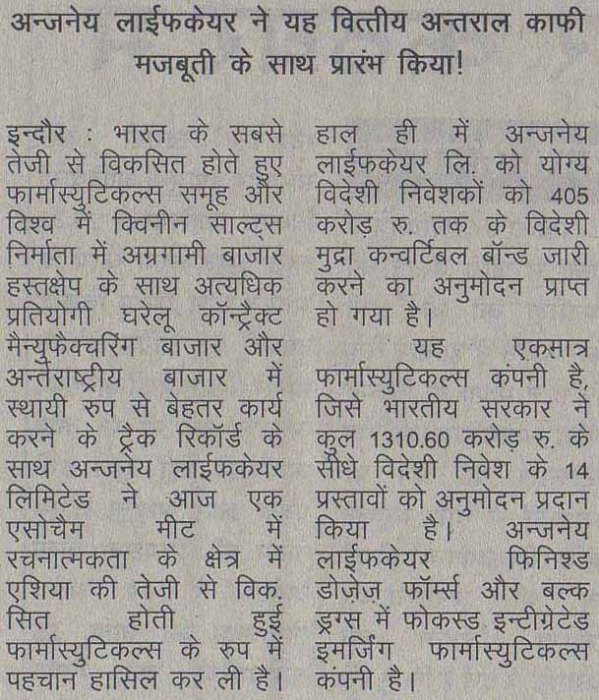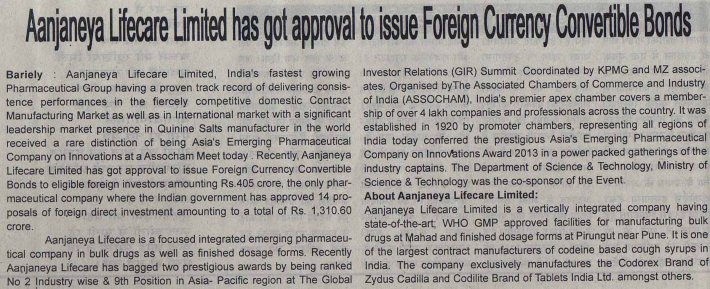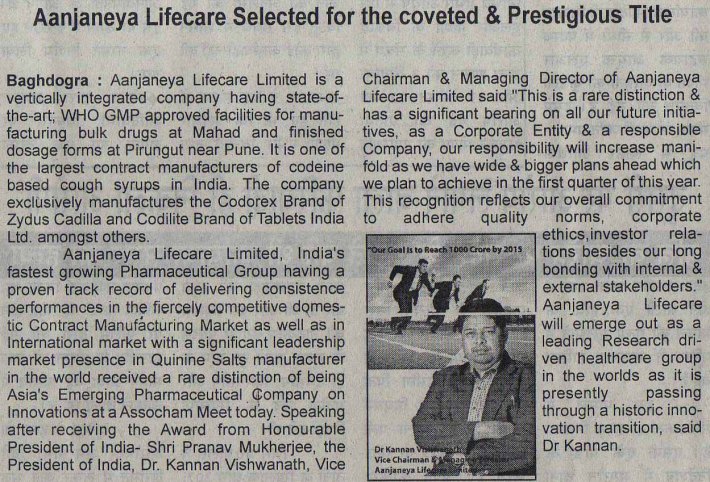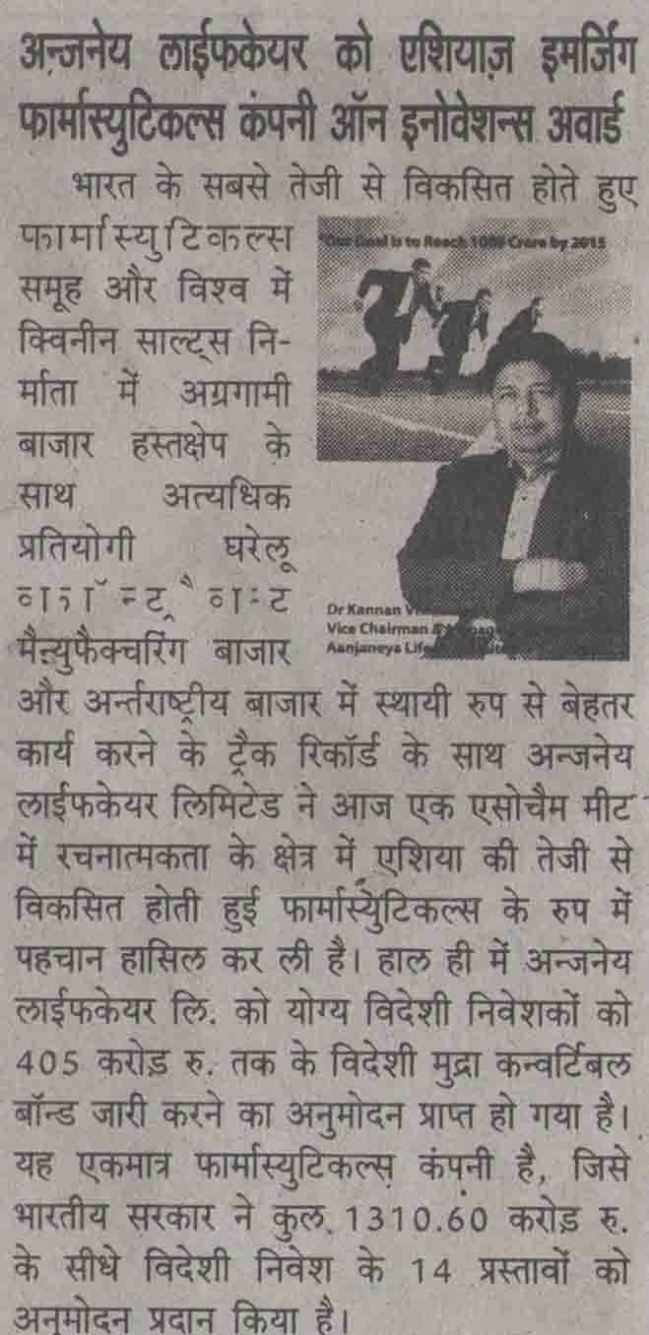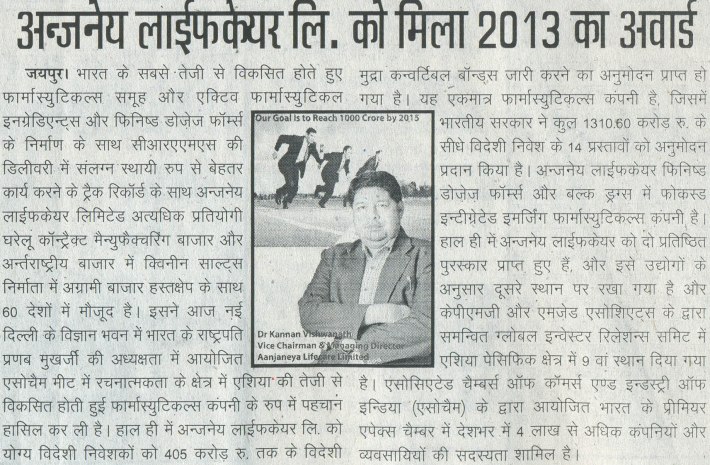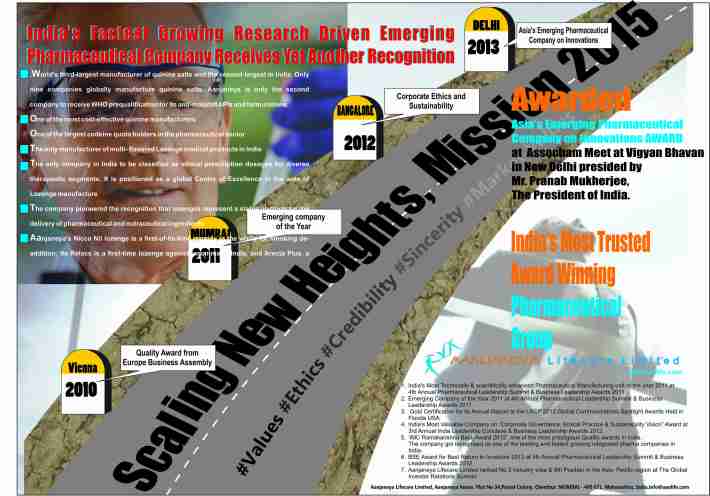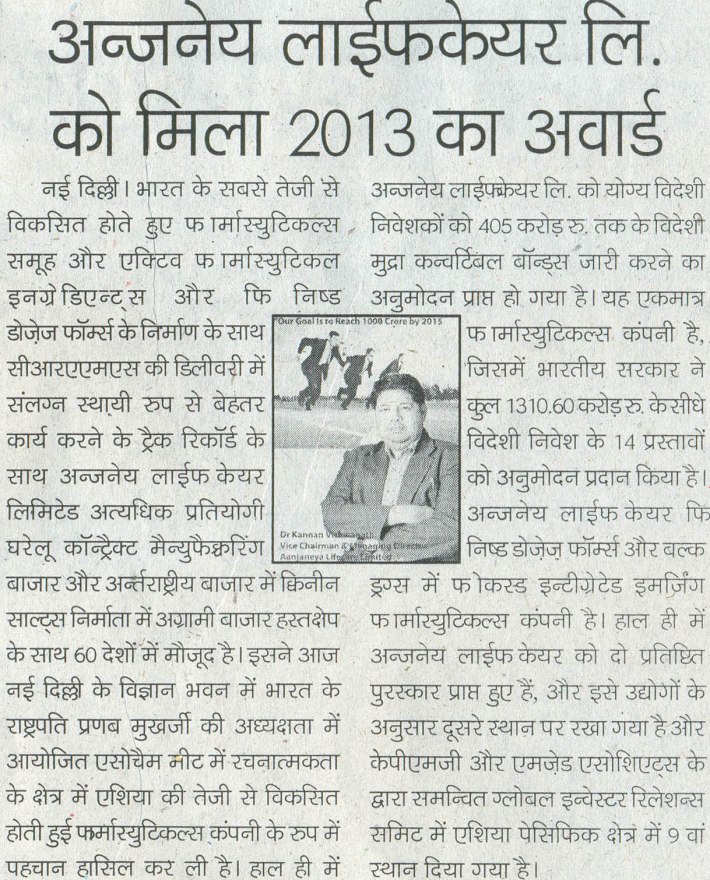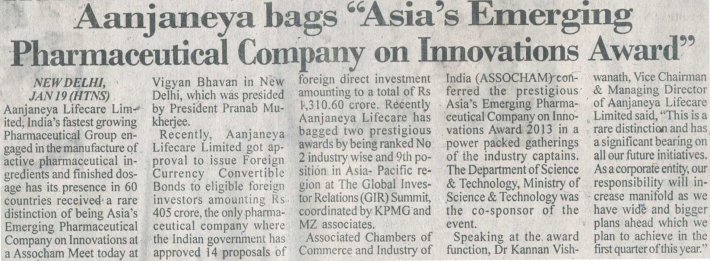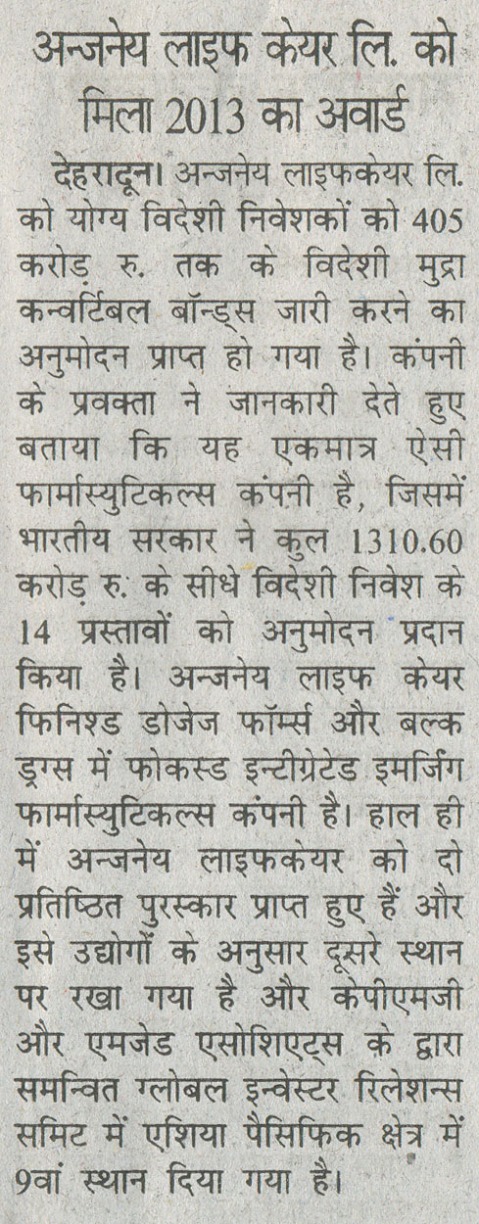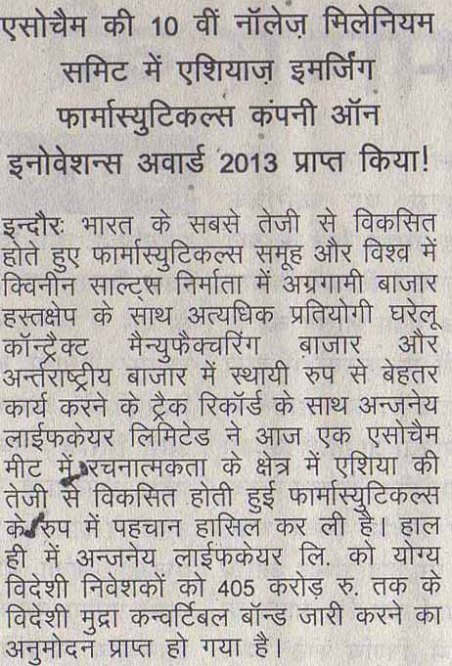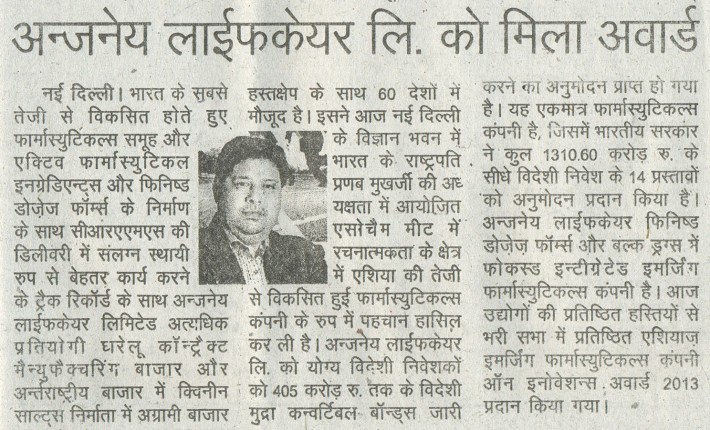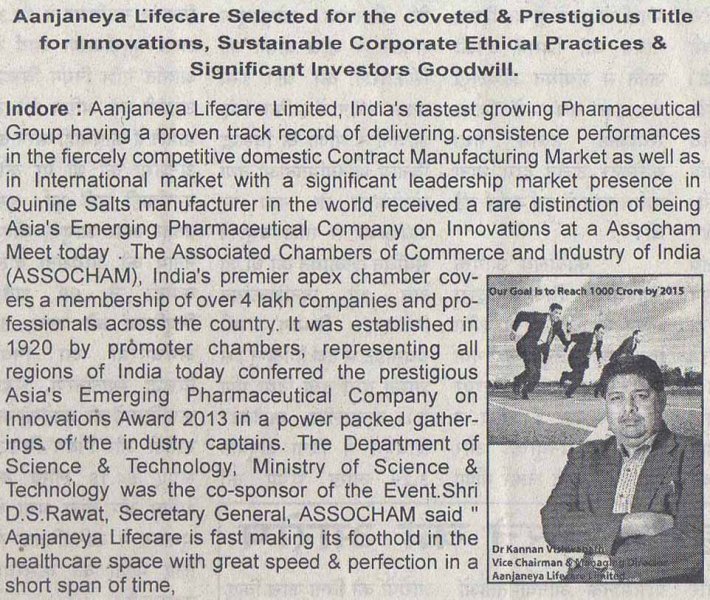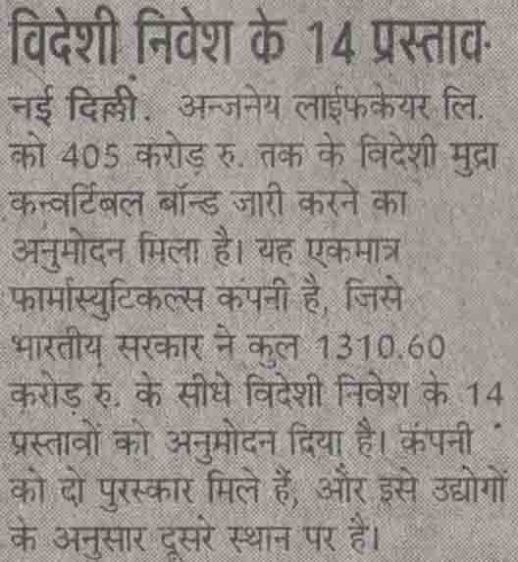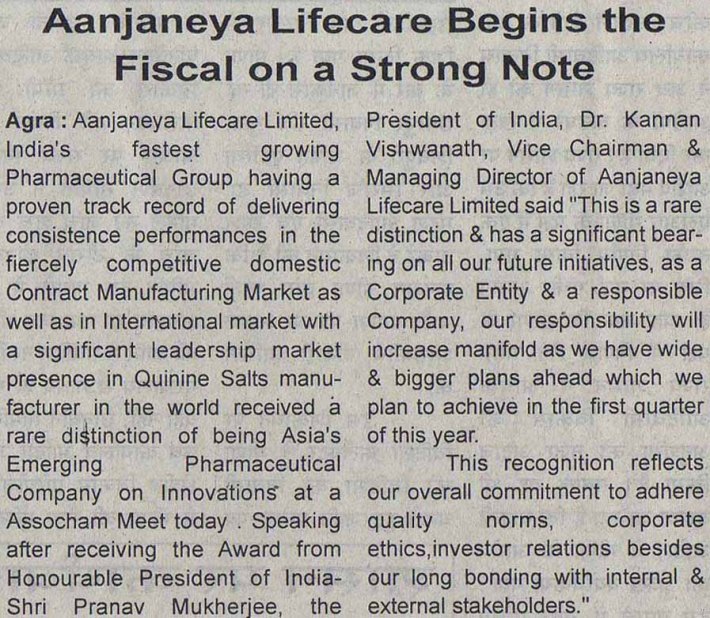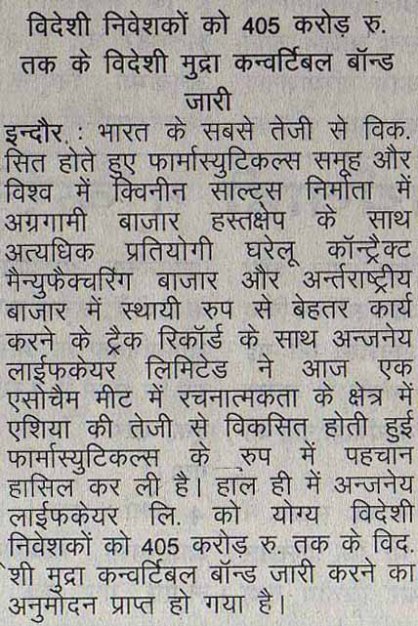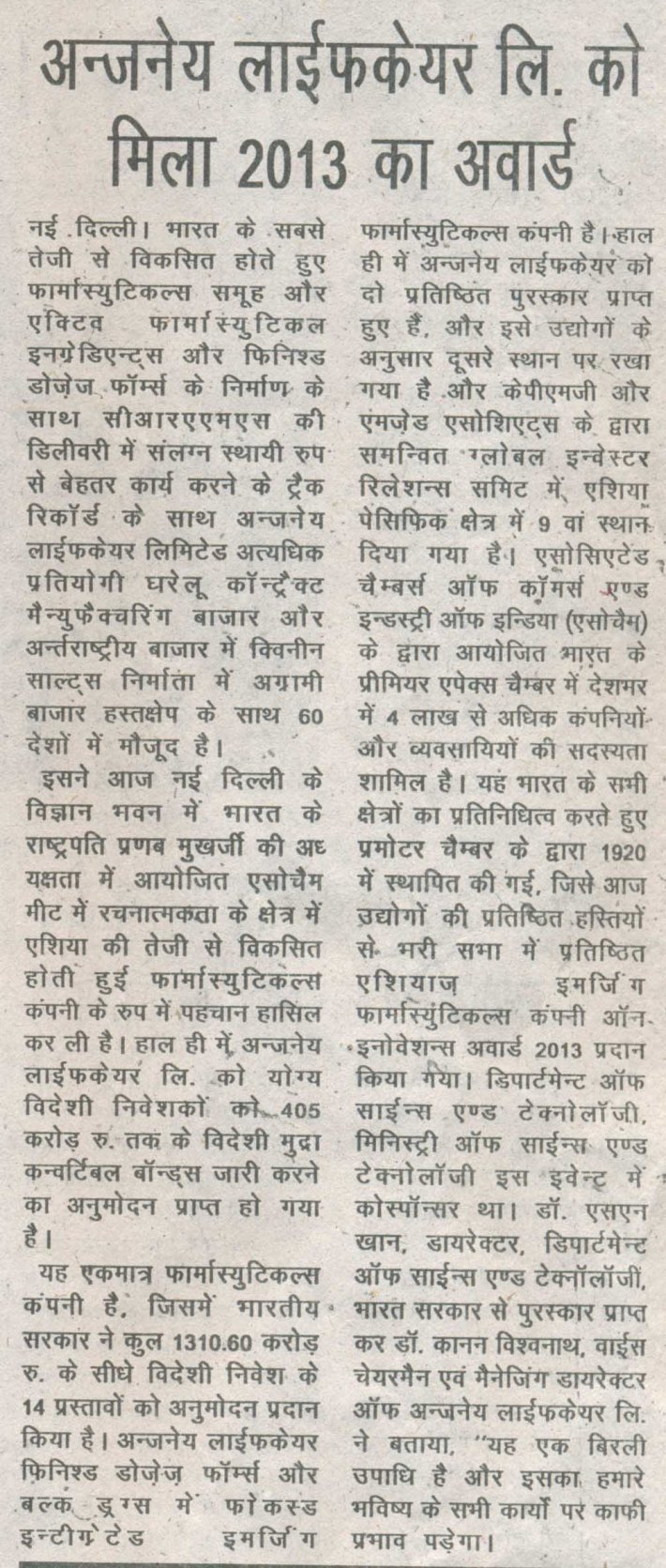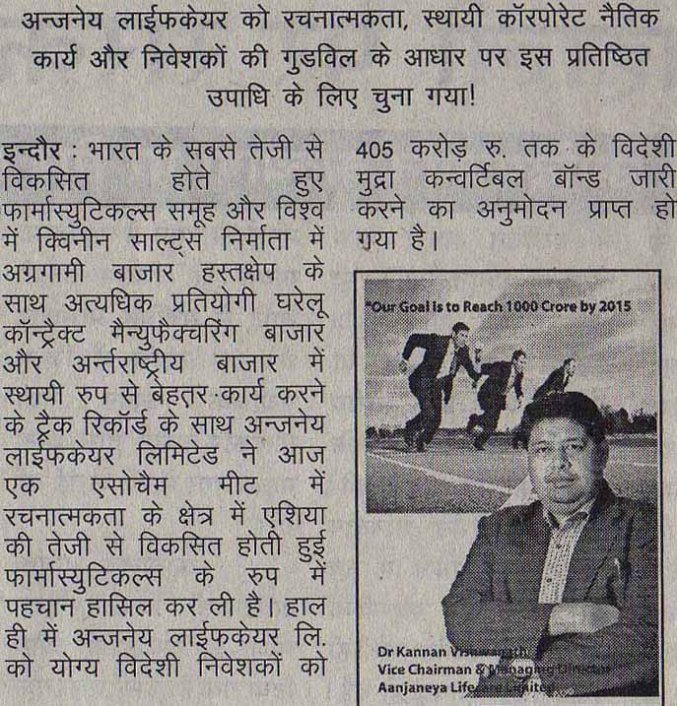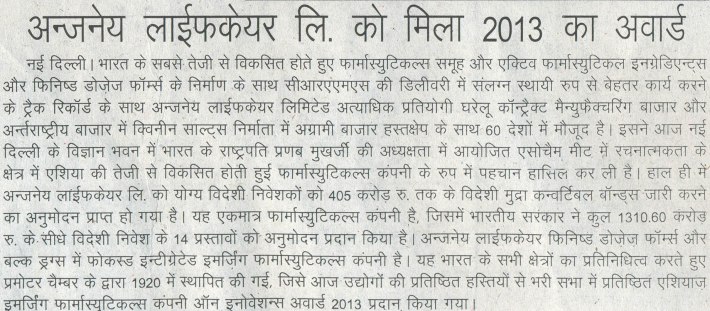i
EXECUTIVE SUMMARY
The Indian pharmaceutical Industry has witnessed a robust growth of around 14% since
the beginning of the 11
th
Plan in 2007 from about Rs 71000 crores to over Rs1 lac crores
in 2009‐10 comprising some Rs62,055 crores of domestic market and exports of over Rs
42,154 crores. This also amounts to around 20% of total volume of global generics.
However, the Industry is quite fragmented and comprises of nearly 10,500 units with
majority of them in unorganized sector. Of these, about 300‐400 units are categorized as
belonging to medium to large organized sector with the top 10 manufacturers accounting
for 36.5% of the market share. As regards the Bulk drugs component of the industry, the
market is around Rs 42,000crores giving it a share of around 50% of the total domestic
market. This gives the Indian Bulk Drug industry a share of about 9% of the global bulk
drug market.
India is among the top 20 pharmaceutical exporting countries and the exports have
grown very significantly at a CAGR of around 19% in the 11
th
plan period. Indian drugs
are exported to around 200 countries in the world with highly regulated markets of USA,
UK etc. The major therapeutic categories of export are anti infective, anti asthmatic and
anti hypertensive.
The Department of Pharmaceuticals has a Vision for the development of the Indian
Pharmaceutical Industry. This Vision is –
“To make India the Largest Global Provider of Quality Medicines at Reasonable Prices.”
The Vision is to be achieved as per the following Mission:
• Develop Human Resources for Pharmaceutical Industry and Drug Research and
Development
• Promote Public‐Private Partnership for development of pharmaceuticals Industry
• Promote Pharma Brand India through International Cooperation
• Promote environmentally sustainable development of Pharmaceutical Industry
• Enable availability, accessibility and affordability of drugs ii
In order to realise the Mission, the Department has set the following Goals for 12
th
plan:
• Production size of US$60bn and export size of over US$25bn.
• Upgradation of SMEs to WHO‐GMP and training of professionals therein.
• Establishment of Pharma Growth Clusters.
• Facilitate growth of Central pharma PSUs.
• Develop Pharma Infrastructure and Catalyze Drug Discovery and Innovation
• Develop Pharma Human Resources through increased M.Pharma and Ph.D
programs in NIPERS
• Provide Infrastructure and staff for new NIPERs and strengthen NIPER Mohali
• Open 10 new NIPERs
• Jan Aushadi Campaign and implementation of Business Plan for setting up of 3000
Jan Aushadhi Stores (upto Subdivision level in the country)
• Incentivizing Private Sector for development of new Drugs for diseases endemic
to India
For the achievement of these Goals, it is necessary for the Indian Pharmaceutical Industry
to become globally competitive through world class manufacturing capabilities with
quality and cost efficiency of production capacity and radical upgradation of research and
development capabilities for new drugs and associated activities like clinical trials and
contract manufacturing. There is need to develop world class support infrastructure
both for production and research.
With this approach, the preparation of the 12
th
Plan involved a detailed SWOT analysis of
the Indian Pharmaceuticals Industry. This analysis has revealed the following strengths:
(a) Strong Low cost manufacturing sector (b) Significant breadth and depth of product
expertise (c) Low cost of growing Human resources in the Pharma sector. The major
weaknesses are – (a) High emphasis on generics both for domestic and international
markets where filing and approval of ANDAs and DMFs have left little room for R&D on
drugs development (b) Inadequate R&D Infrastructure (c) Poor Industry‐Academia
linkage (d) Lack of required high‐end product development capable human resources (e)
Lack of time driven regulatory infrastructure (f) Poor SME base for high‐end manufacture.
The major opportunities available are ‐ (a) Global opportunity for increasing Generics andiii
bio‐generics market both in developed and emerging countries due to pressure on
budgetary limitations of these countries as well as emergent patent cliff due to off‐
patenting of major high‐value drugs (c) Low cost good skill destination for contract
research and manufacturing and resultant opportunities in drug discovery as well as
clinical trials (d) High growth of domestic market attracting multi‐nationals both for
brown field and green field investments in production and capacity building. The threats
to the industry are from ‐ (a) Ever‐greening strategy of MNCs for denying and limiting the
patent cliff opportunities with debatable recourse to TRIPs and FTAs (b) Increasingly
stringent regulatory and non‐tariff barriers to generics markets in developed countries (c)
Increased competition for generics and bio‐generics production in terms of high capacity
and production costs (d) High‐entry barriers to enable market share in development of
new drugs.
Based on the above SWOT analysis, recommendations have been made in the 12
th
Plan
Document for –
1) Development and growth of the Industry
2) Strengthening of R&D Capabilities
3) Strengthening of human resource base for Industry
4) Affordability and Access to Quality Drugs
The major recommendations concerning support for Industry growth are ‐ (a) Schemes
for Upgradation of SMEs to WHO‐GMP, USFDA/EDQM/TGA and other International
Standards (b) Support for new generics and bio‐generics through setting up of
Formulation Development Centers and Manufacturing Standards Training Centers (c)
Regional cluster‐based Industry development through establishment and upgradation of
10 Pharma Growth Area Clusters (d) Industry support to International market access
through capacity building and inter‐governmental cooperation. The Medical Device
Industry is also proposed to be supported through the development of a Medical Devices
Park in Ahmedabad, Gujarat. iv
In the area of R&D and human resource development the major recommendations
concern (a) setting up of National Excellence Centres comprising three for Research and
Development in Phyto‐pharmaceuticals, Nano‐Pharmaceuticals and Bio‐Similars, one for
setting up of National facilities for New Drugs Development along with another for End
To End Large‐Scale Animal House and setting up of a National Centre for R&D in APIs (b)
Schemes for supporting R&D in Industry through assistance for setting up of
GLP/GCP/Animal House Lab Schemes (c) Setting up of Pharma Venture Capital Fund to
fund innovations in drug discovery including incubator driven translational research (d)
Pharma Innovation and Infrastructure Development Initiative for R&D infrastructure
development including funding of private sector initiatives in PPP mode. Emphasis on
supporting extra mural research in development of new drugs and dosage forms for mass
affliction diseases like JE, Chikungunya, TB (resistant strains), leishmeinasis, malaria, and
the recent lifestyle diseases like diabetes and CVD, etc.
As regards strengthening of Human Resource base, it is estimated that direct
employment in Pharmaceuticals Industry has increased from about 6.9 lacs people in
2006 to 8 lacs people in 2008 with 20% of this manpower being engaged in research and
testing. The projected human resource requirement is around an estimated 21.5 lacs by
2020. Based on this it is proposed to fill the HR requirements through Schemes such as
(a) Expanding the student output at NIPER Mohali (b) Development of 6 New NIPERS
already sanctioned in the 11
th
Plan and (c) Setting up of 10 New NIPERs etc.
The 12
th
Plan Document highlights the vital role Drug price play in access to essential
medicines across the world. While it is a fact that the drugs manufactured in India are
considered to be amongst the lowest priced internationally, still, a vast section of Indian
population is not in a position to access the needed health care as well as the medicines
due to various reasons of access and affordability. Accordingly, the recommendations
made by the Task Force under Dr. Pronab Sen made have been considered and a draft
National Pharmaceuticals Pricing Policy has been formulated which seeks to control the
prices of essential drugs as per the National List of Essential Medicines 2011 (NLEM‐
2011). Further to this, the Department would take up issues pertaining to prescriptionv
and promotion of unbranded generic drugs with the Department of Health. Issues
related to pricing of patented medicines would also be suitably considered in the light of
need for promoting industry growth and research as well as development of new drugs
along with affordability of new patented medicines for better therapeutic treatment of
the masses, especially in diseases pertaining to cancer and HIV. Accordingly, it is
proposed to continue schemes for strengthening of the NPPA, for such functions as ‐ (a)
Strengthen Monitoring and Enforcement Work, (b) Building Consumer Awareness
about pricing and availability and (c) Creation of NPPA Cells in States, etc.
The present market size of Medical Devices and Equipments is around Rs 15,000 crores.
The medical device Industry in India is very nascent and is largely import dependent. More
than 65% of India’s requirement of medical devices and equipments are met through
imports with domestic production being largely restricted to low technology disposable
equipments. The SWOT analysis of Medical Device Industry shows that its major strengths
are – (a) Well developed Microelectronic, Telecommunication, Software and Precision
Engineering Industry, (b) Ability to attract foreign investments and (c) Ability to handle low
value large volume production as per global quality standards. The major weaknesses are –
(a) Low per capita expenditure on health care & low health insurance, (b) Lack of adequate
and trained manpower, (c) Lack of incubation and suitable ecosystem, (d) Lack of
regulation/standards etc. The major opportunities are‐ (a) Huge market potential ,(b)
Growing opportunities in export market, (c) Growing demand on account of changing
demographic profile, increasing incidences of life style diseases like cancer, CNS and
diabetics, etc. The major threats are – (a) Growing competition in export markets, (b)
Increasing dependency on imports, (c) Unorganized market for medical disposables, (d)
Lack of regulations in medical disposables and surgical items. To give a boost to the
Medical devices Sector, a number of schemes have been proposed such as for ‐ (a)
Setting up green‐field Medical Devices Park and (b) Setting up National Center for R&D in
Medical Devices at NIPER Ahmedabad
The 11
th
Plan aimed at making the sick CPSUs financially viable through support for
modernisation and rehabilitation as well as waiver of dues and payment of VRS packages. vi
Accordingly, Hindustan Antibiotics Ltd (HAL) and Bengal Chemicals and Pharmaceuticals
Ltd(BCPL) were given support of over Rs. 1000 crores in the 11
th
Plan period involving
waiver, settlement and cash assistance for modernisation. Karnataka Antibiotics and
Pharmaceuticals Ltd (KAPL) and Rajasthan Drugs and Pharmaceuticals Ltd(RDPL) were
also given financial support following their delinking from HAL and IDPL respectively so
as to make them individually more viable and independent in pursuing growth plans. As
a result, the Pharma PSUs have been able to achieve a combined business of more than
Rs. 600 crores. It is expected that they would grow in the 12
th
Plan for which
Government support for marketing will be required. Accordingly, no major scheme has
been proposed. The rehabilitation of Indian Drugs and Pharmaceuticals Ltd (IDPL) could
be considered during the 12
th
Plan as per approval of the Cabinet.
As regards access to quality drugs at affordable prices, apart from the price control and
monitoring initiative, the Government proposes to further expand the Jan Aushadhi
Scheme started in the 11
th
Plan with the objective of making available unbranded
generic medicines at affordable prices through the proposed 3000 dedicated outlets
across the country. The 12
th
Plan document has supported the revised business plan of
the Jan Aushadhi Scheme which has been prepared after a detailed analysis of shortfalls
and possible solutions including special focus on supply chain management.
Finally, the Department of Pharmaceuticals has not been able to take up or launch any
major new activity in line with its mandate even after three years of its existence. The
main reason for this lies in lack of technical capability since its inception. Therefore there
is an urgent need of strengthen the Department in terms of required human resources.
For this, support of a technical cadre has been proposed.
It is expected that going forward in the 12
th
Plan, the Department would be able to play a
vital catalytic role in spurring the growth of the pharmaceutical industry in the country
and strengthen it to become a global leader in the comity of nations in the global
economy.vii
SUMMARY OF SCHEMES
Sl No Scheme Brief description Budget (Rs
Crores)
1 INDUSTRY PROMOTION & DEVELOPMENT
1.1 Existing Schemes – Continued
from 11
th
Plan
(i) Pharma Promotion and
Development Scheme (PPDS)
Grant assistance for Industry Studies, Workshops,
Seminars, etc
10
(ii) Intellectual Property Rights
Facilitation Centers
Capacity building Grant assistance (capital and
revenue) for setting up of IPR centres by
Pharmaexcil, Industry bodies, etc to assist industry in
IPR matters
26.5
1.2 New Schemes
(i) International Pharma
Cooperation Initiative (IPCI)
Setting up of Joint testing and lab facilities for
certification of Indian pharma products,
development of locally sustainable formulations and
drug delivery systems and other mutually beneficial
schemes
50
(ii) Upgradation of SMEs to
WHO‐GMP standards
Interest based subsidy scheme at the rate of about
Rs 1 crs per unit of assistance to be implemented in
partnership with IDBI / SIDBI for upgrading SMEs to
WHO‐GMP manufacturing standards to capitalize on
the Generics Opportunity – about 1200 units out of
about 10,563 SMEs in the country
1200
(iii) Capacity building through
training of 5000 Working
Professionals in WHO‐GMP
To provide manufacturing capability upgradation
assistance for capital expenditure, skill development
of personnel required for such upgradation and
sustenance of supply of skilled personnel .
250
(iv) Upgradation of SMEs to
USFDA/EDQM/TGA and other
International Standards
Specific assistance for standards higher than WHO‐
GMP to selected SMEs – 250 in nos to build
Competitiveness of very high standards and second
line of internationally capable industry for high value
pharma products for strong regulated but high value
markets
500
(v) Setting up of one National
and five Regional Formulation
Development and
Manufacturing standards
training centres
Scheme to set up Formulation development centres
to tap the patent cliff opportunity and become
global leader in Generics and Bio‐similars
160viii
(vi) Establishment and
upgradation of 10 Pharma
Growth Clusters
Infrastructure building for pharma industry
particularly for SMEs – building on strength of
existing Clusters so as to provide infrastructure gaps
for higher production including taking care of
environment, power and labs testing, etc needs.
500
(vii) Infrastructure support for
Cold Chain for high end drugs
for exports
In order to enhance exports capability for high end
drugs requiring exact cold chain standards till the
time they are exported from the country in light of
stringent developed market requirements
50
(viii) Scheme for environment
standards compliance and
required infrastructure
support including capacity
building
providing financial and technical assistance to
improve financial sustainability of SMEs on one
hand and also safeguard the environment from
the hazards associated with the unplanned
growth of the industry.
100
2 R&D ,CAPACITY BUILDING AND EMPLOYMENT
2.1 Continuing Schemes
2.1.1 For NIPER Mohali
(i) The continuation of the PG
and the PhD education
The continuation of the PG and the PhD education
at present strength levels would require budgetary
support
100
(ii) Capacity Enhancement for
supporting required industry
human resources and capacity
building requirement by the
Institute
a. Additional 1000 PGs and PhDs
b. Training Industry and Regulatory personnel
c. Public Health and Pharmacovigilance Trg.
d. Infrastructure Upgradation
200
25
25
250
2.1.2 For New NIPERs
(i) Permanent establishment and
operation of 6 New NIPERs
2000
2.1.3 Other Schemes
(i) Setting up of National Center
for Phyto‐pharma
development
Major capital expenditure of about Rs 100 crs being
met from DONER. Present allocation sought for
initial years operation as per advice from DONER
20
(ii) GLP/GCP/Animal House Lab
Schemes
For setting up of GLP compliant Labs, GCP compliant
Lab and a Animal House Lab on PPP basis is under
implementation
50ix
(iii) Continuing R&D Schemes For
Niper Mohali
Niper Mohali is presently implementing a number of
projects in R&D for various pharma areas like
neglected diseases, infectious diseases, vector borne
diseases, etc. In addition a number of projects are
being implemented for Public health,
PHarmacovigilance, Regulatory capacity building for
academia and industry, etc.
50
(iv) Continuing scheme at New
Nipers
Joint development of Tuberculosis related drugs at
Niper Ahmedabad and AIIMS, Delhi
1
2.2 New Schemes
(i) Establishment of New New
NIPERs
Inorder to meet the gap of a very low graduate to
postgraduate pharma education seats capacity of
1:10 (51000 graduate seats vs 5100 PG seats in the
entire country)there is need to set up further new
Nipers apart from the 6 approved in the 11
th
plan. It
is proposed to set up 10 New new NIPERs
3000
(ii) New Schemes at Niper Mohali R&D Centre for Biologicals and NCEs R&D Centre for
NDDS , Setting up 20 New Incubators , Incentive
Scheme for CROs Devpt for New ,Drug Discovery
Partnership with International Centres of Excellence
825
(iii) Pharma Venture Capital Fund To consider investment of identified funds into a
newly created specialised private equity / venture
capital fund that undertakes R&D investments into
companies in the pharmaceutical industry
500
(iv) Pharma Innovation and
Infrastructure Development
Initiative (PIIDI)
Develop technical and innovation capacity of
Indian pharma for manufacturing quality
affordable medicines ,develop International
competitiveness of the Indian Pharma so as to
be the largest producer of generic medicines in
the world, To make India a preferred
destination for global initiatives in curing the
world’s ailments specially the developing world
in a value based manner
2000
(v) At NIPER Hyderabad : Setting
up National Center for R&D in
Bulk Drugs at NIPER
Hyderabad
Build competitiveness through Innovation and
Productivity efficiencies in the API industry. Also tap
Generics opportunity and meet competition of
China, etc.
56x
(vi) At NIPER Kolkatta National
Pharmaceutical
Nanotechnology Center
To be set up at NIPER Kolkatta for development of
Nano‐materials from inorganic substrates for
innovative drugs and drug delivery systems
50
(vii) Setting up National and
Regional Biosimilar Expertise
Centers
To provide expert advice and assistance to industry
on regulatory issues pertaining to Clinical Trials,
Testing and Approval process for Biosimilars – One
national centre at Bangalore and 3 regional centres
at Chandigarh, Hyderabad and Ahmedabad
60
(viii) Setting up of a Industry
focused Animal House
End to end services from Primates to small animals
for pre‐clinical drug development
100
(ix) Support to Academia,
Research Institutions and
private sector for Extra Mural
Research
For funding both academia individually, as an
institution and private companies for targeted
drug development including assistance for
clinical trials.
100
(x) Support to Academia,
Research Institutions and
private sector for Extra
Labs upgradation
For funding upgradation of labs in the private and
government sector with sharing basis on 50‐50
pattern for the lab upgradation for equipments
deployed for drug development under specifically
identifiable projects
10
(xi) All NIPERs : International
cooperation in R&D
To promote R&D in CIS and developing countries for
mutual advantages
25
3 Pricing
3.1 Continuing schemes
(i) Monitoring and Enforcement
Work
Strengthening the Existing Monitoring and
Enforcement Work
2
(ii) Awareness and Publicity t Consumer Awareness and Publicity through Print,
Electronic and other Medium
20
3.2 New Schemes
(i) Creation of NPPA‐State
Government Coordination
Cells in States
Scheme originally proposed in 11
th
Plan but not
approved by Planning Commission. Hence proposed
for 12
th
Plan. Will help in strengthening the
Monitoring Objective of drugs prices.
25
(ii) Scheme for Interaction with
States
Scheme originally proposed in 11
th
Plan but not
approved by Planning Commission. Hence proposed
for 12
th
Plan. Will help in strengthening the
Monitoring Objective of drugs prices.
2xi
4 Medical Devices industry development
(i) Setting up green‐field medical
devices and equipment parks.
Tapping the opportunity US $ 200 Bn global industry 300
(ii) Setting up National Center for
Medical Devices at NIPER
Ahmedabad.
Promoting indigenous R&D in Medical devices sector 50
5 CPSUs and Jan Aushadhi
(i) IDPL
Token allocation for minimal regulatory
compliances. Actual would depend on the approval
by Cabinet for revival of IDPL package
10
(ii) HAL Minimal Up gradation of facilities 10
(iii) BCPL Meeting gaps in the revival package 10
(iv) Jan Aushadhi Continuing scheme to be strengthened in the 12
th
plan for ensuring access to affordable quality
unbranded generic medicines for the poor masses
200
TOTAL 12922.5xii
METHODOLOGY
(A) Constitution of Working Group
Planning Commission constituted a working group on Drugs and Pharmaceuticals, vide their
letter noI&M‐3(25)/2011, dated 10.5.2011.
(a)Terms of Reference (TOR) of the Working Group
The working group was given following Terms of Reference:
i. To articulate the long term goals to be achieved in terms of growth,
competitiveness and share in global trade for the domestic Drugs &
Pharmaceutical Industries.
ii. To review the current status of domestic Pharmaceuticals Sector highlighting the
achievements during the 11
th
Plan and reasons for major deviation/shortfall, if
any, in respect of fulfilment of targets and identifying areas of strength and
weakness of the Indian industry vis‐à‐vis international Drugs and
Pharmaceuticals Industry.
iii. To benchmark indigenous drugs & pharmaceuticals industry against international
drugs & pharmaceuticals industry and suggest appropriate measures for bridging
the gaps where necessary, including the needs for further R&D activities and/or
technology collaboration for upgrading technology.
iv. To examine the structure and capability of the domestic drugs & pharmaceutical
industry, its export trend & performance and identify emerging areas having
specific potential for growth and competitiveness as well as to suggest measures
for putting the indigenous industry on sound footing and growth path keeping in
view the goals to be articulated under item 1 above.
v. To review the present status of WHO‐GMP (World Health Organization – Good
Manufacturing Practice) certification and schedule‐M compliance and suggest
measures for raising the level of compliance by manufacturers of drugs and
pharmaceutical products in the country.xiii
vi. To examine the impact of new patent regime on domestic pharmaceutical
industry including its implication on drug prices.
vii. To study the efficacy and appropriateness of current drug pricing system as well
as its control and enforcement mechanism and suggest measures for further
improvement, if applicable.
viii. To assess the present capability for innovation vis‐à‐vis R&D status of the
domestic Drugs & Pharmaceuticals industry and to suggest ways and means to
improve the domestic efforts, enhance industry participation and intensify
Industry‐Institutional/academia linkage to promote domestic R&D for
establishment of its international competitiveness and meeting the emerging
challenges arising out of the WTO regime.
ix. To study change in structure of domestic pharmaceuticals industry in the light of
current trend of merger & acquisitions/takeovers/collaborations and its
correlation with related FDI norms and suggest measures to safeguard national
interests.
x. To examine the trend of employment growth in the Drugs and Pharmaceuticals
industry and project likely requirement of skilled manpower during the Twelfth
Plan period as well as to meet the long term goals. To suggest measures for
putting in place adequate academic and training infrastructure and facilities to
meet the requirements.
xi. To assess the adequacy and relevance of present regulatory mechanism of drug
and pharmaceuticals sector and examine need for further strengthening to tackle
the menace of spurious drugs etc. and examine need for an apex authority to
control price, quality and supply of drugs.
xii. To suggest measures towards improvement of accessibility of essential
medicines for common man particularly the poorer sections of the population
and to identify steps required for facilitating implementation of the National
Health Policy.
xiii. To assess the current status of domestic medical/surgical equipment industry, its
export potential and competitiveness and suggest measures for improvement
and augmentation of capabilities, where necessary.xiv
xiv. To indicate the milestones to be achieved in the 12
th
Plan in the context of long
term goals as per item‐I of the ToR and recommend
pogrammes/schemes/measures that are to be initiated, continued or
discontinued in the 12
th
Plan period and estimated fund requirement.
xv. To make any other recommendations as may be appropriate for sustained
growth and competitiveness of the sector.
(b) Members of the Working Group
The working group consisted of following members:
1. Secretary, Department of Pharmaceuticals (DOP) Chairman
2. Secretary, Department of Scientific & Industrial
Research/ DG, Council of Scientific & Industrial
Research or his Representative
Member
3. Principal Adviser/ Adviser (Health), Planning
Commission
Member
4. Secretary, Ministry of Health & Family Welfare or
Nominee
Member
5. Secretary, Department of Science & Technology or
Nominee
Member
6. Secretary, Department of Bio‐Technology or Nominee Member
7. Secretary, Department of Consumer Affairs or Nominee Member
8. Chairman, National Pharmaceutical Pricing Authority Member
9. Additional Secretary & Financial Adviser, Department
of Pharmaceuticals (DOP)
Member
10. Adviser (I&VSE), Planning Commission Memberxv
11. Joint Secretary (PI), Department of Pharmaceuticals
(DOP)
Member
12. Joint Secretary (Pharma), Department of
Pharmaceuticals (DOP)
Member
13. Director, Central Drugs Research Institute, Lucknow Member
14. Director, National Institute of Pharmaceutical
Education & Research, Mohali, Punjab
Member
15. Chairman, Pharmaceuticals Export Promotion Council,
Hyderabad
Member
16. President, Indian Drugs Manufactures Association Member
17. Chairman, Confederation of Indian Pharmaceuticals
Industry
Member
18. Secretary General, Indian Pharmaceuticals Alliance Member
19. President, Organisation of Pharmaceuticals Producers
of India (OPPI)
Member
20. President, Bulk Drug Manufacturers Association Member
21. Chairman, Dr. Reddy’s Laboratories Ltd., Hyderabad Member
22. Chairman, CIPLA Limited, Mumbai Member
23. Chairman, Lupin Limited, Mumbai Member
24. Economic Adviser, Department of Pharmaceuticals
(DOP)
Memberxvi
(B) Constitution of Sub Working Groups
Based on the thrust of the ToRs, Department of Pharmaceuticals constituted four sub
working groups. The members and ToRs of the sub working groups are as below:
(a) Sub‐Group on Status and Structure of the Pharmaceutical Industry
Composition of the Sub‐Group
1. Joint Secretary (AJ), Department of Pharmaceuticals Chairman
2. Nominee of Secretary, Department of Scientific & Industrial
Research
Member
3. Nominee of Secretary, Ministry of Health & Family Welfare Member
4. Nominee of Secretary, Department of Science & Technology Member
5. Adviser (I&VSE), Planning Commission Member
6. Chairman, Pharmaceutical Export Promotion Council,
Hyderabad
Member
7. President, Indian Drugs Manufacturers Association Member
8. Chairman, Confederation of Indian Pharmaceuticals Industry Member
9. Secretary General, Indian Pharmaceuticals Alliance Member
10. President, Organisation of Pharmaceuticals Products of
India (OPPI)
Member
11. President, Bulk Drug Manufacturers Association Member
12. Deputy Director General, Department of Pharmaceuticals Member
13. Director (BKS) Member Secretary
Terms of Reference (TOR)
(i) To articulate the long term goals to be achieved in terms of growth,
competitiveness and share in global trade for the domestic Drugs &
Pharmaceutical Industries.xvii
(ii) To review the current status of domestic Pharmaceuticals Sector highlighting the
achievements during the 11
th
Plan and reasons for major deviation/shortfall, if
any, in respect of fulfilment of targets and identifying areas of strength and
weakness of the Indian industry vis‐à‐vis international Drugs and
Pharmaceuticals Industry.
(iii) To benchmark indigenous drugs & pharmaceuticals industry against international
drugs & pharmaceuticals industry and suggest appropriate measures for bridging
the gaps where necessary, including the needs for further R&D activities and/or
technology collaboration for upgrading technology.
(iv) To examine the structure and capability of the domestic drugs & pharmaceutical
industry, its export trend & performance and identify emerging areas having
specific potential for growth and competitiveness as well as to suggest measures
for putting the indigenous industry on sound footing and growth path keeping in
view the goals to be articulated under item 1 above.
(v) To study change in structure of domestic pharmaceuticals industry in the light of
current trend of merger & acquisitions/takeovers/collaborations and its
correlation with related FDI norms and suggest measures to safeguard national
interests.
(vi) To assess the current status of domestic medical/surgical equipment industry, its
export potential and competitiveness and suggest measures for improvement
and augmentation of capabilities, where necessary.
(vii) To indicate the milestones to be achieved in the 12
th
Plan in the context of long
term goals as per item I of the ToR ( By Planning Commission) and recommend
pogrammes/schemes/measures that are to be initiated, continued or
discontinued in the 12
th
Plan period and estimated fund requirement.
(viii) To make any other recommendations as may be appropriate for sustained
growth and competitiveness of the sector. xviii
(b) Sub‐Group on Regulatory Issues in the Pharmaceutical Industry
Composition of the Sub‐Group
1. Joint Secretary (DC), Department of Pharmaceuticals Chairman
2. Nominee of Secretary, Ministry of Health & Family Welfare Member
3. Nominee of Secretary, Department of Science & Technology Member
4. Nominee of Secretary, Department of Bio‐Technology Member
5.Principal Advisor/Advisor(Health) or Nominee, Planning
Commission
Member
6. Drug Controller general of India/Nominee Member
7. President , Indian Drug Manufacturers Association Member
8. Chairman, Confederation of Indian Pharmaceuticals Industry Member
9. Secretary General, Indian Pharmaceuticals Alliance Member
10. President, Organisation of Pharmaceuticals Products of
India (OPPI)
Member
11. President, Bulk Drug Manufacturers Association Member
12. Director (MV), Department of Pharmaceuticals Member Secretary
Terms of Reference (TOR)
i. To review the present status of WHO‐GMP (World Health Organization – Good
Manufacturing Practice) certification and schedule‐M compliance and suggest
measures for raising the level of compliance by manufacturers of drugs and
pharmaceutical products in the country.xix
ii. To assess the adequacy and relevance of present regulatory mechanism of drug
and pharmaceuticals sector and examine need for further strengthening to tackle
the menace of spurious drugs etc. and examine need for an apex authority to
control price, quality and supply of drugs.
iii. To indicate the milestones to be achieved in the 12
th
Plan in the context of long
term goals as per item I of the ToR(By Planning Commission) and recommend
pogrammes/schemes/measures that are to be initiated, continued or
discontinued in the 12
th
Plan period and estimated fund requirement.
iv. To make any other recommendations as may be appropriate for sustained
growth and competitiveness of the sector.
(c ) Sub‐Group on Pricing and Availability of Drugs
Composition of the Sub‐Group
1. Chairman, National Pharmaceutical Pricing Authority Chairman
2. Nominee of Secretary, Ministry of Health & Family Welfare Member
3. Nominee of Secretary, Department of Consumer Affairs Member
4. Adviser (I&VSE), Planning Commission Member
5. Member Secretary, NPPA Member
6. Secretary General, Indian Pharmaceuticals Alliance Member
7. President, Organisation of Pharmaceuticals Products of India
(OPPI)
Member
8. President, Indian Drugs Manufacturers Association Member
9. Chairman, Confederation of Indian Pharmaceuticals Industry Member
10. President, Bulk Drug Manufacturers Association Member
11.Director(Monitoring), NPPA Member Secretaryxx
Terms of Reference (TOR)
i. To examine the impact of new patent regime on domestic pharmaceutical
industry including its implication on drug prices.
ii. To study the efficacy and appropriateness of current drug pricing system as well
as its control and enforcement mechanism and suggest measures for further
improvement, if applicable.
iii. To suggest measures towards improvement of accessibility of essential
medicines for common man particularly the poorer sections of the population
and to identify steps required for facilitating implementation of the National
Health Policy.
iv. To indicate the milestones to be achieved in the 12
th
Plan in the context of long
term goals as per item I of the ToR (By Planning Commission) and recommend
pogrammes/schemes/measures that are to be initiated, continued or
discontinued in the 12
th
Plan period and estimated fund requirement.
v. To make any other recommendations as may be appropriate for sustained
growth and competitiveness of the sector.
(d)Sub‐Group on R&D, Training and Employment Generation in the Pharmaceutical
Industry
Composition of the Sub‐Group
1. Director, NIPER, Mohali, Punjab Chairman
2. Nominee of DG, Council of Scientific & Industrial Research Member
3. Nominee of Secretary, Department of Science & Technology Member
4. Nominee of Secretary, Department of Bio‐Technology Memberxxi
5. Project Director , NIPER , Hyderabad Member
6. Director, Central Drugs Research Institute, Lucknow Member
7. Secretary General, Indian Pharmaceuticals Alliance Member
8. President, Organisation of Pharmaceuticals Products of India
(OPPI)
Member
9. Chairman, Dr. Reddy’s Laboratories Ltd., Hyderabad Member
10. Chairman, CIPLA Limited, Mumbai Member
11. Chairman, Lupin Limited, Mumbai Member
12.Deputy Director General, Department of Pharmaceuticals. Member
13.Director(SCS), Department of Pharmaceuticals Member Secretary
Terms of Reference (TOR)
i. To assess the present capability for innovation vis‐à‐vis R&D status of the
domestic Drugs & Pharmaceuticals industry and to suggest ways and means to
improve the domestic efforts, enhance industry participation and intensify
Industry‐Institutional/academia linkage to promote domestic R&D for
establishment of its international competitiveness and meeting the emerging
challenges arising out of the WTO regime.
ii. To examine the trend of employment growth in the Drugs and Pharmaceuticals
industry and project likely requirement of skilled manpower during the Twelfth
Plan period as well as to meet the long term goals. To suggest measures for
putting in place adequate academic and training infrastructure and facilities to
meet the requirements.
iii. To indicate the milestones to be achieved in the 12
th
Plan in the context of long
term goals as per item‐I of the ToR (By Planning Commission) and recommendxxii
pogrammes/schemes/measures that are to be initiated, continued or
discontinued in the 12
th
Plan period and estimated fund requirement.
iv. To make any other recommendations as may be appropriate for sustained
growth and competitiveness of the sector.
As the ToRs were having no mention of Central Public Sector Undertakings(CPSUs) in the
Department of Pharmaceuticals, it was decided to have a subgroup on CPSUs also.
The sub group consisted of following members
1. Joint Secretary (DC), Department of Pharmaceuticals Chairman
2. CMD, IDPL Member
3. MD, HAL Member
4. MD, KAPL Member
5. MD, BCPL Member
6. Under Secretary (Shri A.K. Sah) Member Secretary
The ToRs of the sub group are as below:
i. To articulate the long term goals to be achieved in terms of growth and
competitiveness of Pharma PSUs.
ii. To indicate the milestones to be achieved in the 12
th
Plan in the context of long term
goals as per item (i) above and recommend programmes/ schemes/ measures that
are to be initiated, continued or discontinued in the 12
th
Plan period and estimated
fund requirement.
iii. To make any other recommendations as may be appropriate for sustained growth
and competitiveness of the sector.xxiii
The working group on Drugs and Pharmaceuticals first met on 29.06.2011.Thereafter
different sub working groups held their meetings separately and finally submitted their
reports which was seen and analysed by the working group meeting held on 12.08.2011.
(C) Rearrangement of ToRs
The ToRs have been arranged in various Chapters based on the focus area as below:
Chapter1‐Industry Structure &SWOT Analysis consists of following ToRs:
(i) To articulate the long term goals to be achieved in terms of growth,
competitiveness and share in global trade for the domestic Drugs &
Pharmaceutical Industries.
(ii) To review the current status of domestic Pharmaceuticals Sector highlighting the
achievements during the 11
th
Plan and reasons for major deviation/shortfall, if
any, in respect of fulfilment of targets and identifying areas of strength and
weakness of the Indian industry vis‐à‐vis international Drugs and
Pharmaceuticals Industry.
(iii) To benchmark indigenous drugs & pharmaceuticals industry against international
drugs & pharmaceuticals industry and suggest appropriate measures for bridging
the gaps where necessary, including the needs for further R&D activities and/or
technology collaboration for upgrading technology.
(iv) To examine the structure and capability of the domestic drugs & pharmaceutical
industry, its export trend & performance and identify emerging areas having
specific potential for growth and competitiveness as well as to suggest measures
for putting the indigenous industry on sound footing and growth path keeping in
view the goals to be articulated under item 1 above.
(v) To review the present status of WHO‐GMP (World Health Organization – Good
Manufacturing Practice) certification and schedule‐M compliance and suggest
measures for raising the level of compliance by manufacturers of drugs and
pharmaceutical products in the country.xxiv
(ix) To study change in structure of domestic pharmaceuticals industry in the light of
current trend of merger & acquisitions/takeovers/collaborations and its
correlation with related FDI norms and suggest measures to safeguard national
interests.
(xi) To assess the adequacy and relevance of present regulatory mechanism of drug
and pharmaceuticals sector and examine need for further strengthening to tackle
the menace of spurious drugs etc. and examine need for an apex authority to
control price, quality and supply of drugs.
Chapter 2: Research & Development consists of the ToR(viii) which is as below:
(viii) To assess the present capability for innovation vis‐à‐vis R&D status of the
domestic Drugs & Pharmaceuticals industry and to suggest ways and means to
improve the domestic efforts, enhance industry participation and intensify
Industry‐Institutional/academia linkage to promote domestic R&D for
establishment of its international competitiveness and meeting the emerging
challenges arising out of the WTO regime.
Chapter 3 : Capacity Building and Employment consists of ToR(x), which is as below:
(x) To examine the trend of employment growth in the Drugs and Pharmaceuticals
industry and project likely requirement of skilled manpower during the Twelfth
Plan period as well as to meet the long term goals. To suggest measures for
putting in place adequate academic and training infrastructure and facilities to
meet the requirements.
Chapter 4: Pricing and Availability consists of ToRs (vi), (vii) and (xii) which are as below:
(vi) To examine the impact of new patent regime on domestic pharmaceutical
industry including its implication on drug prices. xxv
(vii) To study the efficacy and appropriateness of current drug pricing system as well
as its control and enforcement mechanism and suggest measures for further
improvement, if applicable.
Chapter 5 Medical Devices consists of ToR(xiii) which is as below:
(xiii) To assess the current status of domestic medical/surgical equipment industry, its
export potential and competitiveness and suggest measures for improvement
and augmentation of capabilities, where necessary.
Chapter 6 is related to Central Public Sector Undertakings.
Chapter 7 is Resource Requirement in the Department of Pharmaceuticals
Chapter 8 Schemes and Proposals consists of ToRs (xiv) and (xv) which read as below:
(xiv) To indicate the milestones to be achieved in the 12
th
Plan in the context of long
term goals as per item‐I of the ToR and recommend
pogrammes/schemes/measures that are to be initiated, continued or
discontinued in the 12
th
Plan period and estimated fund requirement.
(xv) To make any other recommendations as may be appropriate for sustained
growth and competitiveness of the sector.Page 1 of 153
Chapter 1
PHARMACEUTICALS INDUSTRY: STRUCTURE & SWOT ANALYSIS
1.1 INTRODUCTION
The Indian pharmaceutical Industry is driven by knowledge, skills, low production
costs, quality. Due to this there is demand from both domestic as well as
international markets. This has resulted in a robust growth of around 14% since the
beginning of the 11
th
Plan in 2007 from about Rs 71000 crores to over Rs1 lac crores
in 2009‐10 comprising some Rs 62,055 crores of domestic market and exports of
over Rs 42,154 crores (Table‐1).
Table‐1: Export and Domestic Growth
*Provisional
The Industry is ranked 3
rd
globally in volume and 14
th
in value, supplying around 10% of total
global production
1
. This also amounts to around 20% of total volume of global generics. Thus
every 5
th
Tablet, Capsule and Injectable in generics drugs consumed anywhere in the world
is manufactured in India. In fact, India manufactures 30% of the world requirement of Anti‐
HIV drugs. All of this growth has been with affordable price to the common man – one of the
lowest in the world. Going forward, it is expected that the growth will be sustained
notwithstanding the recent initial decrease due to global economic slow down as
brought out in the decreased growth rate from 18.65% in 2009‐10 over 2008‐09 to
9.38% in the period 2009‐10
2
.
1.Cygnus Report‐ Cygnus Business Consulting and Research is a services organization focusing on analysis and
research of Economies, Industries and Companies
2.FICCI‐IMS Report
Year Exports Growth Domestic Growth% Total Growth%
Mar 2006 21230 23.23 39989 17.17 61219 19.21
Mar 2007 25666 20.89 45367 13.45 71033 16.03
Mar 2008 29354 14.37 50946 12.30 80300 13.04
Mar 2009 39821 35.66 55454 8.85 95275 18.65
Mar 2010 42154* 5.86 62055 11.90 104209 9.38Page 2 of 153
Indian pharmaceutical industry is truly international with leading international
manufacturers competing in Indian domestic market and several Indian pharma
companies having a significant presence in international market, especially in the
generic segment. However, the Industry is quite fragmented and comprises of nearly
10,500 units with majority of them in small sector. Of these, about 300‐400 units are
categorized as belonging to medium to large organized sector with the top 10
manufacturers accounting for 36.5% of the market share
3
.
Medium & Large Domestic Companies: The medium and large domestic companies
have been the drivers of growth, contributing 75% of domestic sales and over 90% of
exports. The export of top 50 companies for the year 2009‐10 reveal that
pharmaceutical industry’s foray in the global market is driven mainly by the domestic
companies as may be seen below. Thus top 50 exporters accounted for 76% of total
exports of Rs 36,683cr in 2009‐10. It is noteworthy that only two foreign companies
feature in this list contributing less than 2% of the total pharmaceutical exports.
Table – 2: International sales on consolidated basis (Rs crore) 2010‐11
4
3
Indian Institute of Management, Bangalore – Report on “Viable Strategies to make Pharmaceutical CPSEs
Self-Reliant” prepared for DoP in 2009-10
4
Pharmabiz analysis
Consolidated International Exports as % of net sales
net sales sales 2010-11
Ranbaxy Labs 8960.77 6771.74 75.6
Dr Reddy’s Labs 7236.80 5940.70 82.1
Lupin 5706.82 3983.08 69.8
Cipla 6130.31 3361.49 54.8
Sun Pharma 5721.43 2898.20 50.7
Wockhardt 3751.24 2709.91 72.2
Jubilant Lifescience 3433.40 2369.11 69.0
Cadila Healthcare 4464.70 2288.70 51.3
Biocon 2300.52 1956.79 85.1
Glenmark Pharma 3089.59 1955.83 63.3
Stride Arcolab 1695.84 1637.67 96.6
Plethico Pharma 1535.20 1367.22 89.1
Piramal Healthcare 2509.86 1280.58 51.0
Divi’s Labs 1307.11 1204.95 92.2
Aurobindo Pharma 4381.48 1112.06 25.4 Page 3 of 153
1.2 DOMESTIC MARKET
1.2.1 Structure & Geographical Distribution
The Domestic Pharmaceutical Market has reached to over Rs 60,000 crores in 2009‐
10. Understandably, the market is skewed towards cities with the top 23 cities
accounting for almost 25% of pharma sales of which the Tier‐I towns account for one
third of sales and Tier‐II cities (population less than one lac) including the rural
market accounting for about 40% of market share. This is for the obvious reasons of
better health care accessibility and purchasing power of the resident middle class
income group. However, due to shifting rural and semi‐urban economic status as
well as living life styles, the rural areas are witnessing a market increase growth of
more than 30% annually. This increase in the growth is catching attention of the
major companies who are now focusing on them for future growth.
State wise distribution is:
Table‐3: Geographical Distribution of Pharma Companies
S.No. State Number of Manufacturing Units Total
Formulation Bulk Drugs
1. Maharashtra 1928 1211 3139
2. Gujarat 1129 397 1526
3. West Bengal 694 62 756
4. Andhra Pradesh 528 199 727
5. Tamil Nadu 472 98 570
6. Others 3423 422 3845
Total 8174 2389 10563
Torrent Pharma 2121.97 1101.57 51.9
Ipca Laboratories 1882.54 1025.18 54.5
Dishman Pharma 990.84 911.56 92.0
Orchid Chemicals 1781.79 725.85 40.7
Shasun Chemicals 799.42 676.78 84.7
Panacea Biotec 1143.78 610.44 53.4 Page 4 of 153
1.2.2 Formulations and Therapeutic segments in the domestic market:
Within the Domestic formulations market the major therapeutic categories are ‐
anti‐infective, gastrointestinal, cardiac, gynecology and dermatology
5
. The leading
drug classes were Cephalosporin, Anti‐peptic ulcerants, oral anti‐diabetic and
Ampicillin / Amoxycillin, etc. The top ten dug classes contributed 35% of total
domestic market. As per IMS‐Health
6
the major therapeutic segments as per MAT
value are:
Table‐4: Market Turnover of Major Therapeutic Segments
Major Therapies MAT DEC’05
(Val in Crs)
%
Contribution
MAT DEC’10
(Val in Crs)
%
Contribut
ion
Anti‐infectives 4,056 17.6 8,060 17.2
Cardiac 2,378 10.3 5,318 11.4
Gastro Intestinal 2,537 11.0 5,099 10.9
Respiratory 2,170 9.4 4,080 8.7
Pain / Analgesics 2,059 8.9 4,038 8.6
Vitamins/ Minerals/
Nutrients 2,105 9.1 3,625 7.7
Anti Diabetic 998 4.3 2,743 5.9
Gynaecology 1,261 5.5 2,658 5.7
Neuro / CNS 1,231 5.3 2,633 5.6
Derma 1,255 5.4 2,554 5.5
Source: IMS Health
India is largely self‐sufficient in case of formulations, though some life saving, new‐
generation‐technology‐barrier formulations continue to be imported. This is evident
from the fact that out of the list of 348 medicines enlisted as “Essential Medicines”
in the NLEM 2011 , all are manufactured by domestic pharma industry.
1.2.3 Bulk Drug Industry
5
IMS-Health
6
IMS-Health Page 5 of 153
The Bulk drugs component of the domestic industry is around Rs 42,000 crores giving
it a share of around 50% of the total domestic market
7
. This gives the Indian Bulk
Drug industry a share of about 9% of the global bulk drugs market of about US$ 102
Bn in 2009
8
.
The bulk drugs produced in Indian market fall under 21 major therapeutic classes with
Antibiotics constituting more than 50% of the total production. This is because of
anti-infectives being the therapeutic segment of highest demand in accordance with
the prevailing disease class in India. Analgesics and Anti-pyretics account for 18%
and Anti-Dysentery and Vitamin constitute about 8%.
As regards the exports of Bulk drugs it has shown a CAGR of 16.98% in the last 3
years – see Table‐5 below:
Table‐5: Bulk Industry Growth
(In Rs Crores)
2007‐08 2008‐09 2009‐10 CAGR
12,647.51 16,360.71 17,307.02 16.98%
While the Indian bulk drug industry is catering to around 70% requirement of Indian
Pharmaceutical Industry there is growing dependence on China with low import
costs. This dependence is particularly more in fermentation base APIs such as
Pencillin, Erythromycin, etc where it is almost 100% dependent on China. This issue
has been voiced at various fora including by MoH&FW as being of strategic concern.
1.2.4 Biopharma Industry
1.2.4.1 Overview of the Global Biologics Sector
7
BDMA
8
Cygnus- Cygnus Business Consulting and Research is a services organisation focusing on analysis and
research of Economies, Industries and Companies Page 6 of 153
With global sales of biologics reaching nearly $137 billion in 2009 and the patents on
at least 48 biologics due to expire over the next decade, industry experts predict that
the global biosimilars market could be worth more than $43 billion by 2020. But
biologics differ from conventional pharmaceuticals in some fundamental ways.
1.2.4.2 Size and Composition of the Global Biologics Market
In 2009, global sales of biologics totalled $136.6 billion (Table‐6). Avastin
(bevacizumab) headed the list of best sellers , with sales of $5.74 billion, while
Rituxan (rituzimab) and Humira (adalimumab) came second and third, respectively as
per table below.
Table‐6: The Global Market for Biologics in 2009
Country 2009 Sales ($ bn)
US 69.02
Europe 41.68
Japan 10.29
Asia/Africa/Australasia 14.4.0
Latin America 1.20
Total Biologic Drugs
Market
136.59
Source: Visiongain & Pricewaterhouse Coopers analysis
Table‐7: The 10 Top Selling Biologics in 2009
Brand Drug Name 2009 Sales ($ bn)
Avastin bevacizumab 5.74
Rituxan rituximab 5.62
Humira adalimumab 5.48
Herceptin trastuzumab 4.86
Lantus insulin glarine 4.29
Enbrele tanercept 3.87
Remicade infliximab 3.51Page 7 of 153
Neulasta pegfilgrastim 3.35
Epogen epoetin alfa 2.56
Avonex interferon beta‐1a 2.32
Source: Evaluate Pharma
1.2.4.3 Size and Composition of the Global Biosimilars Market
Biosimilars accounted for sales of just $1.23 billion – less than 1% of the total
biologics market – in 2009 (Table 8). However, there is considerable potential for
growth.
Table‐8: The Global Market for Biosimilars in 2009
Country 2009 Sales ($
bn)
Market Share of
Biosimilars (%)
US 0.06 4.9
Europe 0.14 11.4
Other Countries
(incl. China and
India)
1.03 83.7
Total Biosimilars
Market
1.23 100
Source: IMS Health & visiongain
1.2.5 GROWTH
1.2.5.1 Domestic Industry:
As stated earlier above, the domestic pharmaceutical Industry has grown at around
12% CAGR since the start of the 11
th
Plan in 2007, from Rs 45,367 crores in 2007 to
about Rs 62,055 crores in 2009‐10. This is sustained by the following factors‐
a) market size increase due to increase in the size of middle level income earning
population segment as it grows in size from the current 270 Mn to some 583
Million by 2025
9
;
b) Increase in purchasing power of this group;
9
http://www.Mckinsey.com/mgi/mginews/bigspenders.asp Page 8 of 153
c) Aging of the Indian population as life expectancy has increased from about 42
years in 1960s to 66.95 years at the beginning of the 11
th
plan to now 68.45 years
in 2010‐11
10
coupled with the purchasing power of this segment. It is to be noted
that people of old age spend around 3 to 4 times more on drugs than people in
younger age groups for obvious reasons;
d) greater market penetration due to increasing spread of private sector medical
insurance cover driven by liberalization of the insurance sector of this burgeoning
middle class; and
e) sustained expected growth of the Indian economy in general at a GDP growth
rate of some 9% to 9.5 % in the12th Plan period
11
Going forward, the above factors for sustained growth will be matched by the
inherent ability of the Indian manufacturers to scale up production with less costs
and time, as witnessed in the over Rs 29,000 crores of investment in setting up of
new manufacturing plants in the country in the 11
th
plan period
12
.
The product patent now permitted following the 2005 amendment in the Patent Act
1970 has further encouraged the now reasonably prepared Indian pharmaceutical
companies to move from its expertise in process chemistry which has served it well
for generics products to more complex skills in drug molecule Research and
Development. Thus R&D investments of the top 15 Indian manufacturing companies
have increased from 3% of sales in 2000 to some 8.68% of sales in 2010
13
. Based on
above facts, the projected growth of the pharmaceutical sector as per present
outlook is –
Table‐9: Projected Growth
Value in Rs crs / Growth in %
Year Domestic Exports Total
10
Census Commission
11
Planning Commission
12
IPA
13
IPA Page 9 of 153
Value Growth Value Growth Value Growth
2016‐17 130,000 21% 158,000 16% 288,000 18%
2019‐20 233,000 22% 248,000 17% 481,000 19%
1.2.5.2 Bulk Drug Industry Growth component:
In India the bulk drugs industry is a major driver for the overall industry growth being
driven by the same 6 reasons as for the pharmaceuticals formulations sector
mentioned earlier. As per the estimates of Bulk Drugs Manufacturers Association
(BDMA), this high growth will continue and the sector will be of USD 20 billion size by
2015 growing at a CAGR of 20% from 2008‐09
14
. With these projections, it is
expected to touch US$ 28 billion by end of 12
th
plan in 2017.
1.3 EXPORT:
1.3.1 Structure
India is among the top 20 pharmaceutical exporting countries globally and has
shown commendable export performance with continuous positive trade of balance.
Exports constitute a major part of Indian pharmaceutical Industry and at present it is
around 45% of total turnover of the Industry. As per DGCIS, the export during 2010‐
11 has reached more than Rs 45,000 crores.
Indian drugs are exported to around 200 countries in the world with highly regulated
markets of USA, UK etc. The top five exporting destination countries are USA, Russia,
Germany, Austria and UK with USA alone accounting for almost 20% of total export.
The major therapeutic categories of export are anti infective, anti asthmatic and anti
hypertensive. Country‐wise, the position is as flows:
1.3.2 Growth
14
BDMA Page 10 of 153
Exports have grown very significantly at a CAGR of around 19% in the 11
th
Plan
period, from Rs 25,666 crs in 2007 to over Rs 45,000 crores during 2010‐11
15
. The
table‐10 below gives a picture of growth of export for last 5 years.
Table‐10: Export Growth
Year Exports (Rs.crores) Growth %
Mar 2007 25666 20.89
Mar 2008 29354 14.37
Mar 2009 39821 35.66
Mar 2010 42154 6.6
Mar 2011 45745 7.7
The sustenance in export growth rates will be driven by three factors –
i. Increased dependence on generics production due to patent expiries by
2015, estimated at some US$ 300 Bn of conventional and
biopharmaceuticals
16
;
ii. Slow down in discovery / invention of new molecules in developed countries;
and
iii. pressure on the developed country governments like US, Germany, Japan, etc
to contain their healthcare expenditure;
Consequently, the global MNCs are now increasingly depending on the Indian
generics producers, as witnessed in the acquisitions/mergers of six major Indian
Pharma companies at a worth of over US$ 10 billions in the 2007‐2010 period with
an average purchase price of about 7 to 9 times the gross revenues for a given
company.
1.3.3 Global Share
15
DGCIS
16
McKinsey &Company,”Capturing the India Advantage-page 18 Page 11 of 153
India, at present is recognized as a leading global player and holds 3rd position in
terms of volume and 14
th
the in terms of value of the production. The global market
for generic drugs in 2009 was worth US$108 billion (FICCI‐IMS report on Global
Generic Market) and Indian pharma market, which as pointed out earlier consists of
almost generic drugs only, contributed around 20% in terms of value. Globally, in the
overall pharmaceuticals space, with a turnover of US$21 billion in 2010, Indian
Pharmaceutical Industry has a share of 2.4% in terms of value in global
pharmaceutical industry which is having a turnover of US$ 878 billion in 2010
17
.
1.3.4 Regulatory
India is signatory to the WHO certification protocol on the quality of pharmaceuticals
products and has therefore accepted the WHO‐GMP standards as an integral part of
the standards for export of pharmaceuticals products. As per arrangement, WHO‐
GMP certification is granted by the office of the DCGI (CDSCO) and State FDAs. The
certification is for two years at a time.
Since export of generics to the high growth emerging markets is to be a key strategy
for growth of pharma industry in the country, hence upgradation of SMEs to WHO‐
GMP standards would enable them to export their products and thereby increase
profitability. It is estimated that at present about 800 units are certified by CDSCO
for WHO‐GMP production. As there are about 10,000 plus Pharma SME Units in the
country, therefore, the number of WHO‐GMP standard units needs to be raised to at
least 2000 by the end of the 12
th
plan in 2017 to enable the SME sector to increase
and sustain its participation in the Pharma Industry growth process. Accordingly
given the ambitious target of achieving USD 100 Bn production by 2020, it is
estimated that about 1000 ‐ 1200 units will have to be assisted for raising their
manufacturing standards to WHO‐GMP levels. At an average production contribution
of USD 10 Mn per unit, this would mean additional contribution of about Rs.10 Bn
from the above target achievement.
17
April-10,2010. IMS – forecasts for global pharmaceutical market – Market Prognosis :
http://www.imshealth.com Page 12 of 153
Further, there is need to upgrade at least 250 units to US FDA/EDQM/TGA and other
International Standards by 2017 and training of 5000 Working Professionals in WHO‐
GMP and other International Standards GMP requirements.
1.3.5 Competitiveness and Benchmarking
1.3.5.1 Competitiveness
Global Pharma Market
The global market is characterized by ‐
• Peak years of patent expiries driving growth toward generics
• Publicly funded markets facing slower growth and added uncertainty
• China on path to becoming world’s third‐largest market in 2011
As per estimates of IMS Health – a global pharma consulting organization ‐ the size
of the global market for pharmaceuticals is expected to grow nearly $300 billion over
the next five years, reaching $1.1 trillion in 2014. The 5 ‐ 8 percent compound annual
growth rate during this period would reflect the impact of leading products losing
patent protection in developed markets, as well as strong overall growth in the
world’s emerging countries. It is to be stated that global pharmaceutical sales grew
at 7.0 percent to $837 billion in 2009, compared with a 4.8 percent growth rate in
2008.
The market will continue to driven by patient demand despite the ongoing effects of
the economic downturn. In developed markets with publicly funded healthcare
plans, pressure by payers to curb drug spending growth will only intensify, but that
will be more than offset by the ongoing, rapid expansion of demand in the
pharmerging markets. Net growth over the next five years is expected to be strong
— even as the industry faces the peak years of patent expiries for innovative drugs
introduced 10 ‐ 15 years ago and subsequent entry of lower‐cost generic
alternatives.Page 13 of 153
Going forward, IMS has identified the following key market dynamics:
i. Geographic balance of the pharmaceutical market will continue to shift
toward pharmerging countries. Pharmerging markets (BRIC, South Korea,
Turkey, ASEAN, etc.) are expected to grow at a 14 ‐ 17 percent pace through
2014, while major developed markets (US. West Europe) will grow 3 ‐ 6
percent. As a result, the aggregate growth through 2014 from pharmerging
markets will be similar to the growth experienced in developed markets —
about $120 ‐ $140 billion. This compares to aggregate growth over the past
five years of $69 billion in pharmerging markets and $126 billion in developed
markets. The U.S. will remain the single largest market, with 3 ‐ 6 percent
growth expected annually in the next five years and reaching $360 ‐ $390
billion in 2014, up from $300 billion in 2009.
ii. The Therapy area growth dynamics will be driven by innovation cycle and
areas of unmet need. As the pharmaceutical industry’s research and
development programs adjust to the broad availability of low‐cost generic
options in many chronic therapy areas, higher growth will occur in those
therapy areas where there is significant unmet clinical need, high‐cost burden
of disease, and innovative science that can bring new treatment options to
patients. In the areas of oncology, diabetes, multiple sclerosis and HIV,
annual growth is expected to exceed 10 percent through 2014 as new drugs
are brought to market, patient access is expanded and funding is redirected
from other areas where lower‐cost generics will be available.
iii. Broad cuts in spending will be applied by public payers to reduce growth in
drug budgets. Publicly funded health systems are under increased pressure
to reduce growth in drug budgets following the global economic downturn.Page 14 of 153
Countries including Turkey, Spain, Germany and France already have
announced plans to apply across‐the‐board restrictions on access or
reductions in reimbursements to reduce drug spending growth. Governments
in other countries seeking to restore fiscal balance may take similar actions,
or shift more costs to patients.
iv. Peak years of patent expiries will shift major therapies to generic
dominance. Over the next five years, products with sales of more than $142
billion are expected to face generic competition in major developed markets.
Collectively, the impact of patients shifting to lower‐cost generics in major
therapy areas such as cholesterol regulators, antipsychotics and anti‐
ulcerants will reduce total drug spending by about $80 ‐ $100 billion
worldwide through 2014. This impact particularly will be felt in the U.S.,
where nearly two‐thirds of the total value of patent expiries will occur.
Patent expiries in the U.S. will peak in 2011 and 2012 when six of today’s ten
largest products are expected to face generic competition.
v. Closer scrutiny of new products will result in restricted contributes to lower
initial spending by payers. The number of new molecular entities launched
annually over the next five years is expected to remain in the range of 30 to
35 products. However, these will be subject to more rigorous and complex
assessments by payers before being accepted into clinical practice and
reimbursed. In many countries — including China, Spain, Italy and Canada —
funding and implementation of healthcare at regional or local levels is
becoming more significant. This is expected to extend the time it takes for
new medicines to become available to patients, and contribute to lower
initial spending by payers.Page 15 of 153
Further that the expected global economic recovery removes an element of
uncertainty for the industry over the next five years, although the way payers
address lingering budget deficits will remain an issue in many markets. Health
system reforms, such as those to be implemented in the U.S., can spur fundamental
change in the market — but the full impact may not be felt until the latter half of this
decade. Leading up to 2020, IMS expects to see a continuing shift toward
biopharmaceuticals, specialty‐driven products, and changes in the mix of disease
areas of interest.
1.3.5.2 Benchmarking
i. Research, development and Innovation
ii. Human Resources
iii. Technical Capability
iv. Infrastructure
v. Cold Chain infrastructure
(i) Research, development and Innovation
Research and Development (R&D) is the backbone of the global leaders in the
pharmaceutical industry all over the world. The pharma companies in the
developing countries with some sizeable turnover are now increasingly therefore
looking at innovation and R&D as key strategies for future growth. The Indian
pharmaceutical companies cannot afford to be different. Some leading Indian
companies like Sun, Zydus Cadilla, DRL, Lupin, etc are increasingly focused on R&D
to tap the upcoming opportunities from expiration of patents of several
blockbuster products.
The global average R&D expenditure in 2010 was $68 billion which was around 8%
of global Pharmaceutical sales in 2010 i.e. $856 billion
1
. Hence, although in terms
of percentage the R&D expenditure of big Pharma companies in India is also
comparable to global average , however the total expenditure on R&D by IndianPage 16 of 153
firms is much less as compared to the global expenditure. More details of this is
discussed in Chapter 3 on R&D.
(ii) Human Resources
The subject of Human resources required in detail in the Chapter 3 on Capacity
Building and Employment. For sake of a complete discussion briefly it may be
mentioned here that the Government and the private sector do offer a useful
institutional structure for providing diploma to PhD level knowledge development
in the pharmaceuticals sector. The Government of India ‐ through the high end
National Institute of Pharmaceutical Education and Research established at
Mohali, Chandigarh in 1997 followed by setting up of six National Institutes of
Pharmaceuticals Education and Research(NIPER) at RaeBareilly, Hajipur (Patna),
Hyderabad, Ahmedabad, Guwahati and Kolkata. These provide post graduate and
PhD level education and contribute to some 1800 Masters and PhDs per year.
Other central government institutes include – The Indian Institute of Chemical
Technology (IICT), Centre for Cellular and Molecular Biology (CCMB), National
Institute of Nutrition (NIN), Centre for DNA Fingerprinting and Diagnostics (CDFD),
Indian Immunological Ltd (IIL), etc.
A number of State Government Universities and Colleges also offer both graduate
and post graduate education in pharmaceutical sciences. The above resources are
also supplemented by the institutes and colleges in the private sector. Together
both the government and private sector roll out some 51000 graduates and 5200
PGs in pharmaceuticals sciences every year
18
.
(iii) Technical Capability
The chemistry skills produced in the country through its colleges and universities
supported by their demand in the generics dominated production pattern in
Indian pharma has played a key role in building Indian dominance in the global
generics sector. That this skill has come at low costs has resulted amongst various
18
Report by Deloitte 2010 for DoP on setting up of new NIPERs Page 17 of 153
other factors in enabling Indian pharma to produce one of the cheapest good
quality drugs in the world. A comparison of the drug prices in India and Pakistan
illustrates this point. With hardly any manufacturing base for drugs, the prices of
drugs in Pakistan are much higher than in India (3 to 14 times) even though per
capita incomes in both the countries are more or less same. However with China
there is a tough competition on this front. Nevertheless, India is amongst the few
developing countries to succeed in building strong local capability in the
technology‐intensive pharmaceutical sector.
However, once again the technology development being limited to generics APIs
or formulation has been mostly limited to cost‐effective process development.
This has resulted in poor development of new products. However it can be argued
that since the Indian pharma started development only as from 1960s albeit in a
MNC dominated environment, it is a credit to it to be able to develop even to the
current skills as compared to rest of the world. Surely high risk and high skill
demand for new drug development can possibly not be done in barely 25 years of
a high technology industry and the Indian pharma rightly first met the needs of
country’s drug needs in the much required anti‐infectives sector (the molecules in
this segment were in early 1940‐50s) and is now perhaps well placed to take on
the new drug development challenges. Were it not so, India would not have been
able to tap the globalization and liberalization opportunity now wide open in the
generics sector with its low cost good quality base. This is discussed more in the
Section 1.7 on SWOT Analysis. Going forward, Indian pharma industry would
need to focus on developing competence in advanced areas of drug manufacture
e.g. biopharmaceuticals, DNA based drugs etc.
(iv) Infrastructure
Although Indian pharma has globally recognized capabilities in generics
production, China is forging ahead with huge investments in API production which
requires inter‐alia cheap power and other infrastructure facilities. Israel, Germany,
Brazil and Turkey are also building large strengths. In the field of medical devices,Page 18 of 153
the Indian industry is in nascent stage. So, there is a need of developing common
infrastructure in drug discovery and development, manufacturing, distribution,
exports, medical devices, etc.
The key areas are:
(a) GLP Compliant Animal Facilities: Pre‐Clinical testing requires primate based
large animal testing. However there are limited primate facilities in the
country. While ICMR has proposals for transgenic animal facilities and a
National center for non‐human primate breeding center there is need to build
capacity in this area and to do it fast. This would require licensed breeders
meeting and maintain GLP standards.
(b) Biological Sample Storage Facilities: Access to storage facilities adhering to
appropriate bio‐safety levels is required, as India addresses challenges of
infectious diseases. Currently, samples used in many of the clinical trials are
being stored / archived outside India. Many Indian pharmaceutical companies
outsource safety, pharmacology and regulatory toxicity studies to other
countries, due to lack of comprehensive facility existing in the country, which
could carry out these studies in an integrated manner.
(c) Shared Infrastructure for Optimal Capacity Utilization: Every scientist ore
R&D institution / Industry facility does not require complete self‐sufficiency in
terms of in‐house infrastructure. Pooling of resources between government
and industry as also academia even while secrecy conditions would go a long
way in building mutually beneficial partnerships.
(v) Cold Chain Infrastructure
The Pharmaceutical Supply Chain is very complex and highly responsible to ensure
that the concerned drug reaches the target people without losing its efficacy
wherever the drugs are temperature sensitive where the Cold Chain InfrastructurePage 19 of 153
is paramount. This is particularly important for Vaccines and related treatments
like Polio, etc.
This fact is increasingly of importance now in the Indian market given the growing
access along with the large and often poorly connected distant places where
treatment medicines are to be carried to. Hence, pharmaceutical companies in
India have realized the importance of SCM related Cold Chain Infrastructure and
are aggressively looking for ways to improve the costs associated with SCM.
Distribution in India is proportionally much more costly than it is in the US or EU
due to inherently poor transport structure available for drugs. Upto one‐third of
the revenues are often spent on SCM. Because of lack of developed SCM
infrastructure for drugs, the cost is higher in India as compared to US and EU (2%
of sales in US/EU as compared to 4‐% in India). (BioPharm International
http://www.biopharminternational.com September 200).
One other reason for the absence of a modern SCM infrastructure is that the
medicines supply chain in India is highly fragmented with more than 550,000 retail
pharmacies spread across vast distances often poorly connected in the country.
This also leads to such problems as concerning recall of drugs. Newer technologies
would help in keeping track of products along the entire chain and would limit
counterfeit drugs to enter into the system. The problems are obviously
compounded when mandated cold chain requirements are to be met. This is one
of the major challenges faced by the industry if they are to retain product quality
during shipment specially the biotech products. Therefore the organized drug retail
faces daunting challenges which would therefore be a key factor to improve
affordable and quality health care access to all.
1.4 IPR and International Cooperation Issues
1.4.1 The subject of IPR, TRIPS, Patent Linkage, FTAs, Data Exclusivity, etc. are much
debated in the national and international fora. Both large and SME units are finding
it difficult to cope up with the increasingly new demands being placed on thesePage 20 of 153
issues by the developed markets. It is also widely believed that this is to build non‐
tariff barriers against the capabilities of the Indian pharma to garner a larger market
share in the developed markets now having increasing need for generics for cost
containment in the context of limited government budgets and the continuing slow
down of the economies.
Indian Pharma Industry consists of 60% domestic and 40% of export market on
account of which the exports would be affected due to such an approach of the
developed market regulators. The Standard Operating Procedures (SOPs) of different
governments is different internationally. Therefore there is a requirement to
educate SME units about country specific SOPs for testing their products.
In this regard, the situation is already pitiable even for testing of products for Indian
markets due to lack of availability of reference standard products as per Indian
Pharmacopeia (IP). Thus while more than 1000 molecules are being manufactured or
marketed in the country, IPC has reference standards for about 200 products only.
Thus these batch specific and time limited reference products have to be either
imported or got manufactured in‐house or through other units which is a very
tedious and expensive process. There is a need to launch partnership programmes
by DoP in partnership with MoHFW / IPC to make reference standard products
available not only for IP but also for other countries where major exports are
focused. There is also need for increased training for SMEs regarding the SOPs and
ensuring availability of reference standard products for testing and fulfilment of
exports requirements.
1.4.2 Non‐Tariff Barriers (NTBs): The exporting units both bulk drugs and
formulations face three types of non‐tariff barriers related to regulatory
requirements from high export markets like the EU. Page 21 of 153
i. There is a requirement to ensure compliance to EDQM standards which is
available for only 3 years at a time with such high costs as Euro 15,000
per drug per time.
ii. Then in addition to EDQM there is further need to obtain certification
from each importing country.
iii. Further in the case of bulk drugs, a third additional requirement is of a
third party audit. This audit compels companies to divulge their
intellectual property infringing on their right to protect data guaranteed
under TRIPs.
iv. Then, EU is insisting on verification of pedigree of Active Pharmaceutical
Ingredients in case of export of formulations.
Clearly, if such NTBs are to be addressed there is a need to create greater synergy
among various government departments/ministries viz. Department of Commerce
(DoC), Pharmexcil, M/o Health & FW, DoP for formulating an integrated strategy to
tackle such barriers and may include taking counter measures.
Additionally there seems to be lack of clarity in the multiple trade agreements viz.
Trade Related Intellectual Property Rights (TRIPs) of WTO, Anti Counterfeit Trade
Agreement (ACTA), etc due to exporters are facing problems in ensuring their
compliance which is affecting their exports. These issues need to be tackled in a
comprehensive manner by joint efforts of DoP and DoC .
Another issue concerns a recent step taken by some developed counties in the form
of Trans Pacific Partnership Agreement (TPPA), a new regional free trade agreement
which include the United States, Australia, Peru, Vietnam and Malaysia, Japan, etc.
TPPA has discriminatory arrangements between signatory and non‐signatory
countries which is a violation of TRIPs. Page 22 of 153
Additional barriers are also being raised in emerging markets like Argentina wherein
there is a discrimination in import regulations between bulk drugs (which are
allowed) against formulations which are banned. Herein there is also a trust deficit
between the industry and the government especially in the context of government
signing Free Trade Agreement(s) with various countries wherein facility of zero duty
is being extended there is every likelihood of creation of further problems without
proper involvement of the Industry.
In the special context of these regulations impinging on Indian Pharma’s leadership
in the API sector, there is a need to study the details of APIs production especially in
Spain, Italy, Portugal and Eastern Europe and prepare a report on export of Indian
APIs/formulation drugs to EU and details of APIs being manufactured in these
countries. There is a need to tackle these issues in organized manner wherein
representatives of the industry need to be co‐opted in the efforts. It is proposed to
establish a cell in IPA, to be funded by DoP, on all issues related to IPR, regulatory
issues, etc. acting as barriers.
In this connection there is need to tap a new development – The adoption of
recommendations of Pharmaceutical Inspection Convention and Pharmaceutical
Inspection Co‐operation Scheme (jointly referred to as PIC/S). This agreement
provides for interalia cooperation between countries and pharmaceutical inspection
authorities for enabling international development, implementation and
maintenance of harmonised Good Manufacturing Practice (GMP) standards and
quality systems of inspectorates in pharma products. This is to be achieved by
developing and promoting harmonised GMP standards and guidance documents,
training competent authorities and regulators in the pharma sector.
1.5 2D Barcoding
2D Barcoding has been made a regulatory requirement for export of medicines by
DGFT to prevent fake medicines and mis‐representation of Indian exports in thePage 23 of 153
name of other countries like China etc. The SSI units doing contract manufacture for
trading houses and other pharma need to be supported by government schemes for
building this competencies both by way of infrastructure and financial support.
Further the implementation of 2D Barcoding at tertiary level i.e. at strip level also
envisaged by DoC could become very expensive and offset Indian price
competitiveness in emerging markets. The MNCs who export high priced patented
drugs have no such problem. In the 11
th
plan recommendation had been made for a
Rs. 100 crores assistance for assisting SMEs to build export competitive
infrastructure and technology support. However the same could not be
implemented. There is need to do it now for the 12th Plan.
1.5.1 Apex Authority to Control Prices, Quality &Supply of Drugs
NPPA is mandated for pricing of drugs and DCGI is the authority for ensuring
standards for manufacturing and quality of drugs in addition to the basic element of
introducing the drug itself in the country for any therapeutic treatment. A need for a
common authority has been felt in the past several years (Pronab Sen Report of
2005
19
) for ensuring supply of sufficient good quality drugs. The view of the DoP is
that such an authority like the National Authority on Drugs and Therapeutics (NADT)
addressing all these issues in a single window mode if constituted should be part of
the Department of Pharmaceuticals with the DoP itself being part of Ministry of
Chemicals and Fertilisers or otherwise.
1.6 Environmental issues:
1.6.1 Present Status
The Indian pharma industry has evolved around industrial development clusters set
up by various state governments. In earlier years, most of the manufacturing and
R&D units could take benefit of the then prevalent lax or otherwise environmental
laws. But now international customers from developed nations are becoming more
19
Dr. Pronab Sen Report Sept.2005 Page 24 of 153
stringent on ensuring local environment standard compliance standards and want
companies to adhere to these standards. This has led to a big challenge for the
Indian pharma industry, particularly small scale units, which either have investment
concerns or limitations of growth beyond their allotted unit areas in the industrial
clusters set up earlier with antiquated environment standards compliance potential.
DoP is expected to play a vital role by providing financial and technical assistance to
improve financial sustainability of SMEs on one hand and also safeguard the
environment from the hazards associated with the unplanned growth of the
industry. This is particularly challenging for the bulk drug industry already a source
of adverse reaction in the public in areas around Hyderabad and also for new
possible growth centers for the pharma sector. The mission should be Clean
business = more business = Better Health Care medicines for all.
1.7 SWOT ANALYSIS
The Indian Pharmaceutical industry has emerged as a leading low cost high quality
generic medicines supplier to the world. Its future growth is pebbled with several
aspects of its strengths, weaknesses, opportunities and weaknesses.
1.7.1 Strengths
(1) Strong Low cost manufacturing sector
Like the rest of the Indian manufacturing and services economy, as compared to the
European and US levels, the pharma sector has the strength of ‐
i. low wage costs;
ii. low material costs like the bulk drugs and the chemicals intermediates
required to manufacture the bulk drugs as well as the excepients which go
into formulations manufacture; and
iii. low cost of living.
Thus overall drugs manufacturing in India is up to 50% cheaper than in western
industrial countries.Page 25 of 153
In terms of breadth of the industry, the Indian Pharmaceutical sector is having
around 10563 manufacturers in the country
20
comprising some 300 large and
medium units and balance in the small scale and unorganized sector. The emphasis
on generics and the existence of process patent only regime between 1970 and 2005
helped the SME sector to grow. It enabled India to source more than 85% of its
domestic demand for bulk drugs, drug intermediates and is almost self reliant in
pharmaceutical formulations, chemicals, tablets, capsules, orals and injectibles up
from domestic production with 20% in 1950s.
This growth was in a large measure triggered by the government initiatives in the
public sector with the setting up of large plants for manufacturing antibiotics – HAL
in 1951, IDPL in 1961 KAPL in 1981 etc. This growth shared a synergy with the growth
of the chemicals sector and the whole gamut of chemical based industries provided
the basic technology and science skill for drugs manufacture.
Following liberalization the contribution of the public sector has expectedly
decreased in an increasingly commoditized market. At present, the leading 250
pharmaceutical companies control 70% of the market with market leader holding
nearly 7% of the market share.
(2) Competitiveness of Indian Generics
An important characteristic of the Indian pharma industry is its exports as pointed
out earlier. This is sustained by the increasing competitiveness of the industry vis‐a‐
vis the developed and regulated markets which is reflected in the large number of
Abbreviated New Drug Applications (ANDA) and First to File (FTF) fillings for the
formulations sector and Drug Master Files (DMF) filings for the bulk drugs by Indian
companies in the USFDA for exports to US market which by itself is valued at US $
20
DoP survery 2007 done in collaboration with MSME –First Pharmaceutical Census – DoP Annual Report
2010. Page 26 of 153
300 Bn in 2009
21
. Thus, in 2010, over 30% of DMF approvals by USFDA were from
India. This shows the competitiveness of the Indian pharma as compared to the
other leading generics producers like China, Israel and Germany. It is noteworthy
that this proportion of filings by Indian companies has increased from 14% in 2000
22
.
This competitiveness is further extended in the EU markets as witnessed by the fact
that India has around 461 Certificate of Suitability i.e.19.78% of the total granted by
European Directorate of Quality Medicine (EDQM). Also, the products registered by
India vary in complexity and range of therapeutic areas. This ensures that
competition for the products offered by Indian companies is restricted ensuring
steady demand.
(3) Human Skill
The human resources availability in India is characterized by:
• Significant breadth and depth in engineering and science
• Lower cost of innovation and highly motivated scientists.
• Large pool of English speaking employees, a comfort for international
customers and regulatory agencies.
• Low cost scientific pool on shop floor leading to high quality
documentation and process understanding
• Outsourcing services culture
There is abundance of low to middle level skills in science and technology in general
and as also in the pharmaceutical sciences sector. The table‐11 below makes this
clear.
Table‐11: Human resource position in India
Sl Item Total numbers
1 No of Universities 409
21
IMS Health , Spring 2010
22
Cygnus Report Page 27 of 153
2 No of colleges 25990
3 No of science colleges 4696
4 Annual student output at degree level in
science
2000374
5 Annual student output at degree level in
engineering
1663619
6 Total no of pharmacy colleges 1162
7 Number of B Pharm colleges 848
8 Number of Masters in pharmaceuticals area
and PhD offering colleges
191
9 No of B Pharm students in pharma 51716
10 No of Masters and Phd students output in
pharma
5648
Suffice it to say that the level of availability of manpower in numbers in a general
skill capacity is quite abundant. For domestic pharma industry this is adequate in
terms of basic needs. To that extent the situation of demand – supply is similar for
the MNCs operating in India. The skill base has so far served well for meeting the
needs for chemistry skills, R & D and manufacturing infrastructure with proven track
record in advanced chemistry capabilities, design of high tech manufacturing
facilities and regulatory compliance. This is evidenced by the fact that the largest
number of USFDA approved plants outside US are in India. Still, there is shortage of
skill in high‐tech area.
Lately, in the last 3 to 5 years, there has been an increasing demand for the contract
research and clinical trials industry from the MNC end as well as from domestic
entities. This is further catalysed by the availability of abundant drug naïve
population and variety of gene pool.
1.7.2 WEAKNESSES:
(1) Low R&D Budget:
Although the Indian pharmaceutical industry is large by Indian standards, on the
world market its share is merely 2.4%. The estimated investment in R&D by major
Indian Pharma companies is around 8.68% of their sales turnover. As a percentage ofPage 28 of 153
total production this works out to only 4.4.% of the total production. Compared to
the R&D investment in the developed markets of some 8%
23
the Indian investment is
quite low. One reason for this is the emphasis so far on growth based generics
production and the prevalent disease pattern of high need of generic anti‐infectives,
antihistamines, pain management and other third world vector borne diseases like
Malaria, Filariasis, Anti‐heleminthic, etc. All the drugs for these treatments have
been already in the generic space globally for more than 40 years and hence the
growth of generics is not out of context. The picture is complete given the low
purchasing power of the middle class and the rural areas upto 1980s.
Thus high end R&D was not a requirement and disease control was more an issue of
access to public health infrastructure and low cost medicines. To that extent the
Indian manufacturing model has served well from the manufacturing point of view.
However now that India is poised for a greater role in the global economy in general
and also in the pharma sector for reasons discussed earlier in terms of the growth
drivers, the weakness in the system of poor R&D is quite evident. The industry’s total
R&D budget is comparatively very small as compared to the global competitors. Thus
individual R&D budgets of many US companies probably amount to much more than
the cumulative R&D budgets of all the companies in India(in 2009 ,Pfizer spent
around 18% of its sales turnover of US$9.9 Billion)
24
. This is further manifest in some
new areas like pharmaco‐genomics leading to personalized medicine as the basis of
therapeutic treatment with drug therapy tailored to individuals. The emerging areas
of bio‐pharmaceuticals with highly capital intensive high failure features further
raises the entry barrier to modern day pharma R&D.
The problem of R&D investment is enhanced by Lack of supportive funding from
government as has been possible in other competing countries like Israel, Singapore
and Malaysia. The R&D is no where near the possible funding in developed countries
23
Pharma Times, June 11, 2011
24
http://www.evaluatepharma.com/Universal/View.aspx?type=Story&id=217946§ionID=&isEPVantage=yes Page 29 of 153
like US under the National Institutes of Health funding programs. This has also
resulted in poor tapping of opportunity presented by the introduction of product
patent regime in 2005.
More details on R&D may please be read in Chapter‐2 on R&D.
(2) Inadequate Infrastructure
While there is an established basic weakness in basic infrastructure like power, roads
and cold chains the Lack of advanced lab and related infrastructure for drugs testing
and developed is acutely perceived in the need of greater emphasis on research and
development as well as large capacities required for APIs and formulations on the
scale at which competitors like China and Israel operate. This is particularly true for
such sectors like antibiotics where the country has migrated from a state of
complete independence to total dependence on imports from China for
fermentation bulk products due to unmatched costs of power and high capacity
build up leading to low costs of production. This in a sense is also a strategic issue
and has assumed significance following the HINI Swine Flu epidemic.
The development of infrastructure is a key to success, and the Indian Pharmaceutical
Industry and so there is need to take more definitive steps to overcome this
weakness.
(3) Diffused Industry structure
Diffused nature of the Indian pharmaceutical industry whereby, only about 20 to 30
companies are large enough to bear the transactions costs associated with sustained
production including exports particularly in the light of increasingly stringent
compliance entry regulations of the developed and emerging markets. Thus there is
Lack of depth and breadth now in the context of the international scenario.
(4) Poor Industry‐Academia linkagePage 30 of 153
There is a conspicuous Lack of strong linkages between industry and academia which
are essential for growth of the industry.
(5) Limitations to domestic market size
Limitations in growth of the domestic market size due to constraints of low medical
and healthcare expenditure in the rural areas of the country in spite of specific
projects like NRHM, DOTS, NSAIDS and Pulse Polio.
(6) Decreasing labour arbitrage
Now rapidly increasing costs of skilled manpower such as scientists/ regulatory
compliance personnel / pharmaceutical lawyers/ international business
development personnel is pushing up the cost of innovation leading to loss of
arbitrage of labour as compared to developed and other emerging market countries.
(7) Poor world class project skills
Project management capabilities to evaluate contracts/alliances etc., is available
only in top companies.
(8) Non‐availability of major intermediates for bulk drugs
(9) Inadequate overseas marketing infrastructure
The Indian companies are severely Lacking in a global marketing work force no doubt
constrained by surplus capital and recurring expenditure costs much required for
global dominance. This has resulted in a number of marketing tie‐ups of Indian
companies with MNCs. These tie‐ups while being presented as successful
partnerships miss the fact that the lucrative emerging markets are lost due to Lack of
ability to tap them by indigenous efforts. While the exact terms of deal are not
public privy, the win‐win situation requires a deeper study to anlayse the loss of
opportunity due to the weakness of the marketing force.
(10) Lack of regulatory infrastructure
Due to major understaffing and Lack of resources with the Central Drugs Standards
and Control Organisation (CDSCO) under the Ministry of Health there is a majorPage 31 of 153
bottleneck for timely clearances for new drug trials, pharmacovigilance and
assistance to the willing industry members to shore up their technical capacities for
better regulatory compliances. The Lack of drug inspectors, both at the centre and
the state level in the FDAs is a major hindrance in the smooth growth of the industry.
No where is this more evident than in the poor pace of clinical trial clearances and
the FDCs segment.
(11) Lack of proper Regulatory Framework for biosimilar drugs
Presently, biosimilars are regulated under the provisions of Environment Protection
Act of 1970 and the Drugs & Cosmetics Act of 1940. There are no set of specific
rules to enable speedier and unambiguous clearance for production of biosimilars.
This is important in the context of the fact that biosimilars is a very strong emerging
market opportunity for the country.
(12) Regulation of fixed drug combinations.
Another important issue concerns regulation for approval for fixed drug
combinations .This needs to be evolved in consultation with the industry. The DTAB
under the DCGI should have a representative of DoP so as to ensure that the Pharma
Industry concerns are addressed in a speedy and unambiguous manner.
1.7.3 OPPORTUNITES:
(1) Generics
As per McKensey study conducted by DoP
25
, US$300 Bn are expected to go off
patent by 2015 for conventional molecules and biopharma. Factoring for the
reduction in price and the consequent market value from patent to generics this is
estimated to be at least 30‐35% which translates to some US$100 Bn.
Compulsory licensing provisions negotiated in the Doha Round, allows for countries
to import cheaper generic versions of patented drugs in the interests of public
25
McKinsey &Company,”Capturing the India Advantage-page 18 Page 32 of 153
health. Thailand and South Africa have already started such initiatives from which
Indian firms have benefited. This is an opening opportunity albeit not very large for
Indian pharma.
(2) Bio‐generics & Bio Pharma
Bio‐generics are nothing but generic versions of biological products. India’s
biotechnology sector is growing fast and is in the early stages of development with
initial emphasis on vaccines and bio‐services. The industry currently has around 340
companies which employ more than 25,000 technologists. The Indian Bio‐Pharma
industry has already a strong global presence, producing the fourth largest volume of
products in the world. India’s vast pool of skilled manpower, huge patient base and
relatively low costs drives many global biotech giants to partner, acquire or
outsource to Indian companies. Likewise, some of the larger Indian companies have
even begun acquiring foreign entities in the Unites States and Europe, to retail their
products and expand product offerings.
Internationally speaking, in a study conducted on behalf of Datamonitor by Bornadata
Bain, vice-president and global director of research and analysis, healthcare, and John
Shortmoor head of company analysis, both at Datamonitor Group, it has been stated
that the product mix of pharmaceutical companies’ pipelines and commercial drugs is
of crucial importance to contract development and manufacturing organizations as
they evaluate their service capabilities and tailor them to demand. Market
fundamentals are changing. The erosion of the blockbuster-drug model, traditionally
supported by small-molecule drugs (i.e., drugs with a molecular weight of < 500 Da),
in favour of an increased emphasis on biologic-based development is an important
consideration not only for pharmaceutical companies’ product strategies, but for
contract service providers that offer drug-substance and finished-product
manufacturing. Page 33 of 153
Although small-molecule drugs will continue to dominate the overall pharmaceutical
market, market growth in small-molecule drugs will contract in the near term. In
biologics, mAbs will drive growth and so enticing a growing number of companies to
expand in this field with the hope of ensuring long-term growth. In fact, 36 of the top
50 pharmaceutical companies (excluding generics companies) will have a presence in
the mAb, therapeutic protein, or vaccines sector by 2014. Currently, 32 of the top 50
companies are now in those sectors. Vaccines will grow at a 5.5% compound annual
growth rate (CAGR) between 2009 and 2014, partly because of the emergence of new
technologies and the recent commercial success of several novel products such as
Pfizer’s pneumococcal vaccine Prevnar and Merck & Co.’s human papillomavirus
vaccine Gardasil.
Biotechnology companies have focused primarily on biologics, but from 2008 to
2014, the dominance of therapeutic proteins within the molecular class mix will
decline steadily as mAbs gain market share. Nevertheless, therapeutic proteins will
remain the dominant molecule type throughout, accounting for 68.0% of 2014 sales.
This shift in focus toward mAbs will be spurred by this molecular class’s relatively
strong growth of $4.4 billion in 2008–2014, which resulted primarily from the launch
of Amgen’s Prolia and continued sales growth of Merck KGaA’s Erbitux. Interestingly,
therapeutic proteins will deliver greater sales growth until 2014 (i.e., $5.2 billion)
because of Novo Nordisk’s insulin‐analog portfolio, which includes NovoRapid,
NovoMix, and Levemir. Small‐molecule growth will total less than half of that
delivered by biologics, at $3.1 billion.
Biogen Idec has the biggest mAb focus and also the biggest biologics focus; mAbs
and therapeutic proteins accounted for 98.9% of its 2008 sales. Novo Nordisk will
account for the majority of the peer set’s therapeutic‐protein sales growth, with an
increase of $4.7 billion forecast between 2008 and 2014, to be supported primarily
by Genzyme (Cambridge, MA, $1.3 billion). By contrast, declines of $741 million and
$221 million are forecast for Biogen Idec and Amgen’s therapeutic‐protein portfolios,
respectively Page 34 of 153
Reflecting the pharmaceutical industry’s burgeoning interest in high-growth biologic
markets, 27% (seven out of 26) of US Food and Drug Administration new drug
approvals in 2009 were for biologic license applications (BLAs). This number
represents the highest proportion of biologic approvals since 2003 (2). In fact, the
growth in approved BLAs offset the decline in approved new molecular entities
(NMEs). Furthermore, the number of US orphan-drug designations has more than
doubled in the past decade, from 208 (2000–2002) to 425 (2006–2008) (3). The
number of orphan drug approvals grew from 32 to 47, an increase of 47%. In 2009,
the European Medicines Agency (EMA) granted orphan status to 103 medicines, the
highest number since European orphan-medicines legislation was introduced in 2000.
Injectable drugs will drive market growth
Despite the current dominance of oral drugs, which typically are associated with
small-molecule drug delivery, injectable drugs enjoyed strong growth between 2002
and 2008 at 20.8% CAGR. Injectables will continue to enjoy the fastest growth rate of
all delivery mechanisms (i.e., 4.9% CAGR) until 2014, aided by the development of
vaccines and mAb therapies which are typically delivered by this mechanism. The
loss of patent protection for blockbuster brands such as Pfizer’s Lipitor (atorvastatin)
and Effexor (venlafaxine), and AstraZeneca’s Seroquel (quetiapine) will trigger strong
generic-drug competition and sales erosion for oral drugs.
Secondary-care therapy areas would become a priority
Historically, small-molecule drugs dominated therapeutic areas such as cardiovascular
and central nervous system (CNS) conditions and contributed to significant sales
growth. However, these markets are not only saturated with me-too drugs, but also
suffer from rapid market erosion because of the influx of generic drugs after the
patent expirations of key brands. For example, in 2009, sales of cardiovascular drugs
totalled $99 billion; they are forecast to decline at 2.8% CAGR (2009–2014). The
forecast contraction in this market is likely the reason for Pfizer’s announcement in
September 2008 that the company was ending its research and development (R&D)
investment in this therapy area—a landmark move, given the dominance of
cardiovascular drugs in Pfizer’s portfolio. Page 35 of 153
Now pharmaceutical companies are shifting their R&D focus toward developing
novel—often biologic—therapies for the treatment of niche indications, which should
ensure longer-term growth given biosimilars’ minimal impact to date. Examples of
target therapy areas are oncology, immunology and inflammation, and endocrine
diseases, which are forecast to grow at rates of 5.9%, 4.0%, and 6.3% CAGR,
respectively, between 2009 and 2014.
In 2009, several noteworthy therapies were launched, representing truly novel drugs
that target unmet needs. Johnson & Johnson’s (New Brunswick, NJ) Stelara
(ustekinumab) for plaque psoriasis stands out as a first-in-class agent with efficacy
superior to that of traditional therapies. Also, Takeda’s Uloric (febuxostat) is the first
new treatment for gout in 40 years, and Forest’s Savella (milnacipran) is the first drug
indicated solely for fibromyalgia .
In addition, these target markets—oncology, endocrinology, and immunology and
inflammation—will experience the highest sales growth and become the principal
growth drivers for the top 50 pharmaceutical companies (excluding generic-drug
companies), collectively generating an additional $45 billion by 2014. It is therefore
expected that an increasing number of companies will focus on these more profitable
markets.
Factors driving the shift away from the primary-care model
The cash-strapped payers now scrutinizing drugs’ costs and clinical benefits and so it
is not surprising that the pharmaceutical industry is now focused on biologic therapies
in secondary care and niche markets. Additional factors that attract pharmaceutical
companies toward niche indications include the faster and cheaper R&D process that
results from the smaller patient populations and clinical-trial sizes. In addition, several
regulatory agencies provide incentives and subsidize R&D in the development of
orphan drugs. The agencies offer tax credits, regulatory assistance, and accelerated
approval. Also, one of the largest cost-saving factors for companies with a niche
product is that large-scale patient and physician marketing through various channels is
largely irrelevant. In fact, annual average marketing costs for an orphan drug are
seven times lower than those for nonorphan products. Figure 1 summarizes the factors Page 36 of 153
inspiring the shift away from the primary-care blockbuster model toward niche
indications.
Big Pharma will remain dependent on small molecules, but biologics will spur
growth
The Big Pharma business model essentially was built on small-molecule products,
which are relatively inexpensive to develop and manufacture, thus allowing
companies to concentrate on fuelling growth with an assertive sales and marketing
strategy. However, once patent protection is lost, small molecules are easy for
generic-drug companies to manufacture. Manufacturers of generic drugs do not have
to support large R&D teams and they are able to compete aggressively on price. The
resulting commoditization of the small-molecule market has forced the Big Pharma
players to seek diversification into areas of high unmet need (e.g., oncology) or, in
terms of molecule type, into biologics. The Big Pharma shift to biologics will be led
by mAbs, which are forecast to grow by $22.1 billion during 2008–2014 at a 9.5%
CAGR, thus making them the biggest growth factor for this sector. Therapeutic
proteins also will experience strong growth during 2008–2014, contributing an
increase in sales of $9.2 billion at a CAGR of 3.6%. By contrast, small molecules—
which accounted for 80.4% of Big Pharma’s 2007 sales—will decline by $25.6 billion
during 2008–2014. Despite these shifts, Big Pharma will remain dependent on smallmolecules, which will account for 71.4% of its sales in 2014. Biologics (i.e., mAbs
and therapeutic proteins combined) will account for 21.8% of sales, up 6.7% from
2008.
At a company level, a clear correlation can be drawn between small molecules and
declining sales versus biologics and sales growth. Of the top 16 Big Pharma
companies, only Novartis, Bayer, Merck & Co, and Boehringer Ingelheim will see net
positive growth from their small-molecule portfolios. By contrast, the remaining 12
companies are forecast to see a net growth in their biologics portfolios.
Roche – primarily through its acquisition of Genentech contributes about 51.4% of the
mAb growth for Big Pharma. Aside from Roche, Abbott Laboratories also will exhibit
strong growth in the mAb sector. Its growth is attributable to its acquisition of Knoll
and its licensing of international rights to Synagis and Numax from MedImmune. Page 37 of 153
Johnson & Johnson also will exhibit strong growth, spurred by the growth of Simponi
(golimumab), Stelara (ustekinumab), and its share of bapineuzumab sales.
Growth from therapeutic proteins will be spread more evenly across Big Pharma.
Sanofi-Aventis, primarily through insulin analog Lantus; Pfizer, through Enbrel; and
Bristol-Myers Squibb, through Orencia and belatacept, will make significant
contributions. Novartis also will report growth in therapeutic proteins, primarily
attributable to its launch of biosimilar drugs through its generic-drug division Sandoz.
However, none of these companies will experience biologics growth remotely close to
the level of mAb growth forecast for Roche.
Looking forward
For the foreseeable future, blockbuster drugs will provide the bulk of sales for the top
50 pharmaceutical companies (excluding generic-drug companies). These drugs
generated $344 billion collectively in 2008, representing 66% of prescription sales.
However, the outlook for these drugs is less than stellar; 66 drugs with blockbuster
status in 2010 will see a sales decline of more than $200 million by 2014, in response
to me-too and direct or indirect generic competition. As a result, total forecast sales
for blockbusters will decline by 2.1% CAGR from 2009 to 2014. Pfizer will be the
hardest hit, with 2014 blockbuster drugs sales forecast to decline by $8.3 billion
versus its 2009 level. The Wyeth merger will soften the blow slightly for Pfizer, but
the company will remain the most strongly affected in terms of blockbuster
expirations and total sales losses over the 2009–2014 periods. Bristol-Myers Squibb
and Sanofi-aventis are also forecast to experience losses of $5.0 billion in
blockbuster-drug sales by 2014 versus 2009 because of the generic erosion of
blockbuster brands.
As the industry moves away from the old primary-care blockbuster model toward
targeting specialty secondary-care indications, several novel drugs launched in 2009
still have the potential for blockbuster status, including sanofi-aventis’s antiarrhythmia
agent Multaq (dronedarone), Johnson & Johnson’s Simponi (golimumab) indicated for
rheumatoid arthritis, and Bristol-Myers Squibb and AstraZeneca’s Onglyza
(saxagliptin) for the treatment of type 2 diabetes. Nevertheless, entering a Page 38 of 153
multibillion-dollar therapy area cannot guarantee blockbuster status, particularly in
today’s price-conscious environment.
Key factors that will be important for determining blockbuster success within the
biologic markets include the ability to gain first-mover advantage within a given
indication, the subsequent horizontal expansion across disease stages and indications,
and the creation of high barriers to competition through the accumulation of clinical
safety and efficacy data. In addition, with the increasing cost pressures facing payers,
manufacturers will need to demonstrate comprehensive pharmacoeconomic data and
drug benefits for these therapies in relation to the disease frequency and severity.
They may also need to demonstrate an advantage in comparative effectiveness over
existing products. This competitive advantage may be achieved best through coupling
drugs with companion diagnostics or creating disease-management solutions.
Pharmaceutical companies frequently employ risk-sharing agreements as a means of
securing a place on reimbursement lists, thus sharing the risk between the payer and
the manufacturer. These schemes also encourage responsible prescribing by
healthcare professionals and ensure that resources are not wasted on ineffective
treatments. By addressing payer concerns regarding both economic and clinical
outcomes, risk-sharing schemes have the potential to change the pricing landscape of
high-cost drugs.
These very factors have led to the dominance of mAb products such as Roche’s
Avastin (bevacizumab), Herceptin (trastuzumab), and MabThera (rituximab); Abbott’s
Humira (adalimumab); and Johnson & Johnson and Merck & Co’s Remicade
(infliximab), which together accrued a 72% share of mAb sales in 2008. However, the
market share of these top five brands will fall to 57% in 2014 because of increasing
competition from newly launched mAbs. In fact, from 2008 to 2014, the number of
mAbs achieving blockbuster status will increase from five to 15. Nine other mAbs
will generate sales of more than $500 million in 2014. Overall, the mAbs market will
remain healthy.
Clearly, a paradigm shift is taking place in the pharmaceutical industry, as the smallmolecule business model that historically inspired sales growth is replaced by a highvalue specialty-biologics model to fend off further sales erosion. As the patent cliff
approaches, it will be increasingly important for all pharmaceutical companies to Page 39 of 153
consider putting a biologics strategy in place, either through organic means or through
partnerships, to avoid being left behind in this dynamic, competitive environment.
(3) Attractive destination for Contract Manufacturing & Research:
The global pharmaceutical industry is at the cross roads. With many of the
blockbuster drugs getting off‐patented and with increasing R&D costs, its hard by the
companies to maintain their bottom‐line and remain unaffected. They have found
recourse to outsourcing some of their research and manufacturing activities and
saving cost in the process. This has led to the growth of contract research and
manufacturing services or CRAMS making the companies in India to rejoice. Business
of CRAMS has come as a boon to the mid‐cap pharma companies in India, these
companies are merrily embracing CRAMS taking full advantage of the features
enjoyed by India as a country of diverse origin and strong manufacturing base in
pharma for years. India could potentially capture 10% of the global CRAMS market of
almost US$ 200 billion by 2011
26
. Overall, the CRAMS segment is expected to grow
30‐35% per annum on top of a growth of 40‐50 percent in the last few years. In
terms of contract research, some of the known facts in recent drug discovery are:
(4) Drug Discovery
In the drug discovery value chain, there are key blocks like biology, chemistry, drug
evaluation, preclinical trials and clinical trials. Building the skill set and investing in
the infrastructure to achieve critical mass will help draw the research work into the
country perhaps in a piece‐meal initially. As the components get built,
entrepreneurial initiatives will kick off on a broader scale, establishing the industry.
Various surveys indicate that India has quite a number of resourceful firms in the
field of Chemistry providing high quality output in timely schedules, allowing more
leads to pursue. India is significantly ahead in chemistry services such as analog
preparation, analytical chemistry, focus library, combinatorial chemistry, structural
chemistry, structural drug design, computer aided drug design, high throughput
screening and assay development.
26
Cygnus research Page 40 of 153
India at this point is ahead of China in chemistry but the impression in many
countries is that India is weak on biology front. It is found that India’s strength in
biology sector is very limited especially in genetically modified animals, biochips and
basic molecular biology. The biology capabilities are mainly in government institutes
with a handful of companies having skills in molecular biology and protein
expression. However, only a handful of GLP labs exist and the availability of clinical
investigators and clinical pharmacologists are negligible in comparison to other
countries in the field.
Through strategic building of infrastructure, such as organizations conducting
chemistry research, preclinical trials and clinical trials and later biology research,
India can create a strong vendor base allowing various companies in the world to
undertake new drug research. Biology research services market and infrastructure
should be developed with conscious effort. Such services in all key segments built
even in piecemeal will create good vendor base and augurs well in converting the
country into an NCE hub. Obviously, such effort will be a successful driver to earn
from export of pharmaceutical services.
(5) Clinical trials Industry
The pressures of declining R&D output and increasing costs has resulted in the
globalization of clinical research and emerging markets have begun playing a
significant role in the drug development value chain. India too has seen a surge in
clinical research activity with an evolution over the last decade, from being an
industry focused on BA/BE services to increasingly being viewed as service provider
of choice by the global pharmaceutical and biotechnology community in the arena of
Phase I‐IV trials and allied services.
Emerging markets like India are no more an option but a strategic imperative for
global clinical research
27
.
27
“The Global Metamorphosis- Compelling reasons for doing clinical research in India – Report by E&Y and
FICCI, 2009 Page 41 of 153
The USD 64 Bn global clinical research industry is witnessing a transition as life
science companies are turning toward emerging markets in Asia, Latin America and
Eastern Europe, to pursue clinical research. Increasing costs, declining productivity
and rising drug development timelines, combined with the strategic advantages
offered by these emerging markets, is driving research‐driven pharmaceutical and
biotechnology companies to conduct clinical research beyond established markets.
Emerging markets now contribute to ~36% of global patient enrolment as compared
to ~20% in 2001.
India is one of the fastest growing clinical research destinations with a growth rate
that is two and a half times the overall market growth.
India participated in 7% of global Phase III and 3.2% of Phase II trials with industry‐
sponsored trials having grown at a spectacular 39% CAGR between 2004 and 2008.
The number of investigators in India has also grown the fastest among Asian, Latin
American and Eastern European countries with a 42% CAGR between 2002 and
2008. India has one of the latest subject recruitment rates globally (nearly three to
five times the global average), with screen failure and dropout rates lower by nearly
40‐50%, as compared to global averages. As a result, India contributes 15‐30% of
global enrolment in multi‐centric studies where it is a participant. India is ranked
third across all countries after the USA and China in terms of its overall
attractiveness as a clinical trial destination according to a recent AT Kearney global
survey.
Further, India’s clinical research landscape is undergoing a glorious
metamorphosis, aided by many uniquely differentiating capabilities, a rapidly
transforming healthcare market and an enabling environment that is rapidly
adapting itself to global standards. These are –
(i) Scientific feasibility:
India constitutes 16% of the global population with 20% of the global disease
burden. With ~32 million patients in urban areas and ~72 million patients inPage 42 of 153
rural areas at any given point of time, India has a diverse mix of subjects who
are relatively treatment naïve as well as subjects with a high standard of care
to meet diverse study protocols.
The country’s disease burden is also well aligned with the new drug
development therapy focus of global pharma and biotech, with a shift toward
non‐communicable diseases. India has 65 million patients with CNS disorders,
31 million diabetics, 29 million cardiac patients, 41 million COPD and asthma
patients, 0.8 million cancer patients, with most of these ailments expected to
increase by over 50% in the number of cases by 2015.
All the five major racial types – Australoid Mongoloid, Europoid, Caucasian
and Negroid – find representation among the people of India, with Caucasian
being the most prevalent.
(ii) Medical Infrastructure:
The urban healthcare infrastructure, in terms of the number of beds/
physicians/nurses per 1000, is comparable with the global average, India has >
8,40,000 urban beds. There are over 6,00,000 English‐speaking physicians and
nearly 1,00,000 specialists, with many of them having been trained in the best
global institutes. There are 41 hospitals accredited under International Society
for Quality in Healthcare by National Accreditation Board for Hospital and
Healthcare Providers (NABH) and Joint Commission International (JCI), while
84 hospitals are currently in the process of applying for NABH.
(iii) Regulatory reforms: The Clinical establishment (Registration and
Regulation) Act, which is being promulgated by the government to regulate
private hospitals and laboratories across the country, will play a significant
role in devising and implementing uniform standards of facilities/services and
further enhance the quality of care provided by the Indian health care delivery
system.Page 43 of 153
Thus it may be seen that India has significant valid population to participate in
clinical trials and the country also has proven capabilities in medical skills, hospital
beds and IT capability. This offers an opportunity to capture the market share in
global clinical R&D market such as clinical trials, data management, testing, etc. By
building the above key blocks in the drug discovery value chain, India can reach the
status of integrated provider in chemistry and biology services. The country can learn
skills while earning, at least in certain parts of drug discovery process. This could
enable the country to attract drug discovery firms to conduct research in India with
spin‐off benefits in making India as an R&D hub in the long term.
Costs of clinical trials in India are around one‐tenth of their levels in the U.S.
Currently, India is experiencing a growing number of collaborations between Indian
and foreign firms in the domestic market, especially involving the biotechnology
sector, in a wide variety of areas such as collaborative R&D including drug discovery
and clinical trials. However, scarcity of specialist clinical pharmacologists, clinical
investigators is most critical issue facing Indian clinical trial industry.
Another important area is the lack of proper regulatory framework. Some of the
important points in this connection are
28
:
(i) Single Window Clearance
There are multiple government departments that may have to be addressed during
the execution of the clinical trials for permissions and approvals. They are DCGI ‐
Ministry of Health and Family Welfare, Directorate General of Foreign trade –
Ministry of Commerce and Industry, Department of Biotechnology – Ministry of
Science and Technology, Ministry of Environment and Forest for biotech products.
The industry feels the need to have a single window for approvals. Whereas the
specific departments can continue to be the decision maker, for the industry all
applications to be made for permission should be a single window.
28
FICCI Report on Clinical Trials Industry, 2009 prepared for DoP Page 44 of 153
(ii) Harmonization Of Technical Requirements With ICH Requirements
To help India globally compete and get new therapies to patients faster and also
build early developmental capabilities and experience.
(iii) Pre‐Clinical Requirements
Today, regulatory requirements for early drug development in India are seen as
being more restrictive than facilitating when compared to other global regulatory
bodies. For example the draft ICH guidelines for Non Clinical Evaluation for Anti‐
Cancer Pharmaceuticals require a 1 month toxicology package in two species (rodent
and non‐rodent) for the evaluation of new investigational drugs for the treatment of
advanced cancer in Phase 1 clinical trials. A 3‐month toxicology package is only
needed to support Phase 3 registration studies. As per Schedule Y the current
toxicology requirement for India is a 6‐month toxicology package to initiate the first‐
in‐man trial for all agents including anti cancer compounds. During the process of
drug development the above mentioned pre‐clinical studies are conducted late,
before Phase‐III.
In certain areas such as cancer the Indian regulators can easily adopt the universal
regulatory guidance (i.e. ICH – International Conference on Harmonization of
Technical requirement for Pharmaceuticals for human use) to allow evaluation of
treatment options for this debilitating disease. It should be recognized that since the
longevity of patients with advanced cancer is limited, the Phase 1 evaluation may
provide some newer treatment modalities for such patients. Patients may actually
benefit from the newer experimental option.
(iv) Definition of Phase‐I Clinical Trials
The Phase‐1 studies fall within the realm of experimental science and require a range
of skills and expertise of the highest order. Because of the high‐risk nature of these
studies, the regulatory body is called upon to play a pivotal role. Phase I trials arePage 45 of 153
allowed only for molecules ‘discovered’ in India. The safety / tolerability issues at a
Phase I stage are relevant and applicable for molecules whether discovered in India
or outside of India. US FDA and many western countries allow the evaluation of India
discovered molecules in the respective geographies as long as they clear the IND
(investigational New Drugs) and/or CTA (Clinical Trial Application) hurdles. It should
be noted that the same yardstick and rigor should be followed for the evaluation of
India discovered compounds versus compounds discovered elsewhere.
With more and more partnerships and co ‐development there is need to have a
uniform understanding and interpretation of Indian versus Foreign molecules. It is
unclear what constitutes an Indian molecule. There are many variants including
Discovered and Developed in India, Discovered outside India but Developed in India,
Discovered in India and Developed outside India, Discovered outside India but are
partially or completely owned by Indian companies, Discovered outside India but
handed over to an Indian company which is charge of development.
The decisions on development strategies for new medicine and the experimental
approaches used to assemble information relevant to the safety of first‐in‐man and
Phase‐I clinical trials must be science‐based.
(v) Capacity Building
(a) Ethics: Registration and Training of Ethics Committees
India has a large number of Research Institutes and Medical Colleges and Hospitals
involved in clinical research. During the last few years these institutions have set up
ethics committees. Various independent ethics committees have also come into
existence. The purpose of ethics committee is to ensure that the research is
conducted in an ethical manner, for which enabling ethical guidelines, laws and
effective review mechanism should be in place. Today there are ICMR and the
CDSCO Guidelines for this purpose.Page 46 of 153
However, the functioning and operations of these committees is variable despite
having the guidelines in place. Currently Ethics Committees across the country do
not have a central body that would either register or accredit these committees to
ensure effective functioning. The Indian Council of Medical Research had initiated
some steps towards registration of Institutional Ethics Committees some time back
but nothing concrete has come out so far. The immediate needs are:
• Registration of Ethics Committees by a central body and the details of these
committees that oversee the clinical studies of all phases should be
available in public domain.
• Accreditation of Ethics Committees –The process followed could be that of
FERCAP (Forum for Ethics Review Committees in Asia and Western Pacific
Region). Two Ethics Committees in Mumbai ‐ KEM Hospital and Tata
Memorial Centre are undergoing this process currently
A Bioethics curriculum has been developed under the ICMR‐NIH Programme
In the second phase a distance learning programme is being developed by this
project in collaboration with Indira Gandhi Open University.
(b) Investigator Training
Investigators need to be trained to be able to participate in Clinical Research. The
training needs are not just confined to GCP. As practicing doctors, the approach to
training has to be novel. They have to be trained in evaluating protocol feasibility
and its ethical administration.
(c) Nurses Training
Nurses are key element in the overall healthcare delivery mechanism. Specifically in
clinical research, most of study coordinators are Nurses. Unfortunately in India, due
to lack of trained nurses, the responsibilities of a study coordinator is primarily
shouldered by an Investigator. A focused training program for nurses in clinicalPage 47 of 153
research can go a long way in reducing the current burden on investigators, and also
offer enhanced opportunities to the nursing profession.
(d) Regulatory Capacity Building for Site Inspections
For the last few years regulatory authorities like the US FDA and EMEA have
conducted various investigator site inspections in India. It is in common knowledge
that the DCGI office in collaboration with the USFDA is training a fleet of inspectors
for conducting regulatory inspections. Though this is a welcome step and it needs to
be viewed more broadly. There needs to be an established process for these
inspections that these investigators are going to undertake. Since these capabilities
of inspections are being developed it is important to predefine the capabilities, the
qualifications, the methods/ SOPs in a transparent way reflecting and assuring good
governance.
It is also important to note that GCP compliance is taken as a responsibility solely of
the monitoring organization and sponsor but the investigator sites also should be
equally held accountable and responsible as required by various regulatory agency
guidelines including the Indian GCP guidelines. There has to be a mechanism for
reporting scientific misconduct / fraud.
It may be important to have a basic mandatory training for the
investigators/coordinators/nurses that is certified by a body recognized by the
competent authority and a list of such GCP trained and certified investigators can be
available on the CDSCO website.
The regulatory authorities should make available to the public, in understandable
language, negative and positive assessment reports of the inspection only after
completing the inspection process
(e) Infrastructure for Clinical ResearchPage 48 of 153
There is a need for Clinical Research Centres for high risk trials like Phase I. The
availability of suitably trained manpower, and facility for critical care is important.
Whereas, facility for critical care will be linked to the hospital, the availability of
trained investigators, specialist from numerous disciplines trained nurses and trained
study coordinators are key elements of any world class clinical research centre.
(6) IT in Pharma R&D
There is a growing importance of IT in the pharma industry. Thus, even though the pharma
industry is a life saving products and health care industry, it has been a slow and late
implementer of IT tools. Use of IT can help in –
i. Data analysis for molecular screening
ii. Clinical research data management (CDM)
iii. Animal modeling
iv. Biomarkers for safety and effectiveness
v. Bio‐statistics
vi. Bio‐informatics
vii. Genome research
viii. Process implementation in terms of ERPs, Regulatory submissions
Development of tools for these and other activities is a continuous and expensive process
particularly for the SME sector. At present DIT, DBT, DST, etc do not have any scheme to
assist SMEs for capacity building and IT tools deployment for better, newer and cheaper
drugs. This is especially important in the bio‐pharma industry where Indian pharma
industry needs to develop skills as good as in medicinal chemistry to take the next
generation drug revolution leadership globally.
In this context it may be useful to consider a scheme to for filling this gap and ensure
capacity building and technology enhancement of the pharma industry to make it globally
more competitive.
1.7.4 THREATS
(1) Formulations Sector Page 49 of 153
The generics market in developed countries is being currently affected by a number
of factors:
a) Ever‐greening strategy of MNCs to protect market loss due to expiry of patents
b) Increased competition to countries like India from emerging manufacturers in
China and East Europe not only from the manufacturing point of view but also
barriers being raised by them to protect and develop local industry. This is being
done by such processes as long approval time and costs for registration of
drugs. Insistence on completing long process for registration for drugs
registered earlier by way of specific requirements of fresh clinical trials
(markets like Russian Federation).
c) Key markets like the United States are entering into a number of FTA’s with
different countries with intent to contain Indian exports
d) Prevention from bidding for government contracts as US permits bidders
only from countries that are signatories to WTO Agreement on
Government Procurement.
e) Submission of separate state level applications for marketing drugs in the
United States as there is no nation‐wide system of application even
where FDA approval has been received.
(2) Bulk Drug Industry
Stiff competition from China on cost front has led to the Indian Bulk Drug Industry
particularly the Fermentation industry, to a stage of closure due to various factors
including subsidized power and finance costs in the computing country. As a result,
no company in India is manufacturing antibiotics like Penicillin and Erythromycin etc.
1.8 GOALS AND RECOMMENDATIONS
(1) Growth Rate
The global growth rate projected is 6 % with the expected market size being USD$
1200 Bn by 2017. The Table‐12 below makes it clear
29
.
29
IMS-2009 Page 50 of 153
Table‐12: Global Phama market growth rate
Year Market in Billion US$ %growth rate
2004 620 7.9
2005 664 7.2
2006 710 6.9
2007 756 6.4
2008 801 4.9
To play a role of global leader in Pharmaceuticals Industry, in long run, the
department of pharmaceuticals is setting a goal of achieving a production size of US$
60 billion by end of 12
th
plan in 2017 with a CAGR of 18 % for the plan period and
finally touching US$ 100 Bn by 2020.
As regards bulk drug industry, it will also continue to grow and the sector will
contribute an estimated USD 20 billion size by 2015 growing at a CAGR of 20% from
2008‐09
30
. With these projections, it is expected to touch US$ 28 billion by end of
12
th
plan in 2017.
(2) Global Share
The emerging markets are targeted to grow at 14%. In this context, the Indian
market is projected to grow at 18%. Accordingly given the current demand and the
ability of the Indian pharma manufacturing sector to continue to meet the demand
push, it is expected that the Indian pharma sector would be of about US$ 60 billion
size in 2017. Hence it is expected that Indian Pharmaceuticals industry will have a
share of 5% in global pharmaceutical industry by the end of 12th Five Year Plan.
(3) Exports
The exports which have grown very significantly to over Rs 45,000 crores in 2010‐11,
is projected to touch around 130,000 crores by the end of 12
th
five year plan.
30
BDMA estimates Page 51 of 153
1.9 INDUSTRY DEVELOPMENT SCHEMES
On the basis of analysis of weaknesses, threats and gap on other international
parameters as explained above, following Industry Development Schemes are
proposed:
(1) Industry Promotion
i. Pharma Promotion and Development Scheme (PPDS): This is an ongoing
scheme for promotion and development of Pharma sector in the
country.
ii. The ongoing scheme of Intellectual Property Right centers in Hyderabad
and Chandigarh should be continued. New IPRFCs at Mumbai, Chennai
and Ahmedabad can be opened for easy access of the centers by the
industry.
(2) Industry Upgradation and Capacity Building
iii. A Capital Subsidy of Rs.1200 crores for 1200 units at the rate of Rs.1
crores per unit for upgrading the units to WHO‐GMP.
iv. To upgrade at least 250 units to US FDA/EDQM/TGA and other
International Standards by 2017
v. To train 5000 Working Professionals in WHO‐GMP and other
International Standards GMP requirements.
vi. Opening a national “International Manufacturing Standards Training
Centre” at NIPER Mohali and five regional centers at Hyderabad,
Chennai, Ahmadabad, Mumbai and Kolkata, especially for the industry
regulatory skill building.
vii. Opening a National Formulation Development Centre (NFDC) to assist
the SMEs for the development of new formulations which are the
source of increasing production in the domestic and export market.
viii. Develop a software, under the technical guidance of DCGI, for helping
the SMEs in achieving various regulatory compliances which would be
distributed by the Department to the industry free of cost.
ix. Establishment and upgradation of 10 Pharma Growth Clusters by 2017.Page 52 of 153
Other Recommendations:
i. MoHFW/IPC to explore the possibility of putting Pharmacopeia on the internet as
is the practice for several international pharmacopeia such as USP and BP.
ii. Increasing the limit of SSI categorization of pharma units from Rs. 5 crores to at
least Rs. 8 crores both for DPCO incentivisation and MSME assessment. Similarly
in the DPCO, the exemption from price control should be provided to Pharma
Units having appropriately certified investment of upto Rs.8 crores in plant and
machineries and having WHO‐GMP certification.
iii. Level playing field: Indian Bulk Drug Industry is mainly compared with that
od China. In China, the industry is fully supported by Government, right
from providing infrastructure to various benefits in terms of Taxes in case
of export. To promote our Bulk Drug Industry, government has to come up
with various supportive schemes.
iv. Anti Dumping: Immediate action needs to be initiated for imposition of
Anti Dumping Duty on Pen‐G and 6 APA.
v. Subsidized Electricity Supply: Electricity needs to be supplied at subsidized
rates of @ Rs. 3.00‐3.50 per unit at par of the prevailing rates in China in
order to enable Indian fermentation Industry compete at a level playing
field. This will lead to reduction of ~ 10% production cost of Pen‐ G.
vi. Subsidized Sugar: Sugar, being an important input constituting around 30 %
of the total cost, needs to be supplied to Pen‐G manufacturing
fermentation units at a subsidized price of Rs. 20 per Kg. This subsidy may
result in a reduction of ~ 7% in the production cost of Pen‐G.
The details of the scheme and budgetary requirements are mentioned in
Chapter‐8.
‐‐‐‐‐‐‐‐‐‐‐‐‐‐‐‐‐‐‐‐‐‐‐‐ Page 53 of 153
Chapter 2:
RESEARCH & DEVELOPMENT
2.1 Introduction
Indian Pharmaceutical Industry has already been placed among the top four
emerging markets in pharma industry by the market research report published by
IMS Health Inc. The global pharmaceutical industry, in the last few years, has shown
high interest in India pharma industry because of its sustained economic growth,
healthcare reforms and patent‐related legislation. Indian domestic pharmaceutical
market has seen growth at a CAGR of about 12% since the start of 11
th
Five Year
Plan. The positive approach towards product patent product has encouraged the
Indian pharmaceutical companies to invest more in Research and Development.
India’s traditional strength lies in small molecule APIs and generics. India ranks third
in worldwide volume of production and is 14th largest by value. The main reason for
this discrepancy has been determined to be the lower cost of such drugs in India,
compared not only to the traditional markets but to smaller markets like Zimbabwe
and Si Lanka. However, in top ten global generics players, only one Indian company is
present.
Table‐13: Top Global Generic Players
(Source: Capital IQ, Evaluate Pharma and Deutsche Bank Report)
Rank Company
1 Teva
2 Sandoz
3 Mylan/Merck GX
4 Watson Andrx
5 Barr
6 Actavis
7 Ratiopharm
8 Stada
9 Ranbaxy
10 PerrigoPage 54 of 153
2.2 Research and Development expenditure
The private investment on R&D in Pharmaceutical Sector by domestic companies has
increased 40‐fold over the last 15 years from Rs 80.61cr in 1994‐95 to Rs 3,342.32cr in 2009‐
10 representing 4.5% of domestic sales in 2009‐10.
Table 14: Research and Development Expenditure
Year
Growth in R&D Expenditure – Rs
Cr
R&D Expenditure As % of
Sales
Domestic
Companies
Foreign
Companies
Domestic
Companies
Foreign
Companies
Mar 1995 80.61 64.13 1.34 0.77
Mar 1996 142.50 83.37 1.71 0.91
Mar 1997 148.12 89.41 1.55 0.95
Mar 1998 154.15 90.65 1.43 0.88
Mar 1999 218.66 79.78 1.56 0.70
Mar 2000 256.80 90.17 1.56 0.66
Mar 2001 435.07 109.81 2.30 0.72
Mar 2002 597.91 110.04 2.64 0.65
Mar 2003 686.74 232.73 2.93 0.71
Mar 2004 1084.26 346.69 3.81 1.10
Mar 2005 1527.24 510.50 4.98 1.63
Mar 2006 1850.97 816.02 5.35 2.39
Mar 2007 2371.79 695.62 5.01 2.67
Mar 2008 2772.63 700.18 4.78 2.86
Mar 2009 3316.14 846.05 4.89 3.84
Mar 2010 3342.32 934.40 4.50 4.01
Source: CMIE Page 55 of 153
As compared to this as regards global R&D investment, according to Thomson Reuters’ 2011
Pharmaceutical R&D Factbook, Global expenditure on R&D has dropped to an estimated
$68 billion from the $70 billion spent in each of 2008 and 2009. The three‐year low
demonstrates the receding trends of drug success, the amount of drugs entering Phase I and
II trials and the number of new molecular entities (NMEs) launched in the global market. On
the contrary domestic companies have been increasing their research expenditure, and now
invest around 4.5% of their sales in pursuing R&D. As against this, global spend is around
8.68% of the sales in innovation. Worldwide, big pharma companies who invest in
“research” in pursuit of new chemical entities (NCE), have started cutting back as clinical
trials are expensive, and jack up development costs to billions of dollars, which sometimes
give disappointing returns. In contrast, domestic companies have been investing in
“development” of copies of existing molecules having more than a billion US$ annual sales
and rolling out generic drugs version at a fraction of development cost of new medicines.
This has led the global MNCs to set up their research facilities in countries like China where
besides low cost work force a huge market is also leveraged. These are:
31
:
31
Mckinsey Draft Report for DoP, 2009
7
Sources: Interviews; literature search; company Web sites; analyst reports
Location
Shanghai
Business model
Captive
Time
2004
Size
• Initial investment $12mn
• ~40 scientists
Research focus
• Medicinal chemistry for drug discovery
programs in antiviral and anticancer areas
Shanghai,
Beijing
Partner with National
Genome Centers
2001 • More than $1mn • Epidemiology projects, focusing on genetic
predispositions to diabetes and Alzheimer’s
disease
Shanghai Partner with ChemExplorer, Synchem
2003 • 100-200 local scientists • Custom synthesis and other chemistry
services
Shanghai Captive 2004 • Investing $175mn • New regional headquarter and first clinical
trial center in Shanghai, including biometrics
capability to support regional and global trials
Partner with Shanghai
Huashan Hospital
Shanghai 2004 • N.A. • Jointly setting up infectious disease
diagnosis and treatment center
Shanghai 2002 Captive • More than 40 staff
members
• Established clinical research unit – East
Asia to support regional and global trials
Partner with WuXi
PharmaTech
Shanghai 2003 • Multiyear, multimillion $
agreement
• Dedicated full-time equivalents (FTEs) to
provide discovery chemistry services (e.g.,
library synthesis)
Partner with Shanghai
Institute of Meteria
Medica (SIMM)
Shanghai 2004 • Multiyear agreement • Joint program to develop natural compounds
in traditional Chinese medicine (TCM)
Beijing 2002 Captive • 20, growing to 60
scientists in the next few
years
• Center of excellence for molecular biology,
protein chemistry, and cell biology
This has resulted in a number of R&D centers being set up by
multinational pharmacos
ILLUSTRATIVE
DRAFTPage 56 of 153
This has also been catalysed by massive expenditure support of the government.
Thus, if one compares with China the situation is quite challenging as seen below and
as brought out by Mckinsey in a Report for the DoP in 2009
32
.
As compared with this, the R&D spend scenario is not very encouraging. Thus, the
R&D expenses for Indian domestic companies are first of all in the development and
filing drug master filings (DMF), and abbreviated new drug applications (ANDA),
through conduct of bio‐equivalence and bioavailability studies. Even in this space
there are selected few big spenders like ‐ Lupin, Dr Reddy’s, Ranbaxy and Sun
Pharma with roughly 8.5%, 8%, 5.6% & 5.3% of their annual turnovers respectively,
for the financial year ended March 2011. If this is compared with the R&D spend of
big pharma the situation is quite challenging as may be seen in the table below:
32
Mckinsey in a Report for the DoP in 2009
6
China has made large investments to provide a congenial environment to
encourage R&D activities
Infrastructure
Policy
Description
• Development of more than 20 high-tech parks (e.g.,
Shanghai Zhangjiang, Beijing Zhongguancun)
• Six drug screening centers established to focus on
lead compound selection
• QC procedures implemented in three good
laboratory practice (GLP) evaluation centers and
several GLP standard laboratories
• 10 good clinical practice (GCP) testing centers
established
• Favorable policies toward life sciences investment
• Strong government support for partnerships
between MNCs and domestic companies
• Increased government funding for university
programs in science and engineering
• Chinese government is actively encouraging
educated Chinese to return (e.g., free visits with
paid plane tickets and hotel rooms, development of
centers such as Shanghai Pudong Center for
Returned overseas Students to assist returnees)
100
2010E
8,800
2005
1,200
2001
Government investment in
biotechnology research
USD million
Tax
• 2 year tax exemptions on profitability for companies
involved in life science research
• 50% rebate on enterprise tax for the next 3 years,
usually extended for another 3 years
DRAFTPage 57 of 153
Table‐15: R&D spending of leading Indian and Global pharmaceutical MNEs, FY 2009
33
Indian Pharmaceutical Companies Global Pharmaceutical Companies
Rank
in
R&D
spendi
ng
Company
R&D exp.
FY
2008/09,
million US$
Rank in R&D
spending
Company
R&D exp.
2009,
million US$
1 Ranbaxy* 99 1 Roche, CH 8,570
2 Dr. Reddy’s 89 5 GlaxoSmithKlin, UK 6,286
3 Sun Pharma 67 10 Elli Lilly, USA 4,300
4 Cipla 51 25 Lundbeck, DNK 615
5 Lupin Labs 50 50 Watson, USA 197
*Ranbaxy was acquired by Daiichi Sankyo from Japan in March 2009.
2.3 Bio‐pharma Convergence
Biotechnology has emerged as one of the key technologies of this century.
Biopharmaceuticals have been projected as potential drugs curing many diseases.
Many research papers have opined that chemistry based medical innovations of the
previous century are becoming to recede in importance, to be replaced by advances
in biopharmaceutical research that will boost the growth of revenues and profits in
the years to come. Given its potential, most of the global pharmaceutical companies
are showing interest in the biopharmaceuticals sector. This trend is likely to
32.Gert Bruche,- ‘Emerging challengers in knowledge-based industries? The Case of Indian pharma
Multinationals,’ Columbia FDI Perspectives, No. 41, July 1, 2011. Page 58 of 153
continue, as these companies would try to reap the benefit of their sales and
marketing capabilities along with technical expertise of biotechnology.
Last year, the pharmaceutical industry spent about $2 billion on assorted R&D
activities in India. However, this figure can reach upto $25 billion by 2025 if
concerted efforts are made by various stakeholders like the government, academia
and industry on developing R&D and innovation in the bio‐pharma field. This growth
would be driven by tapping the synergy between expanding activities of Indian
companies, additional government investment and a growing pool of qualified
researchers, according to a new report titled, ‘Life Sciences R&D: “Changing the
innovation Equation” by the Boston Consulting Group in its position paper.
2.4 Patents Progress
Among other impact of the 2005 amendments, the number of patent filings in India
for pharmaceutical products increased steadily. The total number of patents granted
in India jumped from 1911 in 2004‐05 to 4320 in 2005‐06. The current status of
pharma R&D in India is best reflected by the growth of domestic pharma industry in
last decade in terms of availability of trained manpower, publications and patents,
value and volume API finished formulation market, NDDS launched, INDs/NDA filed,
Clinical trial permissions obtained, and annual growth in Biopharmaceuticals, Clinical
research activity.
As per 2009‐2010 annual report of “INTELLECTUAL PROPERTY INDIA”, GOVERNMENT
OF INDIA, (MINISTRY OF COMMERCE & INDUSTRY) the major contribution to patents
was from CSIR and IIT. The contribution from the Indian universities was extremely
poor. NIPER Mohali contributed only 4 patents in 2009‐10. This emphasizes the need
to develop NIPERs on IIT pattern to boost growth in pharma R&D sector, which also
performed poorly in patent filing race. Page 59 of 153There ha
biotech s
Total (ph
*
p
p
co
10
20
30
40
50
60
70
as been no g
sectors in Ind
harma + biot
The total
atents filed
atents filed
ontributed b
0
000
000
000
000
000
000
000
2005‐2
growth since
dia.
tech) Patent
patents file
by Indian a
in India duri
by non Indian
2006 2006‐2
e 2005 in the
ts Filed / Gra
ed/granted
as well forei
ing 2009‐10
n entities.
2007 2007‐
e number o
anted by Ind
above inclu
ign compan
by pharma+
‐2008 2008‐
f patents file
dian patent
ude both; th
ies/ intstitut
+biotech sec
‐2009 2009
ed onwards
office*
he process
tions. Out
ctor, more th
9‐2010
Total Patent
Total Patent
by pharma
and produc
of total 437
han 75% wer
ts Filed
ts Granted
+
ct
73
reT
m
b
H
re
in
0
50
100
150
200
250
300
0
5
10
15
20
he product
marketing au
y DCGI. Bot
However the
evenue and
n our innova
2003
Globa
0
5
0
5
0
2003 20
Pha
ivity of pha
uthorizations
th the yard
se figures a
manpower d
tion capabil
2004 200
Clin
al Clinical Trials
004 2005
ase wise di
arma Indust
s (product la
sticks in th
re not very
deployed sin
ity in terms
05 2006
nical Trials
permitted
2006 2007
istribution
D
try can be
aunched) and
e plots belo
impressive i
nce 2003 on
of our R&D
2007
s from 200
Marketi
2008 200
n of Clinica
DCG(I)
best indica
d/or clinical
ow show st
if we compa
wards. Ther
productivity
2008 200
03‐2010
ing Authorizatio
09 2010
l Trial Perm
ated by the
trial permis
teady year
are it along w
re seems to
y.
09 2010
on Granted
mitted by
Phase
Phase
Phase
Total
e number o
sions grante
wise growt
with the R&
be stagnatio
I
II
III
of
ed
h.
&D
onPage 62 of 153
2.5 SWOT ANALYSIS
2.5.1 Strengths
i. Cost competitiveness; the cost of developing a new molecule in India is less
than 30% of the American cost. Clinical trials cost approximately $300 to
$350 million abroad, while it costs only about $ 20 million (Rs 100 crores) in
India (Mr. Vijay Moza, Vice‐Chairman Institute of Clinical Research, India).
ii. Edge in reverse engineering for generic products and global ANDA filing
iii. Well developed chemistry R&D and manufacturing infrastructure
iv. Low cost English speaking workforce
v. Large, diverse, therapy‐naïve pool of patient population in all kind of acute/
chronic disease segments: An ideal for clinical research
2.5.2 Weakness
i. Lack of development skills in complex and difficult to duplicate generic
product technologies
ii. Lack of culture for innovation
iii. Poor industry‐ academia interaction and all around infrastructure,
including educational institutions
iv. Low doctor to patient ratio in hospitals, rendering them non‐available for
clinical research
v. Lack of experience, capability and resources in industry and institutions
engaged in new drug discovery
vi. Low capability and motivation for cutting edge research, especially in
areas related to understanding of disease, and platform technologies for
drug products
vii. Poor infrastructure, training and non availability of trained manpower for
clinical research
viii. Low appetite to risk and R&D investment
ix. Ratio of Ph D to Masters degree holders in R&D is low (1:10) against
target (1:5)Page 63 of 153
x. Low level of education & training in the pharmacy institutions and
universities
xi. Small, inefficient and in‐experienced workforce lacking competency and
capacity in our conservative regulatory environment is unable to support
innovation & new drug discovery.
2.5.3 Opportunities
i. Development of critical and high‐tech manpower (capacity building) for
pharma R&D and allied sectors
ii. Converting low cost generic to value added branded generic by SME
sector
iii. Develop platform technologies (New drug delivery systems) for
improvising conventional generics
iv. Development of new bio‐ molecules, vaccines and bio‐similar
v. Exploitation of clinical research potential of India. According to “Booming
Clinical Trials Market in India <http://www.rncos. com/>”, a new research
report by RNCOS, a number of factors such as low cost, large patient pool,
easy recruitment, strong government support and strengthening of its
intellectual property environment will enable India to conduct nearly 5%
of the global clinical trials by 2012.
vi. India assuming leadership role amongst developing countries for pharma
research, manpower development etc.
2.5.4 Threats
China is quite ahead in API, natural remedies and herbals, Clinical research and
medical devices.Page 64 of 153
2.6 RECOMMENDATIONS
India acknowledged the universality of intellectual property rights by embracing the
harmonized TRIPS patent regime and enforced it from January 1st, 2005. Since then,
a new wave of progress has swept the country. Post 2005, pharmaceutical and
medical biotechnology companies experienced some very critical changes, and since
then, the only real differentiator has been innovation.
2.6.1 ENHANCED INDUSTRY – ACADEMIA LINKAGES
2.6.1.1 Steps Required from Industry:
i. Indian academia, especially in chemical and life sciences, is equivalent to any
world‐class faculty. The industry must take advantage of this opportunity and
approach them with defined problems.
ii. Industry should provide opportunity to academicians to interact with industry
scientists and get exposure to style of functioning of industrial R&D.
iii. Various schemes to promote industrial R&D should be widely circulated to
create awareness.
iv. Industries should interact with the academia to become aware of the state‐
of‐the‐art facilities available and in use.
2.6.1.2 Steps Required from Academia:
i. Academic institutions should win the confidence of industry with respect to
confidentiality and active collaboration which is beneficial to both parties.
ii. The academia need to introduce courses more relevant to the development
of the pharma sector. For example, integrated masters’ courses in
pharmaceutical development with focus on bio‐pharmaceuticals and NCEs,
intellectual properties issues related to pharmaceuticals, etc. can be
developed. These courses should be created after consulting OPPI, IDMA and
similar bodies.Page 65 of 153
iii. The academic Institutions should invite Industry partners to teach parts of
these courses so that the industry viewpoint can be conveyed to the next
generation workers.
iv. Faculty members of premier institutes can visit industries and spend a short
period to apprise themselves of changing industry needs.
2.6.1.3 Steps Required From Government
i. The government needs to create a strong platform for incentivising the
innovative approach to produce safe and affordable medicine.
ii. Public‐private‐partnerships with industry and leading academic partners/
interested stake holders may be arranged to address innovation issues.
iii. The importance of commercially oriented needs should be conveyed to the
public institutions. Otherwise these relationships may not survive in the long
run.
iv. Programmes like PRDSF need to be encouraged and their scope broadened.
v. Government should give subsidised loans/grants/ funding for New Drug
Development.
vi. Start‐up companies based on academia generated IP through equity linked
funding should be encouraged. This will be a good start to an industry
focused approach.
vii. Industry needs to be incentivised through attractive licensing schemes.
Also, it has been found both strategic alternatives which are usually followed –
generic medicines and innovative products – as complementary. If one considers the
hypothesis that the great expense in R&D is proportional to the cash flow of previous
periods, the success domestic firms are getting by selling their generics will make
them able to strengthen their financial muscles, adding to their R&D investments.
Evidences exist, even if incipient, to confirm preliminarily this assertive. Additionally,
as the companies strengthen their links with the innovation systems, they reinforce
their qualifications in terms of R&D, opening the possibility of partnerships
arrangements with universities, local and foreign companies, and research institutes
– both public and private.Page 66 of 153
2.6.2 MAKING THE DOMESTIC R&D INTERNATIONALLY COMPETITIVE
For making domestic R&D internationally competitive and also viable, one has to
review not only the current state of industrial R&D going on, but also review the
research activities taking place in various centres or institutes. The review could then
be further categorized keeping in view the requirement of the vast consumer
market, and the time frames for development. Such actions are helpful to curb
excess of imports and bringing the pricing of healthcare/ biopharma products in
control. We need to focus on following aspects:
2.6.2.1 Regulatory system and funding:
i. The present weighted average tax deduction accorded to R&D should cover
international patenting costs, regulatory consultants, outsourced R&D
services and patent litigation expenses.
ii. Regulatory reforms are required which can reduce the currently prevalent
approval timelines. The cost advantage is negated by the inordinate delays in
approval which erode patent life.
iii. A 25% subsidy on salaries of NRI specialists/experts could help companies
attract and afford high end talent. Industry should also be prepared to pay
competitive salaries to bench‐level workers and middle management and not
only the high‐tier group.
iv. Indian companies spend ~4‐5% of their sales on R&D, which is one quarter of
the spending by proportion by global pharma companies (Source: IDMA).
Government funding and collaboration with academic research institutes is
the need of the hour.
v. Reduction in excise and customs duty of chemicals and raw materials that are
imported for biotech products is very important to reduce the manufacturingPage 67 of 153
costs; also tax exemption for export market for a certain period has been
suggested.
vi. Skill development is the next big challenge. We have to encourage people
abroad to return and set standards in India in some of these areas. As the
academia has been able to attract the best of the Indian brains from abroad
at much lower salaries, industries need to look at their set‐up to identify the
lacunae and correct them.
vii. Focus on research capabilities should shift to encompass biopharma
development. Since this involves high‐end and capital‐intensive research, the
initial support from government will be welcome.
viii. Another suggestion has been introduction of partnership between pharma
giants for each pharmaceutical institute dealing with higher education in this
area. The core areas of these institutes need to be strengthened to ensure
complementary growth of each. This will also lead to more collaborative
research and not competing with each other. Bodies like OPPI, IDMA, etc. can
be consulted for this purpose.
2.6.2.2 In‐house R&D efforts:
i. A defined mechanism to standardize the domestic R&D efforts against global
standards needs to be in place. This could include the process/data/
information standards like ISO/OECD/WHO guidelines. DSIR/NABL
certifications are good milestones in this process.
ii. Limited margins, due to low price of products lead to Lack for investing in
R&D and needs to be increased by all companies.
iii. Setting up a national Biosimilar Center at Bangalore and three Regional
Biosimilar Centers at Chandigarh, Hyderabad and Ahmedabad .
iv. Setting up of a National Pharmaceutical Nanotechnology Center at NIPER
Kolkota / Mohali. Page 68 of 153
2.6.2.3 Greater fiscal support and incentives are needed for innovation. Tax
incentives for products designed by domestic companies and for application
within India e.g. grant‐in‐aid funding, soft loans, higher weighted average tax
deduction for drug innovation, 5 year NPPA exemption for novel drugs, 5 year
tax and duty exemption for new drugs, etc.
2.6.2.4 Support for the clinical trials sector:
i. Orientation programmes on Clinical Research organized by industry
associations, Medical Schools via conferences, CMEs etc
ii. Regular training of site staff by sponsors/ CRO
iii. Orientation programmes for administrative and legal departments of the
hospitals
iv. CRO/ Sponsor to facilitate development of site SOPs
v. Regular Regulatory inspections of sites/ IRBs/ CROs/ Sponsors to ensure
quality
vi. Methodology for reporting non‐compliant investigators / sites
2.7 NIPER Mohali
In order to strengthen the pharma and health‐care sectors, there is a dire need to
strengthen NIPERs on the models of newly set‐up IISERs and IITs. There is a need to
therefore the existing already developed NIPER‐SAS Nagar as a Hub to provide full
range of services to domestic pharma R&D.
2.7.1 Role of new NIPERs
The newly established NIPERs need to be supported in terms of basic infrastructure
and recruitment of faculty. They can work as specialised innovation hubs such as for
‐ thrust on new chemical and biological entities Industry needs to concentrate on
biologics as an important therapeutic tool by developing facilities for the same, with
the help of academia. NIPERs can play other significant roles, in terms of:
(i) End to end solution to Indian pharma R&D, engaged in discovery and
development of NCE and Biologics. This had been a major bottleneck for our
industry in taking up molecules all the way to phase III.Page 69 of 153
(ii) Train & develop manpower in these clinical and non clinical studies with
labelled compounds.
(iii) Give a boost to Generics Industry by offering solutions for “difficult”
formulations, such as those for drugs with poor solubility, poor bioavailability
or other properties that prevent APIs from reaching the market or achieving
their full therapeutic potential.
(iv) Support Novel Drug Delivery System (NDDS) groups in NIPER and Industry
specially those offering inhalation delivery systems.
2.7.2 Synergism between Academia and industry: A Necessity
In the first year of the 12
th
five year plan, consolidation of existing data is required. A
list of the laboratories under government sector, engaged drug discovery and
development related areas is provided in Annexure –A. The lost leads generated in
these laboratories need to be resuscitated. This can be done by creating a database
of leads with the support of DST, DBT, ICMR, etc. Analysis of the database will allow
one to assess the gaps in the existing knowledge base. This will be a good starting
point for innovative research, since the leads for drug discovery are already present.
Till now, drug discovery in academia has remained a publication tool. The money
invested by various funding agencies has resulted in training of human resource and
publications in peer‐reviewed journals. One major reason could be that the funds
invested in extramural research projects are way below those required for serious
drug discovery efforts. A clear demarcation of the roles of various laboratories is
required. Instead of investing in all facilities in all laboratories, the inherent expertise
of each institute needs to be utilized to the fullest. That will result in optimum
utilization of funds and skill set available. Thus, the aim of the next five years of XII
plan will be to provide value‐added return to the pharma sector, by way of product
development.
Based on above recommendations, the details of the schemes proposed are in
Chapter 8 (Section 8.2).
‐‐‐‐‐‐‐‐‐‐‐‐‐‐‐‐‐‐‐‐‐‐‐‐‐‐‐‐‐‐‐‐‐‐‐‐‐
Page 70 of 153
CHAPTER:3
CAPACITY BUILDING & EMPLOYMENT
3.1 STATUS OF EMPLOYMENT OF TECHNICAL MANPOWER
The employment data for the pharmaceutical sector from the Annual Survey of
Industries (ASI) is given below:
Table – 16: Employment Data for Pharmaceutical Sector
Source: Annual Survey of Industries Ministry of Statistics & Programme
Implementation.
According to CMIE data base, the wage bill of the domestic companies reported
more than twelve‐fold increase over 15‐year period from Rs 664cr in 1994‐95 to Rs
8,172cr in 2009‐10.
3.2 FUNCTIONAL DISTRIBUTION OF HUMAN RESOURCES IN THE PHARMA SEGEMENT*
Year No of Employees
Mar 1995 1,81,497
Mar 1996 2,04,609
Mar 1997 2,11,614
Mar 1998 1,89,295
Mar 1999 2,13,999
Mar 2000 2,43,410
Mar 2001 2,33,704
Mar 2002 2,26,416
Mar 2003 2,23,556
Mar 2004 2,40,791
Mar 2005 2,65,396
Mar 2006 2,90,021
Mar2007 3,36,211
Mar 2008 3,53,692Page 71 of 153
R&D in the pharma industry is multi‐faceted and draws upon the expertise of
pharmacists, chemists, biologists, chemical engineers, pharmacologists and medical
practitioners to name a few. The different activities include drug development
(synthesis and manufacture), formulation, clinical trials and evaluation and finally,
launching of the drug.
While the subject of R&D has been discussed in detail in Chapter 3 of this Plan
Document, the related subject of Capacity Building and Employment is discussed
herein.
In this connection, it is to be stated that closely associated with the R&D and
regulatory / quality assurance functions is the need to relate the implementation of
these functions/responsibilities with manpower requirements, it will lead to
increased demand for pharmacists besides other professionals. Contract
manufacturing is estimated to grow US $ 30 Billion, whereas contract research is
estimated to reach US $ 6‐10 Billion and this is paving way for new job opportunities
being created in the Indian Pharmaceutical market. This sector is expected to grow
at a rate 17.2% in 2011.
It is estimated that about 20% of the 3.53 lac manpower above is engaged in
research and testing as shown below in the table.
Table 17: Percentage distribution of Man‐power in Pharma Industry
Function Distribution
Production & Quality Control 50% 50%
Research/Lab/Testing 20%
Sales, Marketing, Medical assistance 5‐10%
Purchase, Logistics, Supply Chain 5‐10%
Support functions (HR, Finance, etc.) 10‐12%
*NSDC report
Educational qualifications of personnel employed in the Chemicals and
Pharmaceuticals Segment in this respect are estimated to be as follows:*Page 72 of 153
Table 18: Qualifications of personnel employed in the Chemicals and
Pharmaceuticals Segment
Qualification Distribution
Ph. D / MTech / MSc etc. 5‐8%
Graduate Engineers 15‐25%
Diploma Engineers 10%
ITI and other vocational courses 15‐20%
Graduates (BA/BSc/BCom/others) 15‐25%
12th standard or below 20‐25%
*NSDC report
With the increase in new therapeutic interventions and introduction of
genomics/proteomic technologies, an upsurge in demand for skilled manpower to
fuel this growing sector has been seen. It has opened different job profiles for
aspirants who are looking for a career in this field. Aspirants Interested in R&D sector
can work on drug discovery, development of new generic product, analytical R&D,
API or bulk drug, and formulation R&D. Drug delivery is also another area where
aspirants can look into. Regulation in pharma Industry has been there for a long time
now and it is getting stringent day by day. Professionals with expertise in regulatory
affairs are growing in demand all over the world. With India’s increasing exports and
growing domestic industry regulatory affair professional will be a key to any
organization’s rapid growth. Intellectual property and patent services is another
area, which are an integral part of protecting the intellectual pharma research
bringing newer therapeutics.
There is an acute need of human resources in the areas of:
i. Pharmaceutical and Biopharma development
ii. Clinical development programs with collaboration with medical
institutes.
A Mckinsey Report
34
has brought out this gap as below:
34
A Mckinsey Report for DoP 2009 Page 73 of 153
Pharma R&D talent gaps assessment in India
As per the industry, the demand of quality professionals is not been well supported
by the supply of quantity manpower and this leads to an employment in equilibrium.
There is necessity to expand higher education in pharma and certain areas as per
industry need and for this industry participation may be needed.
In the pharmaceutical sector, direct employment has been steadily increasing. In the
year 2006 there were 6.9 lacs people engaged, which has risen steadily to 8 lacss in
the year 2008.
3.3 GEOGRAPHICAL DISTRIBUTION
Goa, Mumbai, Pune and Hyderabad have been the preferred destinations for
formulation players in the past. However, Baddi in Himachal Pradesh and Pantnagar
including Haridwar in the state of Uttrakhand are the upcoming formulation clusters,
attracting formulation manufacturers from across the country due to fiscal
38
However, capability gaps exist around core health-care
innovation skills
* R. Maiti and M. Raghavendra, “Clinical Trials in India,” Pharmacological Research 56 (July 2007): 1-10
** MD Gupte, epidemiologist, Indian Council of Medical Research
Sources: Interviews; FICCI; HRI, 2006; Frost and Sullivan, 2005; literature searches
Degree of
bottleneck Rationale Impact
Principal
investigators
High • Only 700 ICH/GCP trained physicians
• Investigators required for pharma
companies to do trials
• Causes delay in patient
recruitment (6 to 8 months)
• Affects quality of data
Clinical Research
Associates (CRA)
• Three institutions train CRAs*; however
quality very low
• CRAs trained in theory, not practice
Medium • Pharma companies have
to train internally
• Impacts quality of data
Biostatisticians
• Small number of institutes
• Limited career opportunities
• Migration to higher-value industries
Medium • Reduces ability to establish
research or pharmacovigilance facilities
Epidemiologists
Medium • Deep shortage of epidemiologists:
at least 1,000 required**
• Reduces pharmacos’
ability to establish PV
facilities
Toxicologists
Medium • Not enough institutions provide
this training
• Talent attracted to other areas
• Reduces pharmacos’
ability to conduct research
NOT EXHAUSTIVE
Biologists
High • Lack of talent and experience in key R&D
processes (e.g., mammalian expression
systems)
• Hinders ability to compete
in biologics, a $63bn
business in 2007
Medical device
specialists
High • $200bn industry in which India has a very
small presence and is falling further
behind China
• Reduces willingness of
global device companies to
work in India
DRAFTPage 74 of 153
incentives offered by the government. Traditional bulk drug clusters are located
primarily in Gujarat, Maharashtra, Andhra Pradesh, Tamil Nadu, Goa, Pondicherry
and Karnataka. Visakhapatnam in Andhra Pradesh is the upcoming bulk drug cluster
that has generated significant interest in the API players. The R&D clusters have
followed a similar development pattern. Apart from the National capital Region
(NCR), other R&D clusters have been limited to the established pharmaceutical
regions in the country.
3.4 LIKELY REQUIREMENT OF SKILLED MANPOWER
3.4.1 Requirement by 2015
The projected human resource, keeping in mind the pharmaceutical domestic as
well as global market, will be around approx. 15 lacs by 2015 [Source: Human
Resource and Skill Requirements for the Chemicals & Pharmaceuticals Sector (2022)
‐ A Report by NSDC]. As the pharma Industry is likely to grow with a rate of around
18% per year and this growth will be further enhanced by the opportunity presented
by US$ 300 bn worth of drugs(including Bio‐Drugs) set to go off‐patent in next five
years, the industry will need bulk of quality professionals in various areas, viz.
regulatory affairs, QC/QA, production, environment and affluent planning and drug
R&D. Industrial growth in this sector is expected to create jobs for people with
masters and Ph Ds. Singapor’s Biopolis is taking a lead in generating nearly 7500
PhD’s for that country. In India, we need to have plans to bring a synergy among the
different states engaged in life sciences.
Drug innovation will require a plethora of specialised skills: medicinal chemists,
molecular biologists, geneticists, microbiologists, immunologists, bioinformaticians,
pharmacologists, clinical researchers, biostatisticians, chemical and biochemical
engineers, clinicians, veterinarians, etc. Indian academia and industry would require
at least 100,000 professionals by 2015 to pursue meaningful drug innovation of
global scale. Some industry experts however anticipate only marginal increase, not
enough to absorb large number of pharma graduates coming out of the universities.Page 75 of 153
3.4.2 Requirement by 2020
It is difficult to predict the requirement at this moment. Future appears to be good
provided we are able to contain product costs (through control on inflation and
prices, increased productivity, etc.) and produce value added products through
continuous innovation and intellectual inputs. By 2020, the requirement for
manpower is expected to be around 21.5 lacs [Source: Human Resource and Skill
Requirements for the Chemicals & Pharmaceuticals Sector (2022) ‐ A Report by
NSDC] keeping in view the already mentioned growth. As the efforts towards making
personalized medicine a reality are increasing, in addition to the above mentioned
skill set, experts in areas like pharmacogenetics/ pharmacogenomics/toxicogenomics
will be needed. As more and more drugs will be manufactured and marketed (off‐
patents drugs), there will be a need to have a strong vigilance framework and hence
hundreds of professionals from pharmacovigilance, PMS (post marketing
surveillance), clinical epidemiplogy and population genetics background will need to
be made available.
3.5 RECOMMENDATIONS:
i. Greater transparency between industry and academia is a pre‐requisite for any
successful drug discovery and development effort. Although Indian academia is
rated among the best in the world, it has not translated into any noticeable
success in terms of product development in the pharma sector. Essentially, a
‘culture’ needs to be fostered wherein transparency and efficiency are the only
operational keywords.
ii. An appropriate climate that is conducive to encourage innovation needs to be
created in the country. This could be achieved by building a team of returning
Indians, encouraging students’ finishing schools abroad, training students to
think out of the box and find cost effective solutions suited to the country.Page 76 of 153
iii. The presence of demographic and geographic diversities as well as the
multiplicity of product range allows for the existence of a number of business
models and players of different levels. Thus, instead of assuming an ‘either‐or’
attitude between the small‐and‐medium scale versus multinational entities, a
comprehensive study of the market and its requirement needs to be carried
out. This will help identify the gaps and allow for the best possible utilization of
the available expertise.
iv. It has been projected that India could capture 8‐10% of the global outsourcing
industry by 2015 (Source: McKinsey & Co.). India has a large pool of highly
trained biologists, chemists, trained investigators for clinical trials,
biostatisticians and hospitals with state‐of‐the‐art facilities. What is required is
the identification of specific areas in which the Indian pharma sector could
contribute and make a difference. In order to achieve India’s true potential, a
visionary outlook backed by strong government policy, will be the need of the
hour. However, most of the academic institutes, outside a select few, Lack
‘trained trainers’. It is imperative that this middle tier be strengthened.
Otherwise, the function of the top research institutes remains limited to
bringing them at par and not getting any high‐end research done in this sector.
v. As per All India Council for Technical Education (AICTE) web site information of
year 2010, more than 75000 students graduate in Pharmacy. This is adequate
to cater to the current requirement of the industry. However, there is need to
focus on higher skill at the level of MPharma and Ph.D in identified areas of
expertise for addressing the need for Research and Development, which is the
key to long term growth of Pharma industry.
Based on above recommendations, the details of the schemes proposed are in
Chapter 8 (Section 8.2).
———— Page 77 of 153
Chapter 4
PRICING
4.1 INTRODUCTION
Drug price plays a vital role in access to essential medicines across the world. It is a
fact that the drugs manufactured in India are considered to be amongst the lowest
priced internationally. Still, a vast section of Indian population is not in a position to
access the needed health care as well as the medicines due to various reasons of
access and affordability.
Undeniably, universal access of quality medicines at affordable prices is of critical
importance. Central Government has been taking various steps in this regard and
from time to time, drug policies have been adopted to strike a balance between the
often conflicting interests of industry and consumers in moving towards the
objective of greater accessibility and affordability of drugs. Unlike in most other
developed countries, where public healthcare and other forms of subsidized or
prepaid coverage account for a substantial healthcare expenditure, out of pocket
expenditures on health are quite high in India. Therefore, any increase in any
component of healthcare costs tends to fall across a very wide cross‐section of our
people, who have no fall‐back options. This is one of the principal reasons why
international experiences and price control models may not be readily adaptable
fully to our situation. But certainly, the relevant parts of those models need to be
considered on merit.
It is, therefore, necessary to evolve a strategy which would meet the twin objectives
of ensuring that the relative price of drugs does not deviate sharply from the pattern
and growth of purchasing power in country, and on the other, the Indian
pharmaceutical industry continues to maintain its robust growth path.
4.2 DRUGS UNDER DPCO’95: CURRENT PRICING SYSTEMPage 78 of 153
The Drugs Prices Control Order, 1995 (DPCO’ 95) was promulgated by the
Government of India on 6th January; 1995 in exercise of the powers conferred by
Section 3 of the Essential Commodities Act. Under DPCO’ 95, 76 bulk drugs (now 74
drugs as Amikacin Sulphate and Mefenamic Acid were omitted by S.O. 626(E) dated
2/9/1997), the prices of which are controlled under DPCO 1995, have been enlisted
in the First Schedule of this Order. Under para 3 of DPCO’95 Government is
empowered to fix the Maximum Sale Prices of Bulk Drugs specified in the First
Schedule with a view to regulate the equitable distribution and increasing supply of
Bulk Drugs specified in the First Schedule and making it available at a fair price from
different manufacturers. The Govt. may after making such enquiry as it deems fit, fix
from time to time by notification in the Official Gazette, Maximum Sale Price at
which such Bulk Drugs shall be sold.
4.2.1 Schedule Drugs
Para 8 of DPCO, 1995 empowers the Government to fix from time to time retail
price of scheduled formulations in accordance with the formula laid down in para 7
of the DPCO. Under para 9 of DPCO, the Government is empowered to fix ceiling
prices of scheduled formulations from time to time, in accordance with the formula
laid down in para 7 keeping in view the cost for efficiency for both, of major
manufacturers of such formulations and such price shall operate as the ceiling sale
price for all such packs including those sold under generic name and for every
manufacturer of such formulations. These prices are fixed/ revised from time to time
and notified in official gazette. The manufacturers and formulators are required to
follow the prices fixed/revised by the Government from time to time (both for bulk
drugs and formulations including ceiling prices) within 15 days from the issued of
such order by the Government. No one can sell any scheduled drug / formulation at
a price higher than the price fixed by NPPA / Government.
4.2.2 Non Scheduled Drugs
In respect of drugs, not covered under the Drugs (Prices Control) Order, 1995 i.e.
non‐scheduled drugs, manufacturers fix the prices by themselves without seeking
approval of Government / NPPA. Such prices are normally fixed depending onPage 79 of 153
various factors like the cost of bulk drugs used in the formulation, cost of excipients,
cost of R&D, cost of utilities / packing material, sales promotion costs, trade margins,
quality assurance cost, landed cost of imports etc. As a part of price monitoring
activity, NPPA regularly examines the movement in prices of non‐scheduled
formulations on the basis of monthly reports of ORG‐IMS (now IMS‐ Health) and the
information furnished by individual manufacturers in following conditions –
(i) Increase in price of more than 10% in one year
(ii) If the annual turnover of the formulation pack exceeds Rs.1 crores.
(iii) The share of formulations in that segment of the formulation is required to
be at least 20% of the market or the medicine is one of the top 3 brands of
that group.
If a formulation/pack meets the above criteria, then the manufacturer and / or
distributor is asked to give justification for price increase of more than 10% per
annum. If no information is received after the letter and reminder or the reply of the
company is not satisfactory, show cause notice is issued to the manufacturer stating
as to why action should not be initiated for price fixation under para 10(b) of
DPCO’95 in larger public interest. Although this provision has not really been used,
there is evidence that its presence has moderated the pace of price increases in
drugs.
4.2.3 Pricing of Imported & Domestic Formulations
In respect of formulations manufactured in the country, ex‐factory price worked out
by adopting the norms/ guidelines forms the basis whereas in the case of imported
formulations, landed cost of import forms the basis of price fixations. Vast difference
between imported and indigenously produced medicines containing the same salt is
observed in almost all cases wherever equivalent substitutes are available in
domestic markets. This is despite the fact that the provision in DPCO was
incorporated to consider/ allow lower margin i.e. upto 50% for imported
formulations as against the 100% for indigenously produced medicines under para 7
of DPCO 1995. Even in such cases of imported formulations when reduced margin ofPage 80 of 153
35% is allowed by the NPPA, the prices worked out/ approved are still manifold
higher and, hence, there is no comparison with those that are manufactured
indigenously due to the fact that there is no control/ examination of the Cost,
Insurance and Freight(CIF) / landed cost of the imported formulations. There is no
system for cross‐checking or examination of the C.I.F. /landed price of the imported
formulations despite the fact that NPPA has been asking for the same. These
formulations are mostly imported by the companies from their parent companies. In
the absence of details relating to the cost of production of imported formulations,
NPPA is not allowing/ considering price increases based on the increased CIF price
claimed by the importing companies.
4.3 PRICING & NEW PATENT REGIME
4.3.1. Impact
The impact of new patent regime on domestic pharma industry is marginal as of
now, as most of the drugs patented before 1995 are freely available. However, with
the passing of the years, more and more patent protected drugs will be launched in
India, being a very large market, at which time the impact on pricing will be severe,
unless government/ regulator implements proper checks and balances/ price
approval mechanism for patent protected products.
Since 2005 only 11 molecules under product patent have been launched in the
Indian market. Thus patented products contribute less than even 0.5% of total
pharmaceutical market. These are therapeutic options available at affordable prices
for the disease conditions addressed by these patented molecules. This means that
lifesaving dugs are available at different price points to meet the needs of different
socio‐economic groups. One of the other positive outcomes of the new patent
regime since 2005 has been the increased collaborative agreements between
globalized Indian companies (Sun, Zydus Cadila, Aurobindo, Torrent etc) and MNCs
(MSD, Pfizer, GSK, Astra Zeneca etc). This augurs well for collaborative research and
partnerships to address affordable new inventions to meet the requirements of the
developing world.Page 81 of 153
In this regard the Task Force under Dr. Pranab Sen, in its report submitted in
September, 2005 had maintained that all patented drugs and their formulations
should be brought under price negotiation prior to the grant of marketing approval.
4.3.2 Industry Observations
Research based pharmaceutical companies, who are introducing the patented
products, have adopted varying models to ensure appropriate access to such
medicines by the poor.
• Some companies have adopted differential pricing strategies to extend access to low
and middle income group patients. Some have lowered their international prices to
make their products affordable to the Indian market.
• As per OPPI the patented drugs are new inventions and result of time‐consuming R
& D initiatives and, hence, such molecules cannot be compared with existing generic
molecules for pricing purpose.
IPA stated that the reintroduction of product patent from 1995 has brought about
profound changes in the pharmaceutical sector. The significant among them are two
as listed below:
• Transition of the domestic companies from generic to innovative with the
ultimate focus on the original research. The domestic companies are
conscious that it is a big challenge but have started moving in this direction.
The increased spend on R&D is indicative of this transformation.
• The revival of foreign companies’ interest in the domestic market, leading to
greater push for TRIPs plus Intellectual Property Rights (IPR) regime. This has
led to shift in focus from the manufacturing to the marketing and the clinical
research (services sector), resulting in slow down in investment in fixed
assets, rush for divestment of manufacturing plants, outsourcing of
manufacturing and importing of finished formulations.
Both these developments will continue to impact the prices of medicines in the
countryPage 82 of 153
BDMA maintained that in the next 3 to 4 years, branded drugs in the USA and
Europe worth about $100 Billion are going off patent. Indian producers can seize this
opportunity by expanding their capacities in producing generics. However there
could be costly patent litigations. The governments should help the small and
medium sector units by making provision for free legal consultancy service.
4.3.3 Compulsory License
Although compulsory licensing is a weapon in the hands of the Government to
contain price rise in the event of steep increase in the prices of drugs affected by the
patent holder but that should not send a wrong signal to the patent applicant or to
the prospective inventor. Hence, the Govt. should specify various grounds based on
which to channel of compulsory licensing could be applied and stipulations to be laid
down for its operation.
The objective of compulsory licensing is to ensure accessibility of people at large to
the patented medicines at reasonable price. This measure, in turn, helps in
protection of public health and nutrition. The Compulsory Licensing allows third
parties (other than the patent holder) to produce and market a patented product
without the consent of the patent holder. This system has been made use of in USA,
Canada, United Kingdom, Italy, Brazil, South Africa, Kenya and Ecuador. Therefore,
recognizing the fact that almost 70% of the population still remains uncovered by
modern medicines, it becomes essential to increase the availability of medicines at
affordable prices through such a measure. This is expected to improve availability of
medicines especially anti‐cancer, anti‐AIDS, several medical implants, etc.
4.3.4 OTHER PRICING METHODOLOGIES
4.3.4.1 Reference Pricing
The reference prices to be used for negotiations of the prices of patented drugs
should be based on the premium enjoyed by the drug in the lowest priced market
abroad compared to its closest therapeutic equivalent in the same country. This
premium can then be applied to the corresponding price of the same therapeuticPage 83 of 153
equivalent prevailing in the domestic market to determine the reasonable price in
Indian conditions. In other words, the patented drugs should be allowed the
premium it commands elsewhere, but applied to the prices prevailing in India.
Even for non patented drugs, as recommended by Pronab Sen Committee, the
pricing can be based on reference basis rather than cost basis.
4.3.4.2 Pricing of Patented Medicines in Other Countries
(i) Canada: Canada has a public funded Health scheme, known as “Medicare”,
which provides comprehensive coverage. For the pricing of patented
medicine under “Medicare”, there is Patented Medicines Price Review
Board(PMRB), a quasi‐judicial body, which ensures that prices offered by
manufacturers of patented medicines are not excessive. The Board compares
the proposed Canadian price under “Medicare” either to prices of existing
drugs in Canada, or to prices in seven markets designated in the regulation
(France, Germany, Italy, Sweden, Switzerland, the United Kingdom and the
United States). It ensures that the price charged by patentees, the factory
gate price, for patented drugs sold in Canada to wholesalers, hospitals,
pharmacies or other for human and veterinary use are not excessive. If the
price exceeds then it conducts an investigation as per the Schedule 5 of the
Compendium of Guidelines, Policies and Procedures. This investigation may
indicate that either the price is well within the Guidelines or the patentee is
required to reduce the price and take measures to comply by a Voluntary
Compliance Undertaking or a public hearing is called to determine if price is
excessive. Once the introductory price is established, subsequent price
increases are limited to changes in the Consumer Price Index.
(ii) France: In France, pharmaceutical companies sell their products at any price.
If companies want the national health care system to reimburse patients for
the cost of the drug, they must agree to a negotiated price. Negotiated prices
and reimbursement rates paid by the healthcare system are based on the
therapeutic value of the drug and the price of the drug in other countries.Page 84 of 153
(iv) Other Countries: Free pricing is applicable in Germany and U.K only. Price setting is
negotiated mainly on the basis of negotiation between authorities and companies in
Belgium, France, Italy, Netherlands and Spain. Formulation regulation of premium
prices by law is only there in Italy. Therapeutic reference pricing is available in
Germany and Netherlands. New drugs are included in positive lists in case of
Belgium, France, Italy and Netherlands. Reimbursement is automatically granted
once market approval is obtained in Germany, Spain and U.K.
4.4 ACCESS TO ESSENTIAL MEDICINES
4.4.1 Income level and Accessibility
Considering that the income levels are low (particularly in rural areas) and the out of
pocket expenses are as much as 80%, the prices of medicines play a vital role in
ensuring accessibility of the common people. Insurance cover in India is still at a
nascent stage, although private sector has been roped in to play this role. The
contribution of the State and Centre also is only about 14%.
It is quite evident that the availability of medicines and health facilities in the hilly,
tribal and inaccessible areas are either absent or inadequate. A relatively much lower
level of per capita expenditure on hospitalization and medicines in rural areas and by
the poorer segment of population supports such a situation. Therefore, such areas
need to be given special treatment in a mission‐mode approach, through which the
health services and medicines are provided at affordable rates/prices. The Jan
Aushadhi Scheme needs to be expanded to cover these areas. One of the major
components that can help reducing this out of pocket expenses lies in providing better
public health infrastructure in general but specifically in ensuring availability of drugs
at reasonable prices. The Department of Consumer Affairs stated that an assured
supply of medicines in public hospitals and health centres will reduce unaffordable
sections of the population in approaching the private sector for treatment. Page 85 of 153
It is quite encouraging to find that several States have taken the initiative to provide
medicines at a much lower price than those in the market. These States include
Tamil Nadu, Bihar, Orissa and Rajasthan. For instance, Rajasthan has demonstrated
that through tender and negotiations if competition could be activated among
different reputed manufacturers, the supplies of medicines could be made available
at much more affordable rates and in a viable and sustainable manner.
In this regard, if the tender system is meticulously followed and the prices of
required medicines are centrally decided at the state level by a single agency,
essential medicines of mass consumption can be made available at about one tenth
of the printed price. The model does not require government funding or subsidy,
unless these are provided free of cost. But the procedures and systems need to be
made more transparent for ensuring smooth supplies. This would also re‐assure the
manufacturers of a continuous and rising demand which would enable them to plan
their production programme in advance.
4.4.2 Promotion of Unbranded Generic
Promotion of unbranded generics through Jan Aushadhi Stores (JAS) needs to be
implemented as soon as possible for which the Ministry of Health needs to bring out
legislation for prescription of medicines in generics nomenclature by the doctors on
a mandatory basis as done even in advanced countries like US. This would help JAS
to be developed as a brand. Increasing provision of unbranded generics through JAS
and public health programmes can also augment availability.
Affordability does not mean low cost drugs only. Through promotion of the industry
including assistance to quality standards, more units would be set up (including SSI
units) resulting in higher production of medicines. This will enhance availability.
Access is as important as affordability. Industry associations felt along the following
lines:Page 86 of 153
• IDMA maintained that the Government should increase procurement of medicines
and should make them available in Rural Health Care Centres. Since this
procurement is done by tender mechanism, it is already at a highly competitive
price. As the roads, electricity, communication and other infrastructure improve the
accessibility to medicines will improve. For BPL families, medicines should be given
free, whereas for APL families; cost should be recovered fully/ partly.
• OPPI observed that the challenge is to change current perceptions through
realization that medicines are just a part of much bigger access issue of access to
healthcare by the common man. This needs to be addressed jointly by well‐
structured public‐private partnership initiatives. There is a need to strengthen the
linkage between pricing and healthcare infrastructure, which a collectively increase
access to medicines at affordable prices.
A common ground was that the Government needs to partner with the private sector
to address India’s acute healthcare challenges through public‐private‐partnerships
(PPPs). Recent examples of successful PPPs in the health sector include outsourcing
ambulance services, mobile medical units, diagnostics and urban health centers in
several states to private NGOs, hospitals and clinics. PPPs in India should adequately
cover primary and specialty healthcare, including clinical and diagnostic services,
insurance, telemedicine, hospitals and medical equipment.
Allocating resources from national welfare schemes towards health insurance
coverage is a step in the right direction. For example, a portion of the MGNREGS
(Mahatma Gandhi National Rural Employment Guarantee Scheme) funds could be
spent on health insurance premiums for labourers engaged in such work.
Once the health infrastructure is in place, differential pricing policies complemented
by access programmes offered by pharmaceutical companies constitute the best way
forward. According to the OPPI market competition, monitoring of prices by NPPA and
abundant availability of generics will stabilize drug prices and no price control by the
Government would be required.Page 87 of 153
4.4.4 Dr. Pronab Sen Recommendations
The Task Force under Dr. Pronab Sen (Report dated 20
th
Sept 2005) made certain
important recommendations:
i. In the case of proprietary drugs, particularly anti‐HIV/AIDS and Cancer drugs,
the Government should actively pursue access programmes in collaboration
with drug companies with differential pricing and alternative packaging, if
necessary.
ii. Public Sector Enterprises (PSEs) involved in the manufacture of drugs should be
revived where possible and used as key strategic interventions for addressing
both price and availability issues. Arrangements may need to be made to
ensure their continuing viability.
iii. Availability of essential medicines through public health facilities should be
ensured both through bulk purchases by government agencies, cooperatives or
consumer bodies, through public‐private partnerships if necessary.
iv. Insurance companies should be encouraged to extend health insurance to
cover medicines.
v. A process of active promotion of generic drugs should be put in place and all
public health facilities should be required to prescribe and dispense generic
drugs, except where no generic alternative exists.
vi. All patented drugs and their formulations could be brought under price
negotiations prior to the grant of marketing approval. The reference prices to
be used for such negotiations could be based on the premium enjoyed by the
drug in the lowest priced market abroad compared to its closest therapeutic
equivalent in that same country . This premium can then be applied to the
corresponding price of the same therapeutic equivalent prevailing in the
domestic market to determine the reasonable price in Indian conditions.Page 88 of 153
vii. A centralized agency can be created for negotiation of prices of patented
medicines and to ensure its availability by comparing prices based on (i) same
active ingredient; (ii) drugs in a pharmacological class; and, (iii) drugs with
similar therapeutic effect.
viii. In the Indian context, it could also be possible to draw from the Canadian
model and some of the practices in European countries.
ix. Price controls should be imposed not on the basis of turnover, but on the
‘essentiality’ of the drug and on strategic considerations regarding the impact
of price control on the therapeutic class. This must be a dynamic process.
x. Price controls should be applied only to formulations, i.e. the medicine actually
used by the consumer, and not to bulk drugs. Intra‐industry transactions
should not be controlled unless there are compelling reasons for doing so.
xi. The ceiling prices of controlled drugs should normally not be based on cost of
production, but on readily monitorable market‐based benchmarks.
xii. All other drugs should be brought under a comprehensive price monitoring
system with appropriate market based reference prices and with mandatory
price negotiations, if necessary.
xiii. The National List of Essential Medicines (NLEM) should form the basis of drugs
to be considered for intensive price monitoring, ceiling prices and for
imposition of price controls, if necessary.Page 89 of 153
xiv. In the case of drugs not contained in the NLEM, intensive monitoring should be
carried out of all drugs falling into a pre‐specified list of therapeutic categories.
Any significant variation in the prices would be identified for negotiation.
xv. Over a period of time more effective price monitoring needs to be adopted. All
non‐controlled drugs could be brought under a comprehensive price
monitoring system with appropriate market based reference price and with
mandatory price negotiations, if necessary. The ceiling prices of controlled
drugs could be based on readily monitorable market‐based benchmarks.
General Recommendations of the Pronab Sen Report
i. There is a need to balance the interests of consumers and pharmaceutical
industry. Pricing of drugs should neither affect the pharma industry, nor the
patients. Hence, State intervention through schemes like the National Rural
Health Mission (NRHM) is important.
ii. India, being a very large market, over the years more and more patent
protected drugs will be launched here at which point of time the impact on
pricing could be large; hence, the Government/ regulator would have to
implement proper checks and balances/ price approval mechanism for patent
protected products.
iii. Under the new patent regime, the transition of the domestic companies from
generic to innovative with the ultimate focus on the original research is
taking places. The Government needs to support the R & D effort on original
research.
iv. The greater push for TRIPs plus Intellectual Property Rights (IPR) regime
needs to be addressed. India should restrict to existing provisions of TRIPS.
v. The option of using compulsory licensing could be explored in certain cases,
thereby allowing third parties (other than the patent holder) to produce andPage 90 of 153
market a patented product without the consent of the patent holder. This
would ensure better availability of the medicine.
vi. The focus could be shifted to an essentiality criterion as suggested by the
Ministry of Health & Family Welfare. They suggested that if it is difficult to
include the 348 drugs and their formulations under DPCO with the same
trade margins; there could be a graded system of trade/ profit margins for
different categories.
vii. New drugs developed through indigenous R&D having product patent under
the Indian Patent Act 1970 may be exempted from price regulation for a
period of ten years. Also products of New Drug Delivery System (NDDS)
developed through indigenous R&D may be exempted from price regulation
for a period of five years.
viii. Lack of proper infrastructure, particularly health infrastructure; and poor
delivery mechanism are major hindrances for distribution. Hence, the key to
healthcare is not necessarily pricing control but could be better achieved
through an improved delivery mechanism, public funding and promotion of
the pharma industry.
ix. Affordability does not mean low cost drugs only. Through promotion of the
industry including assistance to quality standards, more units would be set up
(including SSI units) resulting in higher production of medicines. This will
enhance availability.
x. There is a need to ensure access of common man (poorer section) to
medicines through public hospitals etc. The success of distribution/
procurement system of the Tamil Nadu Medical Services Corporation is worth
replicating.
xi. The success of PPP models in health sector like outsourcing ambulance
services etc. to private NGOs as done in certain States could be studied inPage 91 of 153
other States also. PPPs in India may help in covering primary and specialty
healthcare, including clinical and diagnostic services, insurance, telemedicine,
hospitals and medical equipments.
xii. Allocating resources from national welfare schemes towards health coverage
could also be considered. For example, from the funds allocated for MNREGS,
some portion could be made available for paying for health coverage of the
labourers engaged in such works.
xiii. Promotion of unbranded generics through Jan Aushadhi Stores (JAS) needs to
be explored. JAS could be developed as a brand. Increasing provision of
unbranded generics through JAS and public health programmes can also
augment availability.
xiv. The availability of medicines and health facilities in the hilly, tribal and
inaccessible areas are either absent or inadequate. Therefore, such areas
need to be given special treatment in a mission‐mode approach, through
which the health services and medicines are provided at affordable
rates/prices. The Jan Aushadhi Scheme needs to be expanded to cover these
areas.
xv. In the case of proprietary drugs, particularly anti‐HIV/AIDS and Cancer drugs,
the Government should actively pursue access programmes in collaboration
with drug companies with differential pricing and alternative packaging, if
necessary.
xvi. Public Sector Enterprises (PSEs) involved in the manufacture of drugs should
be revived wherever possible and used as key strategic interventions for
addressing both price and availability issues. Arrangements need to be made
to ensure their continuing viability.
‐‐‐‐‐‐‐‐‐‐‐‐‐‐‐‐‐‐‐‐‐‐‐‐‐‐‐‐‐‐‐‐‐‐‐‐‐‐‐‐‐‐ Page 92 of 153
Chapter5
MEDICAL DEVICES
5.1 Status of Domestic Medical/surgical Industry:
As per the estimates of All India Medical equipments and Devices Association, the
present market size of Medical Devices and Equipments is around Rs 15,000 crores
with break ups as per table below:
As per the estimates of AIMED, there are nearly 750 manufacturing units with
distribution of units based on their size as below:
Table‐19: Turnover‐wise distribution
Turnover % Distribution
0‐10 Cr. 70
10‐50 Cr. 20
50‐100 Cr. 5
100‐500 Cr. 3
500 + Cr. 2
Present Status of Indian medical device Industry:
21.20%
24.90%
4.20%
16%
33.80%
consumables
Diagnostic Imaging
Dental products
ortho and Implantable
products
othersPage 93 of 153
(i) The medical device Industry in India is very nascent and is largely import
dependent. More than 65% of India’s requirement of medical devices and
equipments are met through imports with domestic production being largely
restricted to low technology disposable equipments .
(ii) As shown in above table, the domestic medical device industry is highly
unorganized and fragmented in nature. The high tech end of medical devices
are dominated by multinationals which are imported in the country.
(iii) Diagnostic imaging , with the market share of 24.9% and Medical consumable ,
with market share of around 22% dominates the Indian Market.
(iv) The regulatory regime is still developing and DCGI is going to bring detail
guidelines on Medical Devices very soon.
5.2 Export & Global Market Potential:
Global market for medical devices is valued at around US$200billion, growing at an
average growth rate of around 4.5% compounded annually during last 5 years.
Growing awareness about health, new technological innovations in the area of
diagnosis and treatment, increasing old age population, changing disease patterns
towards long term treatments etc., are some of the factors leading to growth of
industry.
The health care industry is showing rapid growth in all economies of the world
having population spread across all age groups. In view of this, the growth of
medical device industry is unquestionable.
“Convergent Medical Technologies” are now being developed by many companies.
These technologies are based on two or more existing technologies platforms.
Various medical technology companies as well as growing enhanced medical
technology companies in various parts of the world have emerged, where companies
and researchers are working together to harness the potential of convergent medical
technologies. The key supporting technologies in these efforts include medicalPage 94 of 153
diagnostics, therapeutic and surgical devices, informatics, wireless monitoring
devices, nano‐technologies, tissue regeneration and specialized materials and
quoting. This has opened new area for medical devices.
With the growing income in new world economies such as those of India, Brazil,
South Africa, China, Singapore etc., has opened a vast new market for medical
devices industry. However, Indian Medical Device Industry, at present is not in a
position to reap the benefit of this global market position due to its nascent stage .
5.3 SWOT Analysis
5.3.1 Strengths
i. Well developed Microelectronic, Telecommunication, Software and Precision
Engineering Industry, which are supporting industries for medical devices &
equipment industry
ii. Ability to attract foreign investments because of strong financial and legal
system, rule of law, democratic form of Government, good I.P. laws
iii. Industry’s ability to handle low value large volume production as per global
quality standards
5.3.2 Weaknesses
i. Low per capita expenditure on health care & low health insurance with an
underdeveloped healthcare awareness and infrastructure
ii. Lack of adequate and trained manpower
iii. Lack of incubation and suitable ecosystem encouraging innovation and new
products
iv. Absence of linkages between academia and industry
v. Absence of proper governmental promotional policy to encourage exports
from the sector
vi. Tariff structure working against local manufacturing in many cases.
vii. Lack of regulation/standardsPage 95 of 153
5.3.3 Opportunities
i. Huge market potential with a growing middle class and rising expenditure on
health care
ii. Growing opportunities in export market particularly in EU market where EU’s
imports from developing countries are increasing at over 25%
iii. Growing demand on account of changing demographic profile, increasing
incidences of life style diseases like cancer, CNS and diabetics, etc.
iv. Life cycles of high end medical equipments becoming shorter due to high
level of innovation
5.3.4 Threats
i. Growing competition in export markets from countries like Thailand, China,
Malaysia, Taiwan etc.
ii. Increasing dependency on imports, which is already 65% of the total
demand
iii. Unorganized market for medical disposables
iv. Lack of regulations in medical disposables and surgical items leading to
spurious products
5.4 Recommendations:
i. There is a need of independent definition for medical devices and a separate
provision for the regulation of these devices. The Ministry of Health and
Family Welfare working over these issues.
ii. There is a need for infrastructure creation for setting up green‐field medical
devices and equipment parks. This park may contain facilities like Research
and Development Centre focused on Medical Device Industry, Testing
Laboratory, Common Sterilization facility, Medical Instruments/Equipment
calibration and validation facility, Engineering Services, a training centre to
train labours, managers and entrepreneurs etc. The details of the facilities
are explained in the ToR related to budget and schemes.Page 96 of 153
iii. There is also a need for National Center for Medical Devices, which may focus
on new product development and assessment for medical device products.
This center can complement the green‐field medical devices and equipment
park as stated above.
The details of the schemes are in Chapter 8.
‐‐‐‐‐‐‐‐‐‐‐‐‐‐‐‐‐‐‐‐‐‐‐‐‐‐‐‐‐‐‐‐‐‐‐‐‐‐‐‐‐‐ Page 97 of 153
Chaper‐6:
CPSUs
6.1 INTRODUCTION
There are five CPSUs namely, Indian Drugs and Pharmaceuticals Ltd(IDPL), Hindustan
Antibiotics Ltd (HAL), Bengal Chemicals and Pharmaceuticals Ltd(BCPL), Karnataka
Antibiotics and Pharmaceuticals Ltd(KAPL) and Rajasthan Drugs and Pharmaceuticals
Ltd(RDPL). These five Pharma PSUs have a combines business between INR 600 and
700 crores. This works out to be mere 1% of the domestic Pharma Industry turnover.
The natural question then will be “what is the relevance of Public Sector units in such
a crowded and largely self‐sufficient field?” The answer to this lies in the historical
development of the drug sector and also current scenario when it comes to making
available low value low margin products for public good.
6.2 HISTORICAL BACKGROUND
Historically, it can be seen that when no private player was ready to invest in the
capital‐intensive drug sector in fifties and sixties, Government of India invested huge
capital in infrastructure of this sector establishing public sector units to make life‐
saving medicines available at affordable prices for government health programs. This
also substantially reduced dependence on imports saving the valuable foreign
exchange when the country needed it most. Even when in eighties, when private
players started entering this field, public sector helped the government to keep the
prices of essential medicines under control. Even today the current scenario with
respect to poverty and public health in India poses serious problems of affordability
and availability of key medicines. Additionally, in cases like epidemics, natural
calamities etc where emergency interventions are required, Public sector units are a
vital tool in the hands of the government to make desired products available in
volumes and at a reasonable price. While it is admitted that the share of Public
Sector is minuscule in Pharma sector they can have some strategic importance. It
could be useful to make these units competitive and self‐sustaining in the long run
by providing the necessary fillip at this juncture. Page 98 of 153
6.3 CURRENT STATUS OF CPSUs:
The Pharma PSUS present a mixed bag with respect to financial performance. While
KAPL and RDPL have been declaring profits over the years, the remaining three
companies had turned sick and were referred to the Bureau of Industrial and
Financial Reconstruction (BIFR). BCPL and HAL are on a path of revival post
rehabilitation through infusion of funds and waiver of interest, penalties and
renegotiation of terms for financial liabilities, IDPL’s case for rehabilitation is pending
before the government. Collectively the five pharma PSUs generate revenue of
about INR 600 crores to INR 700 crores. Export earnings are currently a small fraction
of KAPL and HAL turnover but it is growing.
6.4 Performance of CPSUs:
Table‐20: Performance of CPSUs
Parameter KAPL RDPL BCPL HAL IDPL TOTAL
Sales (08‐09) 225.01 80.75 77.63 147.39 56.70 594.37
TO/Employees
Rs lacs
30 52 10 11 23 19
TO/Sales
employees Rs
lacs
65 304 134 134 236 106
PAT Rs cr 5.88 0.01 ‐5.35 ‐22.08 ‐37900.9
Total
Employees
739 181 742 1224 243 3129
Sales Strength 345 31 58 105 24 563
Sales (08‐09) 225.01 80.75 77.63 147.39 56.70 594.37
6.5 Personnel:
The distribution of personnel across functions reflects the organizational orientation.
KAPL and to a lesser extent HAL has a sales and marketing orientation with large
sales force while others have traditionally derived almost all of their sales from
institutional markets, mainly from the government and manage the business with
limited field sales force and several personnel in manufacturing and operations. InPage 99 of 153
terms of educational profile, the Lack of R&D is underlined by the near absence of
PhDs in the talent pool. HAL has a highly qualified workforce with the largest
percentage (39%) of employees with postgraduate degree among its peers.
6.6 Source of Revenue
The pharma PSUS have been generating most of their sales through institutional
customers, including the Central and State governments. The share of institutional
sales of pharma products ranges from about 60 % for KAPL to around 80% for HAL
and close to 100% for RDPL, IDPL and BCPL. At the aggregate level, the pharma PSUS
generate about 70% of sales of pharma products from the institutional segment. This
bias for institutional sales gets reflected in the composition of the sales personnel
whereby most people in the sales departments are managing institutional orders
and clients. KAPL has the strongest and the youngest field sales force followed by
HAL, which has over 100 sales personnel.
KAPL and HAL have been exporting their products primarily to the semi ‐regulated
markets in Asia, Africa and Eastern Europe. KAPL’s exports represents less than 5% of
its turnover of Rs. 225 crores in 2008‐09 while HAL’s Rs. 4.73 crores worth of exports
represents about 3% of its turnover of Rs.147 crores in 2008‐09.
6.7 SWOT Analysis:
Overall, the singular strength of most Pharma PSUs is their manufacturing facilities,
many of which are being modernized and upgraded for WHO GMP compliance.
Moreover, being part of a government organization, there is a perception of ‘good
quality’ associated with their products, which is an important differentiator in an
otherwise commoditized market for generic drugs. Some Pharma PSUs have
developed products that enjoy dominance in niche segments (e.g., agro vet products
for HAL, OTC and home cleaning products from BCPL) that have potential for scaling
up. However, the ability to derive advantage from their good quality manufacturing
processes and gain market share is critically dependent on the competencies that
Pharma PSUs develop in trade and institutional sales. This is found to be inadequate
at present. Most of the Pharma PSUs are dependent on institutional sales thatPage 100 of 153
happen as a result of government’s preferential purchase policy (PPP). Even in these
cases, Pharma PSUs are feeling the need for developing forecasting techniques and
need for having inventory because market pressures are no longer allowing the
suppliers to operate on the basis of manufactured‐to‐order. The biggest inadequacy
is however felt in the area of trade sales where, apart from KAPL and HAL, the field
personnel for all Pharma PSUs are too low. Most of them have not been able to
attract and retain young field sales personnel, as a result of which the existing field
sales personnel are aging and about to retire within the next few years, which will
result in severe talent crunch. Trade marketing would become Pharma PSUs key
source of revenue generation, especially when PPP is withdrawn. This would involve
developing sophisticated systems for demand estimation, manufacturing resource
planning, inventory management, brand building and sales force management –
none of which is visible in most of the Pharma PSUs at present. Pharma PSUs have
considerable overlap in products and sometimes compete with one another.
Many of the Pharma PSUs are hamstrung with inadequate working capital finance.
This often results in them outsourcing their manufacturing to third party
manufacturers. While outsourcing as a short term measure is acceptable, this can
harm the reputation of Pharma PSUs in the long run, given the fact that
manufacturing of good quality generic drugs is perceived as the “core competence”
of these organizations. Most of the Pharma PSUs have plans for exports. However,
their strategy or differentiation in exports markets is unclear. While some of them
have institutional sales in semi‐regulated markets, scaling up exports will need a
concerted effort in brand building as well as negotiating the regulatory environment
in those markets.
6.8 Goals
The main vision is to make all the CPSUs self‐sustaining by year 2020. Towards that
end , the road‐map for the 12
th
Five Year Plan includes the actions to be taken in
immediate future, the support needed for that, the change of orientation to achieve
proper mix of socially relevant business and commercially viable revenue generating
business. Moreover there will be some general goals common to all five thePage 101 of 153
common purpose being the social relevance of , while there will be PSU‐ specific
goals depending on individual PSU’s history, strength and present position on market
ladder.
It is pertinent to mention here that all the resources required by the CPSUs to
become self sustainable, have to be generated by them, may be by selling the
surplus land available with them. The government assistance will be limited to the
cases of strategic importance.
6.8.1 Short Term Goals:
This will cover first three years of the 12
th
Five Year Plan.
1) To upgrade the existing manufacturing facilities to WHO‐GMP compliance.
2) To identify and introduce the product in key therapeutic segments for mass
public use
3) To introduce the products from latest socially relevant diseases like AIDS,
Cancer etc.
4) To rationalize human resources for optimal productivity.
5) To engage and expand in the prescription market.
This will provide necessary base and critical mass to launch into more complex areas
in the later half of the Five Year Plan and beyond.
6.8.2 Long Term Goals:
This will cover the period of last two years of 12
th
Five Year Plan and beyond.
1) Bio‐pharma drugs with emphasis on Vaccines
2) IV fluids both curative and nutritive.
3) Anti‐HIV and Oncology medicines
4) CVD and Non‐Communicable diseases medicines.
5) Strategic APIs Page 102 of 153
6.8.3 Sales Goals for Five CPSUs:
Table‐21: Sales Projection of CPSUs
Rs Crores
Year IDPL HAL BCPL KAPL RDPL
2012‐13 51.7 189 153.37 320 108
2013‐14 70 215 176.57 360 122
2014‐15 80 264 204.73 425 135
2015‐16 92 290 237.6 490 150
2016‐17 125.4 319 275.83 560 165
6.9 Recommendations to achieve the goals:
The pharmaceutical industry in the country grew at a CAGR of 14%during 11
th
Five
Year plan. Logically, PSUs should make an attempt to keep pace with the industry.
However, the fact that PSUs will have to keep on servicing the low margin socially
relevant products and will have significance presence in the institutional market, the
CAGR for PSUs needs some tempering. Also the fact three out of five are presently
not in the prescription market puts some restriction on the rate at which they can
grow in the immediate future. The self‐sustaining growth assumes that the profits
will be invested in growing the business. At the projected CAGR and ROE levels, the
business generates enough resources to fund its growth. The cross‐linkages between
strategy, operational efficiency and financial leverage generate returns to the
shareholders. A change in strategy from ‘low cost’ to ‘differentiation’ by changing
the product mix in favor of higher margin products in the chronic therapy, improving
operational efficiency by generating more sales with the same asset base and a
judicious mix of debt and equity can take the firms on an accelerated growth
trajectories.
6.9.1. Therapies:Page 103 of 153
The top 7 therapies in Indian pharma formulations products belong to Alimentary
Tract & Metabolism, Systemic Anti‐Infectives, Cardiovascular System, Respiratory
System, Musculo‐Skeletal System, Central Nervous System and Dermatologicals.
They have grown at a CAGR of between 12 to 17 % and contribute to over 83% of the
industry sales. In each therapy, there is a tremendous amount of concentration of
sub‐therapies as well as products within each sub‐therapy. Therefore, it is relatively
easy to identify and select products for driving growth by using the criteria of annual
sales and growth. At the same time, the products with large sales and high growth
are also the most competitive. Therefore, one must look at other criteria including
profitability, capabilities as well as strategic intent to play in certain product –
markets to create a portfolio that will drive sustainable growth..
6.9.2. Markets to be concentrated:
UP, Maharashtra and Andhra Pradesh are the largest markets for domestic
formulations. If one includes Mumbai, then Maharashtra takes the top spot with a
share of 17.5% of the total sales. The regional distribution of sales is useful in
identifying and focusing on markets to allocate the field sales force for growing sales
through trade. While the large markets seem attractive from the perspective of size,
they are also likely to be the most competitive. At the same time, several of the
smaller states, in terms of physical size as well as sales of formulations, may be
under serviced by leading industry players thus providing the potential for
establishing strong brands over a 5‐6 year time horizon. Similarly, the metros and
large cities are saturated with competitors while the smaller towns and rural areas
remain under serviced. An added advantage would be the relatively lower expenses
towards sales force compensation and the ability to create force multiplier through
partial outsourcing of field sales staff through Business Associates (BA) / Franchisees.
6.9.3. New products and verticals:
PSUs have traditionally remained with mainly the products addressed to the
institutional requirements. Most of these products fall under the categories like anti‐
infectives, pain management medicines, G I tract and gynaecology requirements.
Further for reasons of price these are old products. In run up to the self‐sustainablePage 104 of 153
performance, PSUs will identify the new molecules in their areas of competence. At
the same times new verticals both socially relevant and commercially attractive will
be entered into. Additional therapies will include dermatology products,
neutraceuticals, cardio‐diabetic medicines and Ayurvedic products.
Two other therapies need a special mention. They are antiretroviral drugs and
Vaccines and Sera.
6.9.4 Antiretroviral drugs:
With spread of HIV and social stigma attached to it, Government has taken upon
itself to provide the necessary medication for the affected individuals. The purpose is
not only to cure the specific individual but also to arrest the spread and provide
better quality of life. There are private companies that manufacture these medicines
but concentrate on export business for profitability at the cost of domestic patient.
There are also the newer medicines that fall under patent regime and therefore not
economically available. PSUs can play a major role by offering their facilities for
formulation of these medicines. Government support in the form of long‐term
contract at an assured viable price will be necessary.
6.9.5 Vaccines and Sera:
This is another area identified by PSUs in their long‐term strategy. Government of
India undertakes vaccination of children for certain specific ailments. The number of
such ailments covered is much less as compared to the ones advised by WHO.
Further certain epidemics also call for intervention at shorter notice. PSUs would like
to enter this area starting with marketing to generate a client base. This will be
followed by backward integration into manufacturing. This of course will require
establishing a dedicated state of the art facility that is capital‐intensive activity and
will need budgetary support. The vaccines that could be looked into are influenza
vaccine, BCG, Tuberculin, AntiRabies, Hib, TT, Measles, Rubella and Japanese
Encephalitis. Similarly Sera for rabies, Snake Venom can be handled in these
facilities.Page 105 of 153
6.9.6 Purchase Preference Policy:
Over last five years, through cabinet approved scheme, Government has provided
purchase preference for 102 medicines manufactured by PSUs. This has helped a lot
in increasing capacity utilisation, improving top‐line, improving bottom‐line for profit
making PSUs like KAPL and RDPL while helping in reduction of loss for the PSUs in
rehabilitation mode. Withdrawal of this preference at this crucial juncture will nullify
the benefits of all the efforts made over last 5 years and endanger the benefits of
the budgetary support envisaged in the 12th Five Year Plan. Therefore it is absolutely
essential to continue this preference for the period of 12th Five Tear Plan. Since
Ministry of Health & Family Welfare is already planning to establish a common
procurement agency for the medicines required for the governmental use, a long
term contract can be signed by Pharma PSUs with MOH & FW under this Purchase
Preference Policy instead of the bidding system followed presently. This contract
should be over a period of five years with prices being fixed in consultation with NPPA
and the drugs list identification by the MoH&FW as well as other procuring agencies
like Railways, ESIC, DGAFMS, etc.. This will provide assured revenue to PSUs in the
early years while the government will be assured of supply of quality medicines.
6.9.7 WHO‐GMP :
The long‐term sustainability also includes a factor of international presence. This is
possible by up‐grading the facilities to international standards as per WHO‐GMP.
While the new project planned in the 12th Plan will factor this at the project stage
itself, the existing facilities may need face‐lift to achieve those standards. While
beyond 3rd year of the plan, internal revenue generation should normally support
this, some budgetary support may be required on case‐to‐case basis.
6.9.8 R & D initiative:
In a dynamic industry like pharmaceuticals, the long‐term sustenance can only be
ensured with the access to knowledge driven technologies, either in the form of new
molecule or new drug delivery system. A robust R & D is necessary for this. To
achieve self‐reliance by 2020, efforts in this direction have to start in the second halfPage 106 of 153
of the 12 th Plan. A basic infrastructure needs to be put placse as a common facility
for all the five PSUs with contribution coming from the PSUs as well as funding from
government.
6.10 Janaushadhi:
This is a flagship program of Department of Pharmaceuticals under which
commonly required medicines will be made available under generic names and
affordable prices through dedicated outlets across the country. Apart from making
the medicines accessible to poor sections of the society, this also will provide a
platform for PSUs to have foothold in the trade market and in the long run
eliminate the need of the crutches of purchase preference. The purpose of making
available socially relevant medicines will also be simultaneously served.
6.10.1 The key features of the Jan Aushadhi Scheme are:
i. Making available quality medicines at affordable prices for all, typically
the poor and the disadvantaged through specialized outlets called Jan
Aushadhi Stores (JAS) to be opened in district hospitals in the first
instance as this is the placse where typically the poorer sections of the
masses come for treatment.
ii. Provision of built up space for JAS in district hospitals by the State
Governments with the operation of JAS by state Government nominated
Operating Agencies like NGOs, Charitable Organistions and public
societies like Red Cross Society, Rogi Kalyan Samitis typically constituted
for the purpose
iii. Operational costs to be met from trade margins admissible for the
medicines.
iv. Supply of the generic medicines in the first instance by the Central
Pharma PSUs so as to ensure both quality and timely supply. HoweverPage 107 of 153
wherever there would be need and gap, medicines could be sourced for
quality SME units. This would also give support to the Pharma SME sector
also as well as promote public‐private partnership and avenues for
achievement of corporate social responsibilities, goals geared towards
affordable medicare for the masses.
v. State Governments to ensure prescription of unbranded generic
medicines by the Government doctors. Hence the link of district hospital
located JAS to begin with.
6.10.2. Status of JANAUSHADHI Scheme
The central objective of the scheme to begin with was to make medicines available
to the poor and disadvantaged sections of the society through the opening of the Jan
Aushadhi Stores – one in every district hospital of the country ie a total of 630. This
was to be expanded to Sub‐division and Block levels later. However, only 102 stores
could be set up in 9 states in the last two years which is a cause of concern.
Several reasons have been identified for this poor progress:
i. Firstly that most States did seem to be sensitive to the issue of availability
of quality medicines at affordable prices, especially for BPL families but still
advocated free medicine disbursement from the hospital dispensary
without admitting to the Lack of medicines availability on time and in
required quantities with assured quality to patients visiting these
dispensaries in the hospitals at district, subdivision and block levels. The
free supply in any case is a burden which can be reduced if unbranded
generic medicines are prescribed and used, but for various reasons the jan
aushadhi unbranded generic medicines was perceived to be against the free
medicines concept. The feeble attempts by some governments like Bihar,
Tamil Nadu, AP and some districts of Rajasthan like Nagaur and Chittorgarh
do not lend themselves to sustainable and true unbranded generic medicines
support as required which is why they have not been able to make any dent
in the problem. The support of the central government in the Ministry ofPage 108 of 153
Health has also not been adequate inasmuch that there is need for
supporting opening of jan aushadhi stores in central government hospital
premises coupled with monitored prescription of unbranded generic drugs to
the out –patients and indoor patients.
ii. Lack of prescription of generic drugs by government doctors was a big hurdle.
Few state governments came forward to issue guidelines to government
doctors to prescribe generic medicines. Even those that did like Rajasthan,
Punjab, Odhisa, Delhi could not enforce it properly. Even the notification
dated 19
th
May 2011 by the Ministry of Health of the Government of India for
all central government hospitals and related institutions has not been of
much help.
iii. Both the above reasons led to very less number of stores (102 in 9 states)
which does not lend itself to viable economic operation both from the
production of generic medicines in unbranded generic form and their supply.
6.10.3 Recommendations
i. To overcome the above weakness revised scheme has been prepared. Herein
focused efforts would be made in the first instance in scheme friendly states and the
Ministry of Health would be encouraged to assist in implementing the scheme in
central government hospitals, Ministries like those of Railways, ESIC, Labour etc. A
scheme of Rs 200.00 crs is being proposed.
ii. Making the scheme implementation mandatory as part of the health sector funds
allocation for supporting the scheme through state government run hospitals. This
could be ensured through a mechanism tying up the release of funds from the
Central scheme to the state dependant on the progress of the scheme. Appropriate
deliverable parameters to be put in place for this in consultation with Department of
Pharmaceuticals and the Planning Commission.Page 109 of 153
iii. Mandatory prescription of unbranded generic medicines by state government and
central government institutions doctors and mechanism to ensure its compliance by
appropriate audit processes
iv. Involvement of the Department of Consumer Affairs and Information and
Broadcasting along with related state government departments for media assisted
coverage so as to ensure widespread rural and target group outreach on one hand
and to generate demand side supply push so as to make the operations
economically viable on the other.
‐‐‐‐‐‐‐‐‐‐‐‐‐‐‐‐‐‐‐‐‐‐‐‐‐‐‐‐‐‐‐‐‐‐‐‐‐‐‐‐‐‐‐‐‐‐‐‐ Page 110 of 153
Chapter 7
RESOURCE REQUIREMENT IN THE
DEPARTMENT OF PHARMACEUTICALS
7.1 In the Department
The DoP has not been able to take up or launch any new activity in line to its
Business Allocation even after three years of its existence. The main reason for this
lies in lack of technical capability since its inception.
7.1.1 Existing Technical responsibilities
i. Examination & processing of applications for Import of items restricted for
imports.
ii. Examination & processing of applications for DSIR’s recognition of in‐house
R&D units of Pharma Industry.
iii. All technical matters pertaining to NLEM & regulatory systems under Drugs &
Cosmetics Act, DPCO, NDPS Act,
iv. All technical matters concerning IPR, WTO, patented drugs & medical
devices.
v. Inter‐Departmental matters including Free Trade Agreements and Joint
Commissions and other bilateral technical matters
vi. Technical issues related to Pharma Policy.
vii. Project plans for setting up National Centre of R&D in Phytopharmaceuticals
(NCRDP) to be set up at NIPER, Guwahati.
viii. Examination & processing of applications concerning fixation of Standard
Input‐Output Norms(SION) for drugs and pharmaceuticals
ix. Examination & processing of applications concerning licensing matters,
foreign collaboration etc.
x. Examination & processing of references about development of Infrastructure,
manpower and skills for the Pharmaceuticals sector and management of
related information.Page 111 of 153
xi. Education and training including high end research and grant of fellowship in
India and abroad, exchange of information and technical guidance on all
matters relating to Pharmaceuticals sector.
xii. Promotion of Public – Private – Partnership in Pharmaceuticals related areas.
xiii. Inter‐sectoral coordination including coordination between organizations and
institutions and institutes under the Central and State Government in areas
related to the subject entrusted to the Department.
xiv. Technical support for dealing with national hazards in Pharmaceutical sector.
7.1.2 Difficulties due to Unavailability of Technical Officers
Owing to unavailability of Technical Officers, the Department is facing a lot of
problems in consideration of various issues covering developments of the pharma
industry. Additionally, it is not able to contribute to inter‐departmental issues with
DST/DBT, etc. and disposal of various references received from different sources
depending upon the nature of above referred activities. In some cases, the schemes
cannot be pursued at required pace. The R&D section in the Department is virtually
defunct as it is difficult to develop new schemes for much required R&D efforts in
drug/pharma department. In some of the high level committees, such as GLP Expert
Committee and DPRP Expert Committee, proper representation from the
Department could not be made due to lack of senior level Technical Officers. The
requirement of technical officers is very crucial in evaluating many proposals
received from DGFT in the Department about fixation of SION for bulk drugs, drug
intermediates and formulations being exported from India
7.1.3 Action needed
In view of the foregoing it is proposed that action for creating the posts may be taken as
proposed below:Page 112 of 153
(i) Drugs Price Control Division
Table‐22
S.No. Name of post/Pay scale No. of Posts Expenditure
1 Joint Director (Cost)
(Rs.15600‐39100, GP‐7600)
1 70762
2 Scientist Gd. C
(Rs.15600‐39100, GP‐6600)
1 68882
3 Deputy Director (Cost)
(Rs.15600‐39100, GP‐ 6600)
1 68882
4 Assistant Director (Cost)
(Rs.15600‐39100, GP‐ 5400)
2 66626×2=1,33,252
5 Junior Analyst
(Rs.9300‐34800, GP‐4600)
2 52630×2=1,05,260
Total (for 1 month) 4,47,038
Total (for 1 year) 53,64,456
(ii) Projects And Trade Regulatory Division
Table‐23
S.No. Name of post/Pay scale No. of Posts Expenditure (in `)
1 Deputy Director General (DDG)
(Rs. 37400‐67000, GP‐10000)
1 121992
2 Scientist Gd. C
(Rs.15600‐39100, GP‐6600)
1 68882
3 Deputy Director (Statistical) (Rs.15600‐
39100, GP‐6600)
1 68882
4 Research Officer/Assistant Director
(Economic Service) (Rs.15600‐39100, GP‐
5400)
1 66626
5 (a) Senior Investigator (Statistical Service)
(Rs.9300‐34800, GP‐4800)
2 53006×2=1,06,012
5 (b) Junior Analyst (Science Cadre)
(Rs.9300‐34800, GP‐4600)
2 52630×2=1,05,260
6 (a) Junior Investigator (Statistical Service)
(Rs.9300‐34800, GP‐4600)
2 52630×2=1,05,260
6 (b) Junior Technical Assistant (Science Cadre)
(Rs.9300‐34800, GP‐4200)
2 51878×2=1,03,756
Total (for 1 month) 7,46,670
Total (for 1 year) 89,60,040Page 113 of 153
(iii) Research And Development Division
Table‐24
S. No. Name of post/Pay scale No. of Posts Expenditure
1 Scientist Gd. E
(Rs.37400‐67000, GP‐8700)
1 119548
2 Scientist Gd. D
(Rs. 15600‐39100, GP‐7600)
2 70762×2=1,41,524
3 Scientist Gd. C
(Rs.15600‐39100, GP‐6600)
2 68882×2=1,37,764
4 Scientist Gd. B
(Rs.15600‐39100, GP‐5400)
2 66626×2=1,33,252
5 Junior Analyst
(Rs.9300‐34800, GP‐4600)
2 52630×2=1,05,260
6 Junior Technical Assistant
(Rs.9300‐34800, GP‐4200)
2 51878×2=1,03,756
Total (for 1 month) 7,41,104
Total (for 1 year) 88,93,248
(iv)Education And Training Division
Table‐25
The total expenditure on the salary, for implementing above proposal would be
approximately Rs 2.9 crores per annum.
S. No. Name of post/Pay scale No. of Posts Expenditure
1 Scientist Gd. C
(Rs.15600‐39100, GP‐6600)
2 68882×2=1,37,764
2 Scientist Gd. B
(Rs.15600‐39100, GP‐5400)
2 66626×2=1,33,252
3 Junior Analyst
(Rs.9300‐34800, GP‐4600)
2 52630×2=1,05,260
4 Junior Technical Assistant
(Rs.9300‐34800, GP‐4200)
2 51878×2=1,03,756
Total (for 1 month) 4,80,032
Total (for 1 year) 57,60,384Page 114 of 153
7.2 National Pharmaceutical Pricing Authority
7.2.1 Present Status
NPPA since its inception is having total sanctioned strength of 60 regular posts including
costing, technical and administrative officials. Since NPPA does not have its own cadre for
recruitment of their officials, the required manpower is being provided to NPPA by different
cadre controlling authorities such as Indian Costs Accounts Service, Department of
Fertilizers, Department of Chemical & Petrochemicals, Indian Economic Service etc.
7.2.2 Studies for Manpower
Staff Inspection Unit (SIU) had conducted a study in 2003 for assessment of work and staff
requirement for NPPA. However, no final decision could be taken on this report.
Subsequently, a Work Study was conducted by Indian Institute of Public Administrations
(IIPA), which submitted a report on 23.11.09. Further, IIPA submitted a supplementary
report in January, 2011.
7.2.3 Observations of IIPA Study
As per report of IIPA, the functioning of NPPA is heavily dependent upon the
outsourced/contractual staffs i.e. DEOs/YPs as NPPA has hired 40 DEOs/YPs in order to
support its 31 regular staffs out of the total 71 working strength of NPPA as on January
2011. As per observation of IIPA, NPPA need additional regular staff for smooth running of
following main functions IIPA has reassessed the total staff strength to 132 posts.
7.2.4 NPPA Proposal
NPPA submitted details for creation of 44 additional posts at various levels and
simultaneously abolishment of 15, thus increasing the staff strength of NPPA from 60
present sanctioned strength to 89.
Thus the total sanctioned strength of NPPA would be as under:‐ Page 115 of 153
Table‐26
Sl.
No.
Designation of Post Existing
Sanctioned
Strength
Concurred by
IFD
1 2 3 4
01 Chairman 1 1
02 Member Secretary 1 1
03 Advisors/Directors 5 4
04 Deputy Secretary (Legal) 0 1
05 Under Secretary 0 1
06 Dy. Directors (Cost) 7 5
07 Dy. Directors (Tech.) 3 4
08 Deputy Director (Econ) 0 1
09 Section Officer 3 2
10 Asstt. Director (Tech.) 1 03
11 Asstt. Director (Cost) 2 0
12 Asstt. Director(Stat.) 0 01
13 Private Secretary 1 1
14 Personal Assistant/Steno Grade ‘C’ 2 5
15 PPS 1 1
16 Senior Investigator 1 2
17 Assistant 1 6
18 Law Officer/Legal Assistant 0 2
19 Technical Assistant 2 8
20 Junior Investigator 1 0
21 Hindi Translator 1 1
22 Steno Grade ‘D’ 8 1
23 UDC 1 1
24 LDC/Typist 8 16
25 Staff Car Driver 2 2
26 Daftry 2 1
27 Peon/Messenger 5 9Page 116 of 153
Consequent upon implementation of the above re‐structuring of NPPA, the net financial
implication will be Rs.74.89 lacs per annum
‐‐‐‐‐‐‐‐‐‐‐‐‐‐‐‐‐‐‐‐‐‐‐‐‐‐‐‐‐‐‐‐‐‐‐‐‐‐‐‐‐‐
28 Safaiwala 1 2
29 Group ‘D’ 0 3
30 Database Operator 0 1
31 Sr. Counsel Operator ‐‐ 1
32 DEO 0 2
Total 60 89Page 117 of 153
CHAPTER‐8
SCHEME PROPOSALS
8.1 Industry Promotion and Development
8.1.1 Existing Schemes – Continued from 11
th
Plan
8.1.1.1 Pharma Promotion and Development Scheme (PPDS):
This is a continuing scheme for promotion and development of Pharma sector in the
country. Under the scheme, following activities are undertaken:
i. Organizing Seminars, Conferences, exhibitions, mounting delegations to
and from India for promotion of exports as well as investments,
conducting studies/consultancies for facilitating growth, exports and
critical issues affecting Pharma Sector.
ii. Any other activity relating to the promotion of Pharma Sector, export and
investment.
A number of studies are proposed to be conducted for proper scheme
planning and project development. These could be –
• Census of MSME in collaboration with DCGI, MSME and Ministry of Statistics
&PI
• Study on pharmaceutical industry analysis of competing countries – study
could be done or available reports procured off‐shelf.
• Studies required for the detailed formulation of various schemes given in this
Plan Document and further as may be required
It is proposed to continue the scheme for the 12
th
Plan for the same set of activities
which would be required more so now that the department would be able to
implement it more effectively based on the experience gained in the last three years
following the setting up of the department in July 2008.
Budgetary requirement: Accordingly, the budgetary requirement for the scheme,
at the rate of Rs. 2.0 crores per annum will be Rs 10.0 crores.Page 118 of 153
8.1.1.2 Intellectual Property Rights Facilitation Centers:
This is a continuing scheme and was started in 11
th
Five Year Plan and two centers
one at Pharmexcil Hyderabad and other at NIPER Mohali have been opened. The
existing objectives of these IPR Facilitation Centers (IPRFCs) are:
i. Strengthening of interaction between Pharma Industry, Pharma industry
support institutions and associations, IP offices and other relevant
government organizations with a view to better identifying the needs of
Pharma Industry facilitating the implementation of customized targeted
activities addressing the specific IP needs of each sector, group or cluster.
ii. Support to national and international efforts for further integration of IP
issues in programs and policy initiatives aiming at fostering the technological
and innovative capacity and the export potential of Pharma Industry.
iii. Increase awareness and understanding of IP issues within the Pharma
business community through awareness raising campaigns and targeted
training programs with the optimal use of modern information and
communication technologies to maximize their benefits from the use of IP
systems.
iv. Advise government to take into account the specific needs of Pharma
Industry in their IP Policies.
v. Disseminate information on best practices on the use of IP by Pharma
Industry and of their exploitation of technological knowledge.
vi. Make an access to technological knowledge easier and cheaper for the
industry.
vii. A detailed study would be got done on the impact of IPR issues on the drug
prices and availability in developing countries. For this funding would be
done from the budgetary resources of PPDS scheme.
There is a continued need to further strengthen these centers and broaden the
scope of work by helping in filing applications related to DMF, ANDA, MHRA, etc
given the increasing emphasis on patent issues by the competitive markets andPage 119 of 153
companies as also the key role which Indian pharma companies can play in bringing
out new product patents as well advance their share of the First‐to‐file applications
in the regulated markets like US, Japan and EU. Accordingly, new IPRFCs at Mumbai,
Chennai and Ahmedabad can be opened for easy access of the centers by the
industry.
Budgetary requirement: The budgetary requirement would be:
• One Time Cost of setting up three Centers Rs. 1.5 crores
@ Rs 0.50 crs per centre
• Recurring Cost for five centers Rs 5 crores per annum
Total Budget for 12
th
Five year Plan: Rs 26.5 crores
8.1.2 New Schemes
8.1.2.1 International Pharma Cooperation Initiative (IPCI)
With the increasing influence of India in global pharma production, mutually
beneficial international partnerships is a crucial issue with respect to gaining access
to emerging markets and sustaining generics capabilities in the developed markets.
For this a two fold approach is proposed‐
i. Herein the focus would be on BRIC, IBSA, CIS, EE, WA, Africa and ASEAN
markets which are growing at 10%+ annually but wherein Indian pharma
products are being targeted by competitive MNCs on various grounds
including quality and manufacturing standards. The scheme aims to meet this
challenge head‐on. It is accordingly proposed to have mutually beneficial
capital investment projects on a partnership basis to tackle such needs such
as –
• Setting up of Joint testing and lab facilities for certification of Indian
pharma products imported into the above identified importing
countries – This will enable Indian products to enable faster
registration and later continued exports sustainability due to building
of mutual trust in respect of quality of drugs imported as certified by
the joint facilitiesPage 120 of 153
• Development of locally sustainable formulations and drug delivery
systems for importing country by joint partnership programs
• Capacity building of regulators of importing country to enable better
appreciation of Indian manufacturing standards
• Other mutually beneficial drug development and capacity building
projects
• Capital support for export capacity building such as 2D bar coding and
such other requirements
• Dossiers preparation support for SMEs for registration of their
products in targeted countries
• Studies and reports of competing countries on their pharma industry
development and opportunities.
• Joint financing of research and drug development projects of mutual
interest
ii. Herein the focus would be on getting a greater share of the generics in the
developed markets like the US, EU and Japan which while growing at a
comparatively slow pace are nevertheless of high unit value for the products
exported. This possible gain is however restrained by the lack of technology
for production and filing of such initiatives as – First to File in case of US
markets, multiple testing requirements of Testing in EU countries and now
increasingly in CIS and West Asian markets. Similarly accessing market share
in newly opened generics markets like Japan are of key importance. For
meeting these challenges and taking advantage of these new opportunities, it
is proposed to launch Joint Partnership Programs such as‐
• Development of generics for the concerned markets
• Support for filing of generics drugs in the concerned markets in terms of
dossier filing, clinical trials support and other support as required to gain
access to the high value market
• Joint funding of schemes for collaboration in pharma sector
development as in new drugs or areas of mutual interestPage 121 of 153
The implementation of these projects would be preceded by MoUs for
mutual partnership at Inter‐governmental level and appropriate
implementation through SPVs as may be required. The projects themselves
would require both capital and revenue expenditure.
On the whole there will be an emphasis on the MoU mechanism for bridging
partnerships with countries across wherever Indian pharma has key market
interests.
It is proposed to allocate Rs 50 crs for this for the 12
th
Plan.
8.1.2.2 Upgradation of SMEs to WHO‐GMP standards
In the 11
th
Plan upgradation of SMEs to Schedule‐M GMP was envisaged. This
assistance did not include upgradation to WHO‐GMP and higher International
standards requirements which are now increasingly required for making the SME
Pharma sustainable in an increasingly competitive and demand global
manufacturing environment. Accordingly it is proposed to launch a Scheme in
the12th Plan for upgradation of 1200 SME pharma units to WHO‐GMP and
International standards manufacturing standards. For this, as regards, MSME, it
would accordingly include the required upgradation list in the list of equipments for
financial assistance to SSIs. However this could present difficulties in total project
admissible under the on‐going scheme of CLCSS of the MSME for technical
upgradation of SSIs as it is estimated that upgradation to WHO‐GMP standards
would require a cost of about Rs.3 crores.
Accordingly, it is proposed that assistance to SSI Pharma Units under the CLCSS may
be provided for project cost of upto Rs.3 crores with capital subsidy of Rs.1 crores
from the current level of Rs. 25 lakhs capital subsidy on a total project cost of Rs.1
crores. Also, the assistance should be dovetailed to provide soft loan interest rates
of 5% by the Banks for this upgradation. Similar assistance would be provided toPage 122 of 153
the medium scale enterprises who are not WHO‐GMP standard but wish to achieve
the level for increasing their competitiveness.
On the whole for 1200 units at the rate of Rs.1 crores per unit would require total
financial assistance of Rs.1200 crores as subsidy for the period upto 2017. The
subsidy is better given as interest‐based subsidy which would help stagger the plan
allocations on a yearly basis and take care of the wage and means limitations of the
budget.
Hence total Budgetary requirement is Rs.1200 crores
8.1.2.3 Training of 5000 Working Professionals in WHO‐GMP / International
manufacturing standards:
While schemes above would provide manufacturing capability upgradation
assistance for capital expenditure, skill development of personnel required for such
upgradation and sustenance of supply of skilled personnel would also be required.
It is estimated that for this there is a need for training of at least 5000 working
professionals in WHO‐GMP and other International Standards GMP requirements
by 2017. This would entail expenditure of about Rs 50,000 lac per person.
Accordingly a sum of Rs 250 crs is proposed for this.
Hence total Budgetary requirement is Rs.250 crores
8.1.2.4 Upgradation of selected Pharma manufacturing facilities including bio‐
pharma to High Regulated market of US FDA/EDQM/TGA and other
International Standards to enable Global Generics and Biosimilars
capabilities:
The export of Pharmaceutical products constitutes nearly 45% of total turnover of
Indian pharma Industry. In view of the growing importance of generic medicines
and the advent of Bio‐similars in high regulated world market Indian PharmaPage 123 of 153
manufacturers need to build capacity for compliance to the stringent standards of
high regulated yet high value market countries – US, West EU, Australia and South
Africa. Therefore, it is proposed that 250 select units be provided assistance by
2017 to upgrade their facilities as per the requirement of these countries and other
international standards. This will be done at the rate of 50 units per year at the cost
of Rs. 2 crores per unit and a total cost of Rs. 500 crores. The assistance proposed to
be given would be one‐time capital assistance to enable quick time bound
implementation given the urgency of capacity building in light of the steep patent
cliff of small and large molecules valued at US$ 300 Bn by 2015.
The Total Budgetary requirement is Rs.500 crores
8.1.2.5 Setting up of one National and five Regional Formulation Development and
Manufacturing standard training Centres (FDC):
Development of generic formulations from patent products for small and big
molecules (Biosimilars) is a challenge for the SMEs. For this, it is accordingly,
proposed to set up Formulation Development Centers which would assist the SME
Pharma for development of new formulations with a view to taping the vast
opportunity opening up due to off patenting of a number of molecules valued at
about US$ 300 Bn. (traditional generics and bio‐similars) in the next five to seven
years. It is proposed to set up of at least one Regional Formulation Development
Centre (RFDC) in each of the identified cluster growth areas of the pharma sector in
the country. This may cost Rs. 100 crores.
Consequent to the need of capacity building of the manufacturing personnel
required for manufacturing standards upgradation, it is proposed to set up of one
National and five Regional manufacturing standards training centres at the total
cost of Rs. 60 crores.
Hence total Budgetary requirement is Rs.160 croresPage 124 of 153
8.1.2.6 Establishment and Upgradation of 10 Pharma Growth Clusters
There is a need of synergy strategies to address infrastructure development issues
for promoting integrated growth of the pharma industries. For this, Cluster based
approach is an important strategy and is now increasingly being recognized as an
effective and sustainable strategy for competitive enhancement of MSMEs.
Accordingly, it is proposed to implement a Scheme for Cluster Development of
Pharma Companies to provide an integrated set up for enabling Quality,
Productivity & Innovative manufacturing by the Pharma SMEs in existing and new
clusters. Identified clusters are ‐ Baddi (HP), Hardwar (Uttarakhand) and Gurgaon
(Haryana) in the north, Pattancheru, Pashmalyram and Khazipalli (in A.P), Alandur
and Ambattur (both in TN) in the South, Thane, Nashik, Aurangabad (all in
Maharashtra), Vadodara and Ahmedabad in Gujarat in the West and Goa/Sikkim in
other special areas. The proposed central infrastructure which would be developed
could include:
• Central facilities for Environment standards compliance
• Central Facilities Centre for Quality Testing and Regulatory compliances.
• Cold Chain facilities
• Formulation and Product Development Facilities.
The assistance would be in the form of a Grant to recognized bodies – association of
industries in the concerned clusters with proper safeguard mechanisms and
procedures. The assistance would be restricted to assistance for building and
machineries. The operational cost of the central facilities so established to the
extent of 70% would be met by the industry on a recurring basis.
It is accordingly proposed to establish such facilities at 10 Pharma Clusters by the
end of the 12th Plan and such clusters would be labeled as Pharma GrowthPage 125 of 153
Clusters. It is estimated that each cluster would require assistance of about Rs.50
crores. Accordingly, the total budgetary requirement would be of Rs. 500 crores.
Hence total Budgetary requirement is Rs.500 crores
8.1.2.7 Infrastructure support for Cold Chain for high end drugs for exports
In order to enhance exports capability for high end drugs requiring exact cold chain
standards till the time they are exported from the country in light of stringent
developed market requirements, there is a need to establish cold chain facilities.
The Department of Pharmaceutical proposes to provide assistance for setting up of
such cold chain facilities and a provision of Rs.50 crores is being made in 12
th
Five
Year Plan.
Hence total Budgetary requirement is Rs.50 crores
8.1.2.8 Scheme for environment standards compliance and required infrastructure
support including capacity building.
The international customers from developed nations are becoming more stringent
on ensuring local environment standard compliance standards and want companies
to adhere to these standards. This has led to a big challenge for the Indian pharma
industry, particularly small scale units, which either have investment concerns or
limitations of growth beyond their allotted unit areas in the industrial clusters set up
earlier with antiquated environment standards compliance potential. DoP is
expected to play a vital role by providing financial and technical assistance to
improve financial sustainability of SMEs on one hand and also safeguard the
environment from the hazards associated with the unplanned growth of the
industry.
A budgetary provision for Rs 100 crores is proposed in 12
th
Five year planPage 126 of 153
8.2. R&D, Capacity Building and Employment
The following are the Schemes, as per the recommendations made earlier in this
Plan Document:
8.2.1 Continuing Schemes
8.2.1.1 NIPER Mohali:
(i) The continuation of the PG and the PhD education at present strength levels
would require budgetary support.
For this budgetary allocation of Rs 100 crs would be required for the 12
th
Plan
period.
(ii) Given the huge demand for HR development at Masters and PhD level it is
proposed to expand the student output under the existing scheme of NIPER Mohali
and it is accordingly envisaged to expand as per below:
Physical target Budget (Rs crs)
a. Additional 1000 PGs and PhDs 200
b. Training Industry and Regulatory personnel 25
c. Public Health and Pharmacovigilance Trg. 25
d. Infrastructure Upgradation 250
Total 500
This would involve both capital and revenue expenditure.
8.2.1.2 For HR Development at 6 New NIPERS – Raebareilly, Kolkatta, Guwahati,
Hajipur (Patna), Ahmedabad and Hyderabad
The setting up of the 6 new Nipers was started following the approval of the Scheme
in the 11
th
Plan. The Cabinet first approved the setting up of the NIPERs in 2007.
Following the progress made, now the Cabinet has approved the permanent
establishment of the NIPERs in October, 2011. This would now enable the full scale
work for establishment of the NIPERs. As per estimates prepared by the expertPage 127 of 153
consultants, Deloitte, Touch and Tohamatsu, about Rs 2000 crs would be required
both for capital and revenue expenditure.
It is accordingly proposed to allocate Rs 2000 crs for these 6 new NIPERs.
8.2.1.3 Other Schemes
8.2.1.3.1 Setting up of National Centre for Phyto‐pharma development
Major capital expenditure of about Rs 100 crores being met from DONER. Present
allocation sought for initial years operation as per advice from DONER. A provision of
Rs 20 crores is being made in 12
th
Five year Plan from DoP.
Hence, total budgetary requirement is Rs 20 Crores.
8.2.1.3.2 GLP/GCP/Animal House Lab Schemes:
Under the R&D/ERP Scheme already approved for the 11
th
Plan the Scheme for
setting up of GLP compliant Labs on PPP basis, GCP compliant Lab on PPP basis and a
Animal House Lab on PPP basis is under implementation. The selection of
Consultants for implementation of the scheme is underway at the Department level.
Preparation of report and its subsequent implementation would continue in the 11
th
Plan. It is proposed to allocate Rs 25 crs for this scheme for the 12
th
plan period
accordingly. As regards the ERP component of the existing approved scheme projects
for the same would be finalised in the 12
th
Plan for the Private sector. Additional
allocation of Rs 25 crs is proposed for this component.
Hence total budgetary requirement is Rs 50 Crores in 12
th
Five year Plan.
8.2.1.3.3 Continuing R&D Schemes for Niper Mohali
Niper Mohali is presently implementing a number of projects in R&D for various
pharma areas like neglected diseases, infectious diseases, vector borne diseases, etc.
In addition a number of projects are being implemented for Public health,
Pharmacovigilance, Regulatory capacity building for academia and industry, etc.
NIPER Mohali would a complete assessment regarding the objectives set for thesePage 128 of 153
projects and the achievements so far. Thereafter asses the additional budget
requirements for successful completion of such projects would be assessed. After
third party assessment the rationale for continuance of such projects in proper
scheme format would be considered. Then the concerned projects would be sought
to be continued.
Based on this methodology it is proposed to allocate Rs 50 crs for such projects for
the 12
th
Plan.
8.2.1.3.4 Continuing scheme at New Nipers
At present there is only one project under implementation which is for Joint
development of Tuberculosis related drugs at Niper Ahmedabad and AIIMS, Delhi.
This project would spill over for one year of the 12
th
Plan. Accordingly a Budget
requirement of Rs 1.00 crs is envisaged.
8.2.2 New Schemes
8.2.2.1 Setting up of New New NIPERs
As pointed out in the discussion in Chapter 3 of this Plan Document, there is a
shortage of 45,000 seats given the 1:10 ratio of PG seats vs Graduate Seats for
Pharmacy studies in the country. Accordingly, it is proposed to meet this gap to
some extent by setting up of 10 new Nipers which would provide about 5000 more
PG seats and also cater to the PhD requirements. This is necessary also as India is
targeted to become a global hub for drug discovery and innovation for which a
global study by Ernst & Young has already been commissioned. The setting up of
these 10 New New Nipers would require a budget allocation of about Rs 3000 crs.
These Nipers would follow the same tested model implemented hitherto and the
required 100 acres land for each for them would be provided free of cost by the
state governments.
Required Budget Allocation: Rs 3000 crs
8.2.2.2 New Schemes at Niper Mohali
It is proposed to launch new schemes as below at Niper Mohali‐ Page 129 of 153
Scheme Budget (Rs crs)
a. R&D Centre for Biologicals and NCEs 250
b. R&D Centre for NDDS 250
c. Setting up 20 New Incubators 100
d. Incentive Scheme for CROs Devpt for New 200
Drug Discovery
e. Partnership with International Centres 25
of Excellence
Total 825
Thus to make India self reliant and globally competitive in niche areas of drugs and
pharmaceuticals in HR, R&D and to boost Employment led growth the fund
allocation of around Rs 825 crores is projected.
8.2.2.3 Pharma Venture Capital Fund
The growth of the Indian pharmaceutical industry over the past few decades has
predominantly arisen from manufacturing generic drugs for exports and domestic
use. R&D in the pharmaceutical industry has witnessed no success in creating a new
drug, despite its efforts for the past sixteen years. This is mainly due to lack of
venture fund industry in India as compared to developed countries for the pharma
sector. It needs to be pointed out that investing in a fledgling start‐up firm, aiming
for R&D in the pharmaceutical industry, is risky because of the high rate of failure
among new firms. Established firms prefer a strategy hinged on steady returns as
opposed to the high‐risk R&D path to high returns. This liability of newness” (both a
new firm and the new uncertain idea) forms the basis for the need for channelling
public resources into drug design, discovery and development.
After consultation with the industry, it has been felt that it would be appropriate to
harness the venture capital industry technical and financial acumen for the delivery
of public resources into drug design, discovery and development. Venture capitalistsPage 130 of 153
(VC) have the expertise in handling all aspects of a high risk undertaking; they raise
funds for such investment and are professionals with specific industry experience.
They also provide assistance of other kinds that are important for the success of a
new venture: key personnel, strategic advice, financial management, and most
importantly establish key governance parameters for constant monitoring and
evaluation.
The DoP therefore proposes to consider investment of identified funds into a newly
created specialised private equity / venture capital fund (IPIF) that undertakes R&D
investments into companies in the pharmaceutical industry. This investment will be
subject to a market test at the level of the private equity / venture capital funds
where the fund under question would have raised a large substantive portion of
capital venture fund themselves wherein investment decisions are taken by
impartial, experienced, and highly competent, motivated and trained fund
managers.
At present there are no such existing venture capital funds in India that invest in
innovation in the pharmaceutical industry. Accordingly, DoP has decided to work
closely with the National Institute of Public Finance and Policy (NIPFP) under the
Ministry of Finance for creation of such a fund and the mechanism for its
implementation. It is proposed to invest about Rs 500 crs in the fund for the 11
th
Plan so that the same could be leveraged with the support of the private sector.
A budget allocation of Rs 500 crs is envisaged for this scheme.
8.2.2.4 Pharma Innovation and Infrastructure Development Initiative (PIIDI)
As discussed in Chapter‐8, there is need to Page 131 of 153
• Develop technical and innovation capacity of Indian pharma for manufacturing
quality affordable medicines for the common man in India at par with the
world
• Develop International competitiveness of the Indian Pharma so as to be the
largest producer of generic medicines in the world
• To make India a preferred destination for global initiatives in curing the
world’s ailments specially the developing world in a value based manner
To achieve these objectives it is proposed to implement a Pharma Infrastructure and
Innovation Development Initiative with the following basic strategy elements:
a. Multiple partnerships as a key denominator because innovative drug
development is no longer a single agency or entity initiative possibility. This is
because individual entities (governments, companies, academic bodies, etc)
cannot easily perceive the complete or significantly holistic commitments
required, the possible gains and their contribution to individual and collective
growth in an Internationally Competitive environment. Nor can the individual
entrepreneurial companies and initiatives command adequate resources for
creating the critical mass for successful closure and execution of large
projects in terms of managerial and financial capacity much less the
innovation capability required to bring upon a possible successful project.
PIIDI therefore, intends to establish a mechanism for seeking the
involvement of Multiple Stakeholders in such efforts through assistance
linked to International Competitiveness performance.
b. Coordinated efforts by the Central and state Governments including the
academia and the industry are necessary for development of Pharma in an
internationally competitive scenario. In this context it is important to
understand that the growth in Indian pharma has been possible largely
through diffused and unconnected efforts with some opportunities thrownPage 132 of 153
up from time to time through policy measures like process patent on one
hand followed by product patent on the other later in the day. Along with a
general industry, the pharma sector also grew and not specially so as a
specific sector. The state and the central governments have taken rather
uncoordinated steps to enable the growth which just happened in a growing
industrial economy. Now with increasing competition and various countries
taking focused steps there is need to put up an integrated effort also from
India if it is sustain its leadership and build on it with the new opportunities
on offer.
c. The PIIDI strategy would therefore rest on ways to re‐structure and synergise
several hitherto unconnected governmental and private sector efforts such
as for funding of relevant drug discoveries, upgradation to international
standards of manufacture, quality and brand promotion for greater access
and projects to reduce production and process costs, value based
technologies in clinical trials and drug production.
d. There needs to be special dispensation also by the government to enable
government related academia to participate in the SPV with appropriate
permission from the employee institution. Accordingly projects under PIIDI
could form part of the permissible project activities within the employee
institution. As required, the Head of the concerned institution would be
member of the appropriate monitoring committee for the projects under
PIIDI constituted for the purpose. This arrangement is necessary to harness
the large latent potential of the Indian scientific group working in
government projects in the country and attune them for identified gains with
the support of the private entrepreneurship right from the conception stage
itself. Appropriate PhD projects being conducted by various Universities
would also be harnessed for this purpose. The promoters of the SPV selectedPage 133 of 153
for implementation of the project would be permitted to appropriate sweat
and other equity to such persona.
e. In order to kick start this, an inventory would be made of all the current R&D
projects underway with various lead institutions of national importance along
with resident research capabilities.
A budget allocation of Rs 2000 crs is envisaged for this scheme.
8.2.2.5 Setting up National Center for R&D in Bulk Drugs at NIPER Hyderabad:
Indian Bulk Drug Industry is facing problems of innovation and capacity building in an
increasingly competitive environment specially from countries like China, Israel,
Brazil, etc. The industry being populated by SMEs is highly fragmented. Hence the
industry lacks in its ability to invest in R&D, make processes more cost effective and
scale up operations. Therefore a need has been felt to focus on R&D in Bulk Drugs
Sector. It is accordingly proposed to establish a R&D center for Bulk Drugs at NIPER
Hyderabad as around 30% of bulk drug producers are in Andhra Pradesh.
The center will benefit both, the internal stake holders i.e. students and faculty of
NIPER as well as the external stake holders like industry, entrepreneurs and industry
associations. The students and faculty will have facilities of academic research,
process oriented research, training for industry practices etc. On the other hand
industry will get process innovation, product related R&D, Analytical facilities,
consultancy services, development of better and greener process etc.
The key objectives of the center would be:
a. To become an innovative R&D provider in the field of bulk drugs and offer
solutions for competitive and environmentally friendly technologies.
b. To provide centralized research facilities and equipments, analytical
facilities for drug testing and consulting services.Page 134 of 153
c. To establish a platform for, maintaining industry‐academia and academia‐
academia linkages.
d. To enhance the capacity of students and faculty at NIPER Hyderabad by
providing higher academic courses.
e. To translate concepts developed in basic bulk drug research to
commercially viable technologies.
The budgetary requirement for setting up this center at NIPER Hyderabad is Rs
56 crores.
8.2.2.6 National Pharmaceutical Nanotechnology Center
‘Pharmaceutical nanotechnology’ involves use of nanomaterials for emerging
industries like medical devices industry and for new innovative drug delivery
systems, diagnostic, imaging and biosensor equipments, etc. Medical devices
industry is growing at 30% per annum. Accordingly, there is a need to develop
indigenous product development capacity in the field of nano‐technology. It is
accordingly proposed to set up a National Center for Pharmaceutical
Nanotechnology at NIPER Kolkata, with following objectives:
(a) Development of Nanomaterials
(b) New Drug Delivery systems based on nanotechnology
(c) Medical devices
(d) Nano‐toxicology and Regulatory aspects concerning nano drugs and
devices
Budgetary requirement: Rs. 50 crores
8.2.2.7 Setting up National and Regional Bio similar Centers
The first generation of biological drugs, which have introduced many revolutionary
treatments to life‐threatening and rare illnesses, is currently facing patent
expiration. As a result, research‐based and generics pharmaceutical companies alikePage 135 of 153
are pursuing the opportunity to develop “generic” substitutes to original biologics,
which are also known as biosimilars.
Yet the field of biosimilars presents several important challenges – safety,
regulatory, legal and economic – which are the topic of discussion across the globe.
Most of these discussions stem from the idea that, unlike the relatively
straightforward process of introducing a generic equivalent to an original drug
based on a new chemical entity (NCE), the process of introducing a biosimilar to an
original biological drug is far more complex.
The safety and regulatory issues, are also equally important, including the amount
of clinical studies that should be required as part of the testing and approval
process, as well as whether the biosimilars should be considered “automatically”
interchangeable with the original biologic.
The research infrastructure, talent pool and academic network in India are at the
nascent stage so far as biosimilars industry is concerned. The regulatory hurdles are
both at domestic as well as global level. The costs and technology related challenges
for bio similar are also higher.
In view of above facts, to facilitate the growth of biosimilar industry, there is a
proposal to open one National Biosimilar Center at Bangalore and three Regional
Biosimilar Centers at Chandigarh, Hyderabad and Ahemedabad , where following
activities may be undertaken :
(a) Consulting Activity: The issues related to IPR and other regulatory aspects
like, regulations of different countries on biosimilars, domestic and
international registration requirements etc would be discussed and expert
groups would be there to guide the industry. There would be expert groups
for guidance related to issues on clinical trials and testing and approval
process of bio similar.
(b) Providing common infrastructure: The equipments, which could be used by
industry or academia for carrying out basic research work requiring high
precision instruments. This will help in reducing the cost of development of
biosimilars.Page 136 of 153
For opening of one national and three regional centers, the budgetary requirements
would be:
(a) One time cost Rs 31crores
(b) Recurring cost for 4 centers 1
st
year RS 01crores
(c) Recurring cost for 4 centers 2
nd
year Rs 04crores
(d) Recurring cost for 4 centers 3
rd
year Rs 06crores
(e) Recurring cost for 4 centers 4
th
year Rs 08crores
(f) Recurring cost for 4 centers 5
th
year Rs 10crores
Total Budget requirement is Rs 60 crores.
8.2.2.8 Setting up of a Industry focused Animal House
The Animal house will meet the requirement of end to end services from Primates
to small animals for pre‐clinical drug development.
A budgetary provision of Rs 100 crores is being proposed for this house.
8.2.2.9 Support to Academia, Research Institutions and private sector for Extra
Mural Research
The Academia, various R&D institutions in the government as in CSIR, etc and the
private sector companies are doing research in drug related areas. However as
discussed in Chapter 8 on R&D, an evaluation reveals that – while the government
funded research whether by CSIR, Central Labs (CDRI, etc), DST and DBT with a total
of some 51 research institutions are doing research in a non‐applied manner with
clear lack of targeted drug development as in stages of NCE development, pre‐
clinical studies, etc, the private sector is mostly limited to formulation and drug
delivery systems development. Only a few companies are concentrating new drug
development and a number of companies like Glenmark, Suven, etc had to
outlicense their initial developments to other companies for further development
thus not being able to take full advantage of the full drug development cycle. It is
accordingly proposed to launch a scheme for funding both academia individually, asPage 137 of 153
an institution and private companies for targeted drug development including
assistance for clinical trials. The detailed scheme would be prepared after a thorough
study as to the outputs from the existing funding in this sector by various
government bodies and organizations / schemes and to fill the gap as may be
required. The individual projects could be implemented by Nipers in collaborative
partnership or under their aegis and guidance.
It is proposed to allocate Rs 100 crs for this scheme.
8.2.2.10 Support to Academia, Research Institutions and private sector for Extra
Labs upgradation
The scheme will also have provision for funding upgradation of labs in the private
and government sector with sharing basis on 50‐50 pattern for the lab upgradation
for equipments deployed for drug development under specifically identifiable
projects. This capacity building as a form of infrastructure support will also be
deployed for training in advanced lab techniques of personnel in the industry on a
mutual sharing basis. The training part will require 25% funding from the private
sector side.
It is proposed to allocate Rs 10 crs for this scheme.
8.2.2.11 International cooperation in R&D
There is a need to promote R&D in CIS and developing countries for mutual advantages.
It is proposed to allocate Rs 25 crs for this scheme.
8.3 Pricing
The role of NPPA would continue under existing and potentially new drugs policy
following the order of the Supreme Court in 2003. In this connection, NPPA had already
submitted five New Plan schemes for the 11
th
Five year Plan 2007‐08 to 2011‐12 to the
Planning Commission. These could not be finalised due to delay in finalisation of thePage 138 of 153
new policy. It is expected that the new policy would be finalised in the12th Plan and the
Plan schemes envisaged for the 11
th
Plan would need to continue for the 12
th
Plan.
Accordingly, following budgetary requirements are envisaged:
Table‐27
Out of the above scheme at Sr. No. 1 titled “Proposal for building robust &
responsive statistical system for NPPA” was approved by the Planning Commission
and implemented during the 11
th
five year plan. It has also been implemented with
the help of NIC. Towards the end of September 2011, Planning Commission has
accorded in‐principle approval for the Scheme on Building Awareness. Details of
implementation of this scheme are being worked out by NPPA in collaboration with
Department of Consumer Affairs as required by the Planning Commission.
Another important need of NPPA is the availability of Primary Data Base on pricing of
drugs. Presently it sources them from only one available source – IMS Health – a private sector
organization. This lack of independent official data has been adversely remarked in several court
judgments under DPCO’95 from time to time. Even otherwise dependant on a private source
and that too only one, is a cause of concern for a public/government body charged with the
responsibility of fixing of prices for an entire industry. The DPCO provisions themselves have not
helped in collection of data as companies do not give data as per prescribed forms on a
voluntary basis. Coercion is not the best option. Hence it is proposed to launch a scheme for
collection of pricing and related data by NPPA through possible partnerships with data collection
agencies and as far as possible with Ministry of Statistics and Program Implementation in the
Government of India.
Sr No Scheme Amount
(Rs.Crs)
Continuing Scheme
1 Monitoring and Enforcement Work 2.00
2 Building Consumer Awareness about pricing and
availability
20
New Schemes
1 Creation of NPPA Cells in States 25.00
2 Scheme for interaction with States 2.00
TOTAL 49.00Page 139 of 153
8.4 Development of Medical Devices Sector
8.4.1 Setting up green‐field Medical Devices Park:
In order to tap the high growing medical devices manufacturing industry, particularly
in the context of India, it is proposed to set up a specialized Park in the green field
where integrated set of facilities would be provided for promoting growth of Medical
Devices industry. The envisaged Medical Devices Park would focus on:
• Testing Laboratory and Common Sterilization facility for Medical
Devices
• Medical Instruments/Equipment calibration and validation facility
• Engineering Services like surface treatment, coating, electrical and
mechanical maintenance etc.
• A training centre to train shop‐floor, managers and entrepreneurs
level skills for Medical Devices Industry
• Facilitation of business development on regulatory certifications, and
product developments.
The Govt of Gujarat has already earmarked land for the project and this would help
the project to take benefits from the recently announced National Manufacturing
Policy 2011.
The budget for the setting up of the Park : Rs 300 crores.
8.4.2 Setting up National Center for R&D in Medical Devices at NIPER Ahmedabad.
As a complimentary facility to the Medical Devices Park, it is proposed to set up a
dedicated R&D Centre for Medical Devices Industry. This Centre will provide high
end educational facilities for teaching and research with a multi‐disciplinary
approach towards innovation in medical devices. There will be incubator facilities as
well as reference test facilities for standards certification of medical devices.
Facilities would also exist for Preclinical testing of medical devices. It is proposed to
set up the Centre at NIPER Ahmedabad. Page 140 of 153
The envisaged budgetary requirement is Rs.50 Crores.
8.5 CPSUs and Jan Aushadhi
8.5.1 CPSUs
For HAL Minimal Up gradation of facilities, for IDPL to meet the regulatory
Compliance and for BCPL to meet the gap in revival package, a provision of Rs 10
crores for each item and a total of Rs 30 crores is being made in the 12th Plan.
Hence total budgetary requirement for CPSIUs is Rs 30 crores
8.5.2 Janaushadhi
As discussed earlier, the Campaign to make available affordable drugs with ensured
quality at low prices to the masses is a continuing commitment from the 11th Plan.
Accordingly, the Jan Aushadi Scheme launched in 11
th
Plan and further strengthened
through the revised Business Plan would be further widened and deepened in its reach
both in terms of geography and therapeutic coverage. It is envisaged that for covering
the whole country at an effective level, about Rs.200 Crores would be required in the
12
th
Plan.
Budgetary requirement: Rs.200 Crores
Page 141 of 153
Annexure‐I
GOVERNMENT INSTITUTIONS ENGAGED IN PHARMA R&D
A. Under CSIR:
1. Institute of Integrative and Genomic Biology (IIGB), Delhi
2. Institute of Microbial technology (IMTech), Chandigarh
3. Central Drugs Research Institute (CDRI), Lucknow
4. Central Institute of Medicinal and Aromatic Plants (CIMAP), Lucknow
5. Indian Institute of Toxicological Research (IITR), Lucknow
6. Indian Institute of Integrative Medicine (IIIM), Jammu
7. Institute of Himalayan Bioresource Technology (IHBT), Palampur
8. Indian Institute of Chemical Technology (IICT), Hyderabad
9. Centre for Cellular and Molecular Biology (CCMB), Hyderabad
10. Central Salt and Marine Chemicals Research Institute (CSMCRI), Bhavnagar
11. National Chemical Laboratory (NCL), Pune
12. Indian Institute of Chemical Biology (IICB), Kolkata
13. North East Institute of Science and technology (NEIST), Jorhat
B. Under DBT
1. National Institute of Immunology (NII), New Delhi
2. National Institute of Plant Genome Research (NIPGR), New Delhi
3. Indian Vaccines Corporation Limited (IVCOL), Gurgaon
4. National Agri‐Food Biotechnology Institute (NABI), SAS Nagar
5. Bharat Immunologicals and Biologicals Corporation Limited (BIBCOL), Bulandshahar
6. National Centre for Cell Sciences (NCCS), Pune
7. Centre for DNA Fingerprinting and Diagnostics (CDFD), Hyderabad
8. Institute of Life Sciences (ILS), Bhubaneswar
9. Rajiv Gandhi Centre for Biotechnology, Thiruvananthapuram
10. Institute of Bioresources and Sustainable Development (IBSD), Imphal
11. Biotech Consortium India Limited (BCIL), Delhi
C. Under Department of Health Research
1. National Institute of Malaria Research (NIMR), Delhi
2. National Institute of Pathology (NIOP), DelhiPage 142 of 153
3. National Institute of Medical Statistics (NIMS), Delhi
4. Institute of Cytology and Preventive Oncology (ICPO), Noida
5. National JALMA Institute for Leprosy & Other Mycobacterial Diseases (NJILMOD),
Agra
6. National Institute for Research in Environmental Health (NIREH), Bhopal
7. Desert Medicine Research Centre, Jodhpur
8. National Institute for Research in Reproductive Health (NIRRH), Mumbai
9. National Institute of Immunohaematology (NIIH), Mumbai
10. Enterovirus Research Centre (ERC), Mumbai
11. National institute of Virology (NIV), Pune
12. National AIDS Research Institute (NARI), Pune
13. Regional Medical Research Centre, Bhuvaneshwar
14. Regional Medical Research Centre, Dibrugarh
15. Regional Medical Research Centre, Jabalpur
16. Rajendra Memorial Research Institute of Medical Sciences (RMRIMS), Patna
17. Regional Medical Research Centre, Belgaum
18. National Institute of Cholera and Enteric Diseases (NICED), Kolkata
19. National Institute of Occupational Health (NIOH), Ahmedabad
20. Tuberculosis Research Centre (TRC), Chennai
21. National Institute of Epidemiology (NIE), Chennai
22. National Institute of Nutrition (NIN), Hyderabad
23. Centre for Research in Medical Entomology (CRME), Madurai
24. Vector Control Research Centre (VCRC), Puducherry
25. Regional Medical Research Centre, Port Blair
Page 143 of 153
Annexure‐II
List of Abbreviations
APIs Active Pharmaceutical Ingredients
CAGR Compound Annual Growth Rate
CDSCO Central Drug Standard Control Organisation
CEP Certificate of Suitability
CMIE Centre for Monitoring Indian Economy
CROs Contract Research Organisations
CSIR Council of Scientific and Industrial Research
DBT Department of Biotechnology
DCG(I) Drug controller General (India)
DMFS Drug Master Files
DoP Department of Pharmaceuticals
EDQM European Directorate for the Quality of Medicine & Health Care
EHS Environment Health and Safety
FICCI Federation of Indian Chambers of Commerce and Industry
GDP Gross Domestic Product
GLP Good Laboratory Practice
GMP Good Manufacturing Practice
GXP Good X Practice
ICMR Indian Council of Medical Research
IDMA Indian Drug Manufacturing Association
IMS Institute of Management Studies
IOMA Institute of Management and Administration
IPA Indian Pharmaceutical Association
IRB Institutional Review Board
MOH Ministry of Health
NCEs New Chemical Entities
NDD New Drug development
NPPA National Pharmaceutical Pricing Authority
NSDC National Skill Development Corporation
OPPI Organisation of Pharmaceutical Producers of India Page 144 of 153
PPP Public Private Partnership
PRDSF Pharmaceutical Research & Development Support Fund
R&D Research and Development
SME Small Medium Entrepreneur
SOPs Standard Operating Procedures
TOR Term of Reference
WTO World Trade Organisation
Page 145 of 153
Table‐1: Export and Domestic Growth
Table – 2: International sales on consolidated basis
Year Exports Growth Domestic Growth% Total Growth%
Mar 2006 21230 23.23 39989 17.17 61219 19.21
Mar 2007 25666 20.89 45367 13.45 71033 16.03
Mar 2008 29354 14.37 50946 12.30 80300 13.04
Mar 2009 39821 35.66 55454 8.85 95275 18.65
Mar 2010 42154* 5.86 62055 11.90 104209 9.38
Consolidated International Exports as % of net sales
net sales sales 2010-11
Ranbaxy Labs 8960.77 6771.74 75.6
Dr Reddy’s Labs 7236.80 5940.70 82.1
Lupin 5706.82 3983.08 69.8
Cipla 6130.31 3361.49 54.8
Sun Pharma 5721.43 2898.20 50.7
Wockhardt 3751.24 2709.91 72.2
Jubilant Lifescience 3433.40 2369.11 69.0
Cadila Healthcare 4464.70 2288.70 51.3
Biocon 2300.52 1956.79 85.1
Glenmark Pharma 3089.59 1955.83 63.3
Stride Arcolab 1695.84 1637.67 96.6
Plethico Pharma 1535.20 1367.22 89.1
Piramal Healthcare 2509.86 1280.58 51.0
Divi’s Labs 1307.11 1204.95 92.2
Aurobindo Pharma 4381.48 1112.06 25.4
Torrent Pharma 2121.97 1101.57 51.9
Ipca Laboratories 1882.54 1025.18 54.5
Dishman Pharma 990.84 911.56 92.0
Orchid Chemicals 1781.79 725.85 40.7
Shasun Chemicals 799.42 676.78 84.7
Panacea Biotec 1143.78 610.44 53.4 Page 146 of 153
Table‐3: Geographical Distribution of Pharma Companies
S.No. State Number of Manufacturing Units Total
Formulation Bulk Drugs
1. Maharashtra 1928 1211 3139
2. Gujarat 1129 397 1526
3. West Bengal 694 62 756
4. Andhra Pradesh 528 199 727
5. Tamil Nadu 472 98 570
6. Others 3423 422 3845
Total 8174 2389 10563
Table‐4: Market Turnover of Major Therapeutic Segments
Major Therapies MAT DEC’05
(Val in Crs)
%
Contribution
MAT DEC’10
(Val in Crs)
%
Contribut
ion
Anti‐infectives 4,056 17.6 8,060 17.2
Cardiac 2,378 10.3 5,318 11.4
Gastro Intestinal 2,537 11.0 5,099 10.9
Respiratory 2,170 9.4 4,080 8.7
Pain / Analgesics 2,059 8.9 4,038 8.6
Vitamins/ Minerals/
Nutrients 2,105 9.1 3,625 7.7
Anti Diabetic 998 4.3 2,743 5.9
Gynaecology 1,261 5.5 2,658 5.7
Neuro / CNS 1,231 5.3 2,633 5.6
Derma 1,255 5.4 2,554 5.5
Table‐5: Bulk Industry Growth
(In Rs Crores)
2007‐08 2008‐09 2009‐10 CAGR
12,647.51 16,360.71 17,307.02 16.98%Page 147 of 153
Table‐6: The Global Market for Biologics in 2009
Country 2009 Sales ($ bn)
US 69.02
Europe 41.68
Japan 10.29
Asia/Africa/Australasia 14.4.0
Latin America 1.20
Total Biologic Drugs
Market
136.59
Table‐7: The 10 Top Selling Biologics in 2009
Brand Drug Name 2009 Sales ($ bn)
Avastin bevacizumab 5.74
Rituxan rituximab 5.62
Humira adalimumab 5.48
Herceptin trastuzumab 4.86
Lantus insulin glarine 4.29
Enbrele tanercept 3.87
Remicade infliximab 3.51
Table‐8: The Global Market for Biosimilars in 2009
Country 2009 Sales ($
bn)
Market Share of
Biosimilars (%)
US 0.06 4.9
Europe 0.14 11.4
Other Countries
(incl. China and India)
1.03 83.7
Total Biosimilars
Market
1.23 100
Page 148 of 153
Table‐9: Projected Growth
Value in Rs crs / Growth in %
Year Domestic Exports Total
Value Growth Value Growth Value Growth
2016‐17 130,000 21% 158,000 16% 288,000 18%
2019‐20 233,000 22% 248,000 17% 481,000 19%
Table‐10: Export Growth
Year Exports (Rs.crores) Growth %
Mar 2007 25666 20.89
Mar 2008 29354 14.37
Mar 2009 39821 35.66
Mar 2010 42154 6.6
Mar 2011 45745 7.7
Table‐11: Human resource position in India
Sl Item Total numbers
1 No of Universities 409
2 No of colleges 25990
3 No of science colleges 4696
4 Annual student output at degree level in
science
2000374
5 Annual student output at degree level in
engineering
1663619
6 Total no of pharmacy colleges 1162
7 Number of B Pharm colleges 848
8 Number of Masters in pharmaceuticals area
and PhD offering colleges
191
9 No of B Pharm students in pharma 51716
10 No of Masters and Phd students output in
pharma
5648Page 149 of 153
Table‐12: Global Phama market growth rate
Year Market in Billion US$ %growth rate
2004 620 7.9
2005 664 7.2
2006 710 6.9
2007 756 6.4
2008 801 4.9
Table‐13: Top Global Generic Players
Rank Company
1 Teva
2 Sandoz
3 Mylan/Merck GX
4 Watson Andrx
5 Barr
6 Actavis
7 Ratiopharm
8 Stada
9 Ranbaxy
10 PerrigoPage 150 of 153
Table 14: Research and Development Expenditure
Year
Growth in R&D Expenditure – Rs
Cr
R&D Expenditure As % of
Sales
Domestic
Companies
Foreign
Companies
Domestic
Companies
Foreign
Companies
Mar 1995 80.61 64.13 1.34 0.77
Mar 1996 142.50 83.37 1.71 0.91
Mar 1997 148.12 89.41 1.55 0.95
Mar 1998 154.15 90.65 1.43 0.88
Mar 1999 218.66 79.78 1.56 0.70
Mar 2000 256.80 90.17 1.56 0.66
Mar 2001 435.07 109.81 2.30 0.72
Mar 2002 597.91 110.04 2.64 0.65
Mar 2003 686.74 232.73 2.93 0.71
Mar 2004 1084.26 346.69 3.81 1.10
Mar 2005 1527.24 510.50 4.98 1.63
Mar 2006 1850.97 816.02 5.35 2.39
Mar 2007 2371.79 695.62 5.01 2.67
Mar 2008 2772.63 700.18 4.78 2.86
Mar 2009 3316.14 846.05 4.89 3.84
Mar 2010 3342.32 934.40 4.50 4.01Page 151 of 153
Table‐15: R&D spending of leading Indian and Global pharmaceutical MNEs, FY 2009
Indian Pharmaceutical Companies Global Pharmaceutical Companies
Rank
in
R&D
spendi
ng
Company
R&D exp.
FY
2008/09,
million US$
Rank in R&D
spending
Company
R&D exp.
2009,
million US$
1 Ranbaxy* 99 1 Roche, CH 8,570
2 Dr. Reddy’s 89 5 GlaxoSmithKlin, UK 6,286
3 Sun Pharma 67 10 Elli Lilly, USA 4,300
4 Cipla 51 25 Lundbeck, DNK 615
5 Lupin Labs 50 50 Watson, USA 197
Table – 16: Employment Data for Pharmaceutical Sector
Year No of Employees
Mar 1995 1,81,497
Mar 1996 2,04,609
Mar 1997 2,11,614
Mar 1998 1,89,295
Mar 1999 2,13,999
Mar 2000 2,43,410
Mar 2001 2,33,704
Mar 2002 2,26,416
Mar 2003 2,23,556
Mar 2004 2,40,791
Mar 2005 2,65,396
Mar 2006 2,90,021
Mar2007 3,36,211
Mar 2008 3,53,692Page 152 of 153
Table 17: Percentage distribution of Man‐power in Pharma Industry
Function Distribution
Production & Quality Control 50% 50%
Research/Lab/Testing 20%
Sales, Marketing, Medical assistance 5‐10%
Purchase, Logistics, Supply Chain 5‐10%
Support functions (HR, Finance, etc.) 10‐12%
Table 18: Qualifications of personnel employed in the Chemicals and
Pharmaceuticals Segment
Qualification Distribution
Ph. D / MTech / MSc etc. 5‐8%
Graduate Engineers 15‐25%
Diploma Engineers 10%
ITI and other vocational courses 15‐20%
Graduates (BA/BSc/BCom/others) 15‐25%
12th standard or below 20‐25%
Table‐19: Turnover‐wise distribution
Turnover % Distribution
0‐10 Cr. 70
10‐50 Cr. 20
50‐100 Cr. 5
100‐500 Cr. 3
500 + Cr. 2
Table‐20: Performance of CPSUs
Parameter KAPL RDPL BCPL HAL IDPL TOTAL
Sales (08‐09) 225.01 80.75 77.63 147.39 56.70 594.37
TO/Employees 30 52 10 11 23 19Page 153 of 153
Rs lacs
TO/Sales
employees Rs
lacs
65 304 134 134 236 106
PAT Rs cr 5.88 0.01 ‐5.35 ‐22.08 ‐37900.9
Total
Employees
739 181 742 1224 243 3129
Sales Strength 345 31 58 105 24 563
Sales (08‐09) 225.01 80.75 77.63 147.39 56.70 594.37
Table‐21: Sales Projection of CPSUs
Rs Crores
Year IDPL HAL BCPL KAPL RDPL
2012‐13 51.7 189 153.37 320 108
2013‐14 70 215 176.57 360 122
2014‐15 80 264 204.73 425 135
2015‐16 92 290 237.6 490 150
2016‐17 125.4 319 275.83 560 165
